Sign up for our daily newsletter
- Privacy Policy
- Advertise with Us

How to Save a Route on Google Maps
Google Maps is the most popular navigation app out there thanks to its host of features, fast relay of traffic information, and, well, because it’s Google. Strangely, there’s one feature on Google Maps that just isn’t used all that often because Google doesn’t make it super-convenient to use, and that’s the option to save a route in Google Maps. There are a couple of ways to save your favorite routes in Google Maps, which we show you here.
Save a Route on Google Maps for Android and iOS
Save a route to your android homescreen, send route from android or ios to email, save a route on google maps on pc, save a route for a longer trip, frequently asked questions.
Tip : Google Maps also helps you check the traffic . Learn how to do so.
Saving a route on Google Maps for Android or iOS involves pinning a recommended (by Google) route via the app.
- In the Google Maps app, press the “Directions” icon in the lower right corner.

- At the top of the screen, tap both the “Start location” and “Destination” fields and add the information. Note that you can only pin a driving route. The option is not available for transit, walking, rideshare/cycling.
- Google Maps will now create the route for you. Once it has, look at the bottom of the display and tap on the “Pin” button.
- The route has been saved to the app.
- To find your saved routes, tap on the “Go” tab at the bottom of the screen. This brings up a section where all your “Pinned” routes pop are listed, giving you easy access to all your favorite routes.

- Keep in mind that if you’ve selected a “Start location” that is different from your current location which Google Maps can detect automatically, you’ll be shown the route from “Your location” to the destination, once you press on “Start” next to a Pin.

- To unpin a route, just select it under the “Go” heading, then tap “Pinned” at the bottom right corner.

Tip : learn how to drop pins in Google Maps so that you can share more accurate directions whenever you need to.
Now, if you want to access the exact route you’ve previously created, you can do so by saving it to your Android homescreen. On iOS, this option is not available.
- Go to the Google Maps app and set the route you want to save by entering the destination into the box and tapping “Directions.”
- Next, tap the three-dot menu icon at the top right, then tap “Add route to Home screen.”

- This will create a widget that you can touch and hold and then drag wherever you want on your home screen. You can even create a folder full of these routes.

It’s also possible to send the route you’ve created from your mobile device to email (yours or anyone else’s.)
- In the Google Maps app, press on the three dots in the upper right corner again and select “Share directions.”

- Select an email account from the pre-generated options (based on your usage.) Alternatively, you can copy the link or share it via one of the social apps on your phone (such as Facebook.)

Tip : You can improve Google Maps functionality with these sites and extensions. Check them out, right now!
It’s also possible to save a route via Google Maps for PC. We show you how to do so below:
- Open Google Maps in your browser on PC.
- Click on the “Search Google Maps” search bar in the upper left corner and input your destination.

- Now click on the “Directions” button to add your starting point.

- If you can spot your destination on the map on the tap, click it to automatically add it to Maps.

- Select your method of transit including driving, walking, or cycling, and then click on the desired route on the left.
- Press on the “Share” icon to generate a link for this route. Now, you can save this link to a file or share it with a friend or family member.

- Alternatively, you can press the “Send to” button and have your route sent to your phone, email, or directly to your phone.

- You’ll get a notification on your phone. Tap on it to open the route in Maps.
Good to know : Google tracking your every move can actually prove useful. Learn some things you can do with Google Maps Location History .
If you’re planning a road trip, My Maps is a great way to create a map with all the points of interest you want to go through. You can also use My Maps to create routes with multiple destinations, which you can then access in the Google Maps app.
- Go to Google My Maps in your browser to create the map.
- Tap “Create a New Map” or the “+” icon at the top of the screen.

- Give it a name.

- In the map you’ve created, tap the “Add directions” icon under the search box.

- Add the first two destinations to the route on the left side of the screen.

- You can add more by clicking “Add Destination” and either entering the destination into the new box or using your mouse to add that point to your route directly on the map.

- You can add as many destinations as you want this way or even create different routes on the same map by clicking the “Add directions” icon again to create another route map layer.

- Once your route is ready, open the Google Maps app, and tap “Saved” at the bottom.

- Next, press “Maps” and select the map you’ve created.

- Now you can press on one of the destinations and then “Direction” to access information on how you can get there.

- You’ll need to manually input your “Start location” though.

Good to know : Did you know you can also show speed limits in Google Maps for multiple countries? We show you how.
Is it possible to save routes if you're offline?
It’s not possible. Your Google Maps app needs to be connected to the Internet so that you can save routes.
Can I see saved routes offline?
Unless you’ve downloaded Google Maps for offline view, it’s not possible. Note that you’ll still need to have access to the Internet to create the pin. Once you’ve done so, download the maps on your device. Your saved routes should be available there.
How do I download maps off the Google Maps app?
Open Google Maps and press on your profile picture in the upper right corner of the display. Go to “Offline maps -> Select your own map.” Select the map of the area you need to download. Make sure you include the part where your saved routes are located. Once done, press “Download” at the bottom. Other Maps apps offer this functionality as well. If you’re curious check out the best Google Maps alternatives here.
Image credit: PhotoMIX Company via Pexels All screenshots by Alexandra Arici
Our latest tutorials delivered straight to your inbox
Alexandra is passionate about mobile tech and can be often found fiddling with a smartphone from some obscure company. She kick-started her career in tech journalism in 2013, after working a few years as a middle-school teacher. Constantly driven by curiosity, Alexandra likes to know how things work and to share that knowledge with everyone.

How to Plan a Road Trip with Google Maps: A Step-by-Step Tutorial
This post may include affiliate links. As an Amazon Associate, I (The Winding Road Tripper) earn from qualifying purchases. Read more .
This post was originally published on August 8, 2021, and updated on February 16, 2023.
Ready to start planning your road trip using the power of Google Maps?
Then you’ve come to the right place.
Google has two amazing tools to help you plan your road trip: Google Maps and Google My Maps.
Google Maps is a great tool for plotting out your route, while Google My Maps is an amazing tool for road trip planning and organization.
In this post, I’ll teach you how and when to use each of these powerful free tools.
Let’s start by looking at Google Maps since it’s the simpler of the two.
But if you are looking for how to use Google My Maps, then click here .
How to Use Google Maps to Plot Your Road Trip Route
Google Maps is a great tool if you want to plot out your road trip route.
We use it as a starting point for all of our road trip planning to get a sense of how long our trip will be or what we can accomplish in the time we have.
Step 1: Open Google Maps
Start by opening up Google Maps on your desktop or phone.
When trip planning, we like to use our desktop computers to make use of the bigger screen.
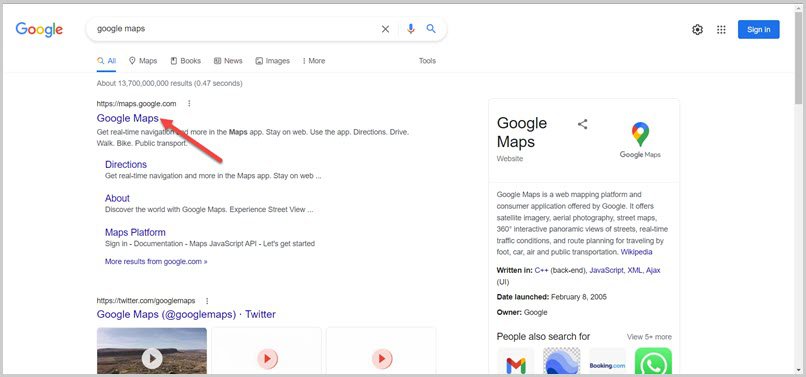
Step 2: Plot Your Road Trip Route
To start plotting your road trip route, click on directions.
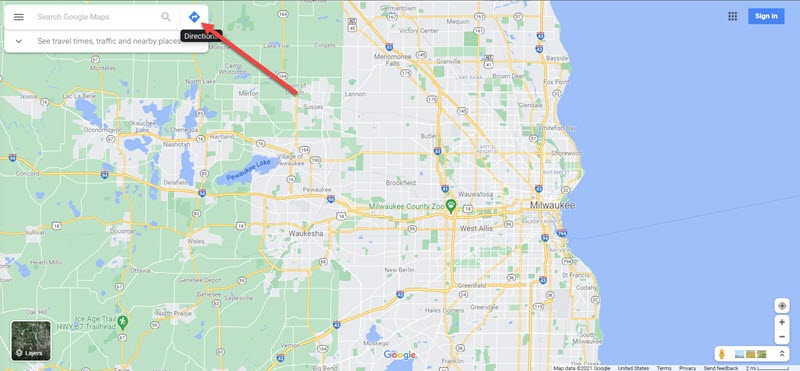
Then enter your starting point and your first destination.
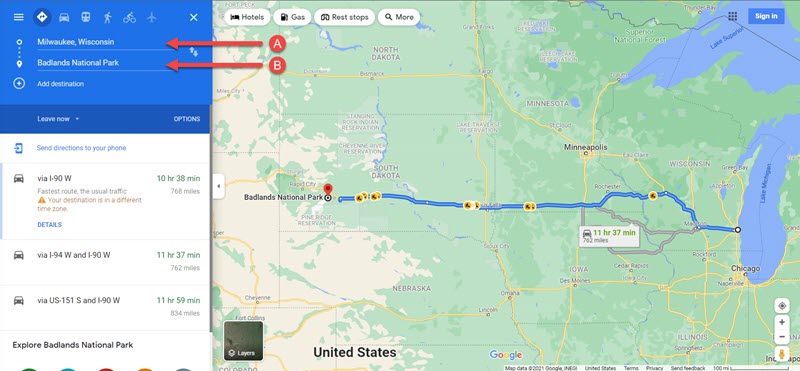
Continue to add stops to your road trip by clicking on the (+) to add destinations.
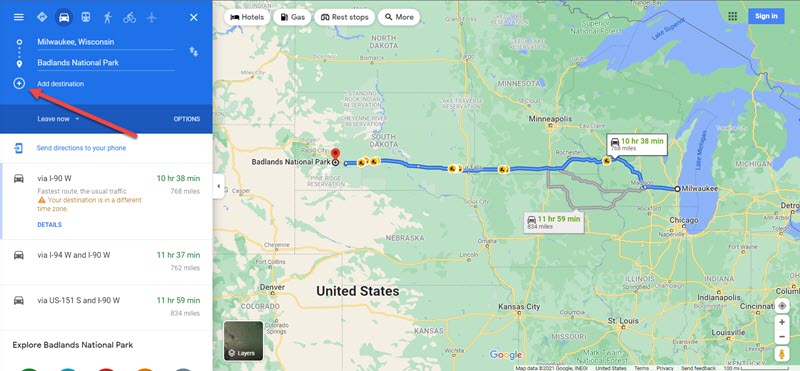
Stop when you have all your road trip stops added to your map. Google Maps allows you to add up to 10 points to your map. If you want to add more, then Google My Maps is the tool for you.
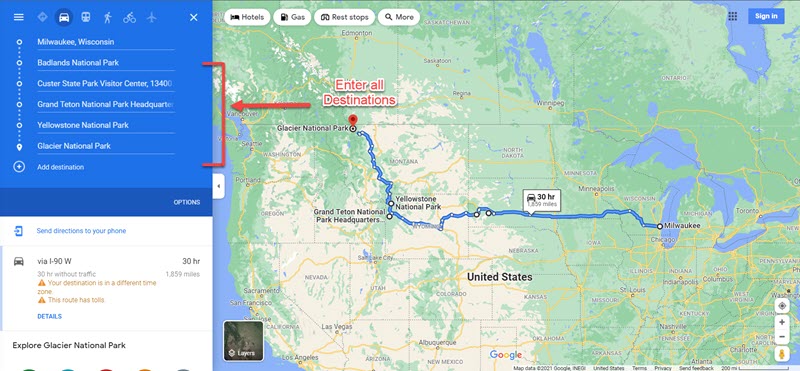
Step 3: Reorder Road Trips Stops
If you want to play around with your route and reorder your stops, Google Maps makes it easy to do so.
On the left, where your stops are listed, you can drag and drop the stops to reorder them.
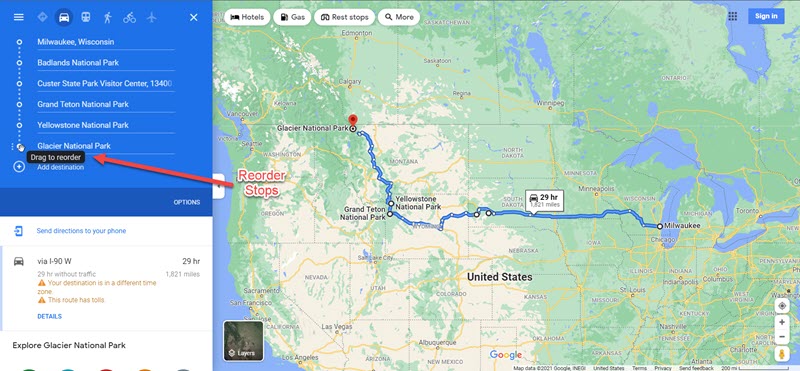
Step 4: Move the Driving Route
Google Maps will choose the fastest route between your road trip stops. But sometimes, there may be a scenic route you want to take.
You can easily move your driving route as desired by dragging and dropping your route.
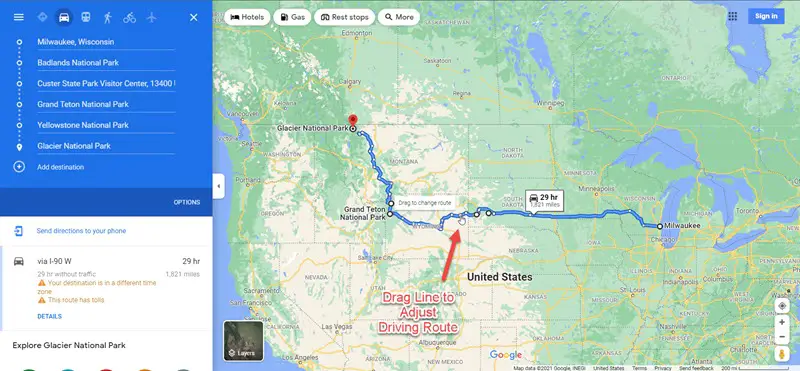
Step 5: Send the Driving Route to Your Phone
Once you plan your road trip, you can send the directions to your phone for easy access during your trip. Directions can be sent via text message or email.
Note: You will have to have a Google Account to send directions to your phone.
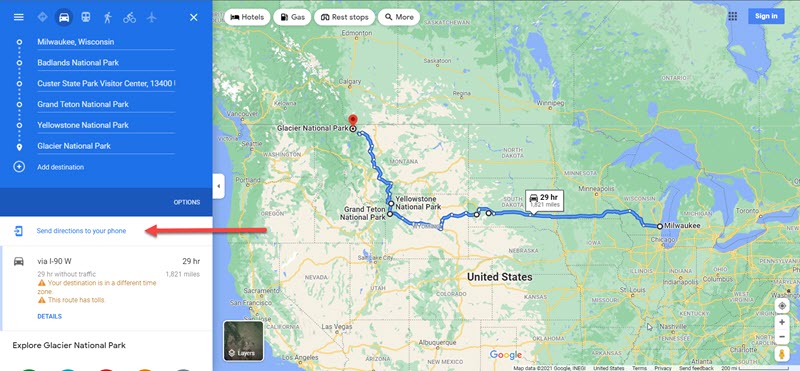
Google Maps is a great starting point for planning a road trip.
But if you want to harness the power of Google and use it to plan your road trip and as a resource throughout your trip, Google My Maps is the choice for you.
Google My Maps: The Best Road Trip Planning Tool
Planning a road trip can be a daunting task. It’s hard to know where to start, and all the research can feel overwhelming. But that is where the ultimate road trip planning tool, Google My Maps, comes to the rescue.
Google My Maps is a very similar tool to traditional Google Maps, but it’s much more powerful and customizable.
In this section, we’ll start with detailed information on the features of Google My Maps. And then, we’ll get into exactly how we use Google My Maps to plan each one of our road trips.
Using this tool will help you seamlessly organize and plan your road trip.
Once we tried it, we never looked back.
Let’s start by giving you a little introduction to Google My Maps.
What is Google My Maps?
Google My Maps utilizes all of the data in Google Maps to allow you to create your very own custom map for your road trip. It’s a way for you to create a map containing the places important to you .
Once you create your map, you can access all of the personalized information you’ve added, so you never miss a beat while on the road.
Why is Google My Maps the Ultimate Road Trip Planning Tool?
Google My Maps is our favorite tool for planning a road trip. Here is why:
- It Helps You Visualize Your Trip Plotting all of your points of interest on a map helps see how your road trip may take shape. At the start of road trip planning, we typically have no idea what route we may take until we see all of the things we want to do on a map. And this is where Google My Maps can help.
- It Helps Organize Your Research When planning a road trip, you are likely gathering information from many sources, including websites, tourist bureaus, and recommendations from friends and family. Google My Maps can help you organize all of your research so you can more easily plan your road trip itinerary.
- It Consolidates Your Entire Itinerary Using Google My Maps allows you to have all of your road trip information in one place. There will be no need for a separate spreadsheet with your day-to-day itinerary or to bring your travel books with you.
What Are the Limitations of Google My Maps?
- Google My Maps Can Not Be Used Offline You will need access to wifi or cellular data to use your map on your road trip. But don’t let that stop you from using it to plan your road trip. There are ways to download your map to other apps for offline use, which I’ll take you through in the tutorial.
- You Can Only Add 2,000 Locations to Your Map Likely, you will not need over 2,000 locations when planning your road trip. And if you do, you can make separate maps, possibly divided by days or weeks, to get around this limitation.
- You Can Only Add 10 Layers to Your Map Layers are ways to categorize your location points. When using Google My Maps, you can only have ten layers per map.
- Planned Routes Can Not Be Accessed for Driving Directions on Google Maps When planning your trip, you may add a direction layer on your map to display the route you plan to take. Unfortunately, you can not use those directions to give you turn-by-turn navigation on your road trip. You’ll have to use Google Maps or click on a destination point on your custom Google My Map to bring up directions. I go through this in detail here .
How to Use Google My Maps to Plan a Road Trip
Now that you know why Google My Maps is the best road trip planning tool, let’s dive into the nuts and bolts of Google My Maps.
We’ll start with an in-depth overview and then show you exactly how we use Google My Maps to plan our road trips. Use the screenshots I’ve provided to help guide you through all of the steps.
Overview of Google My Maps
If you want to know how we use Google My Maps to plan our road trips, then feel free to skip down to the step-by-step guide for planning a road trip here .
But if you want to learn the ins and out of Google My Maps, this is where to start.
You can start from the beginning or jump to the section you want to learn more about by clicking on the links below.
Here is what we will cover to familiarize you with how Google My Maps works so you can start road trip planning like a boss.
Google My Maps Layout
- Markers/Locations
Google My Maps allows you to add locations and driving directions to your map while allowing you to organize them as you wish.
To get started, let’s get familiar with the layout of Google My Maps.
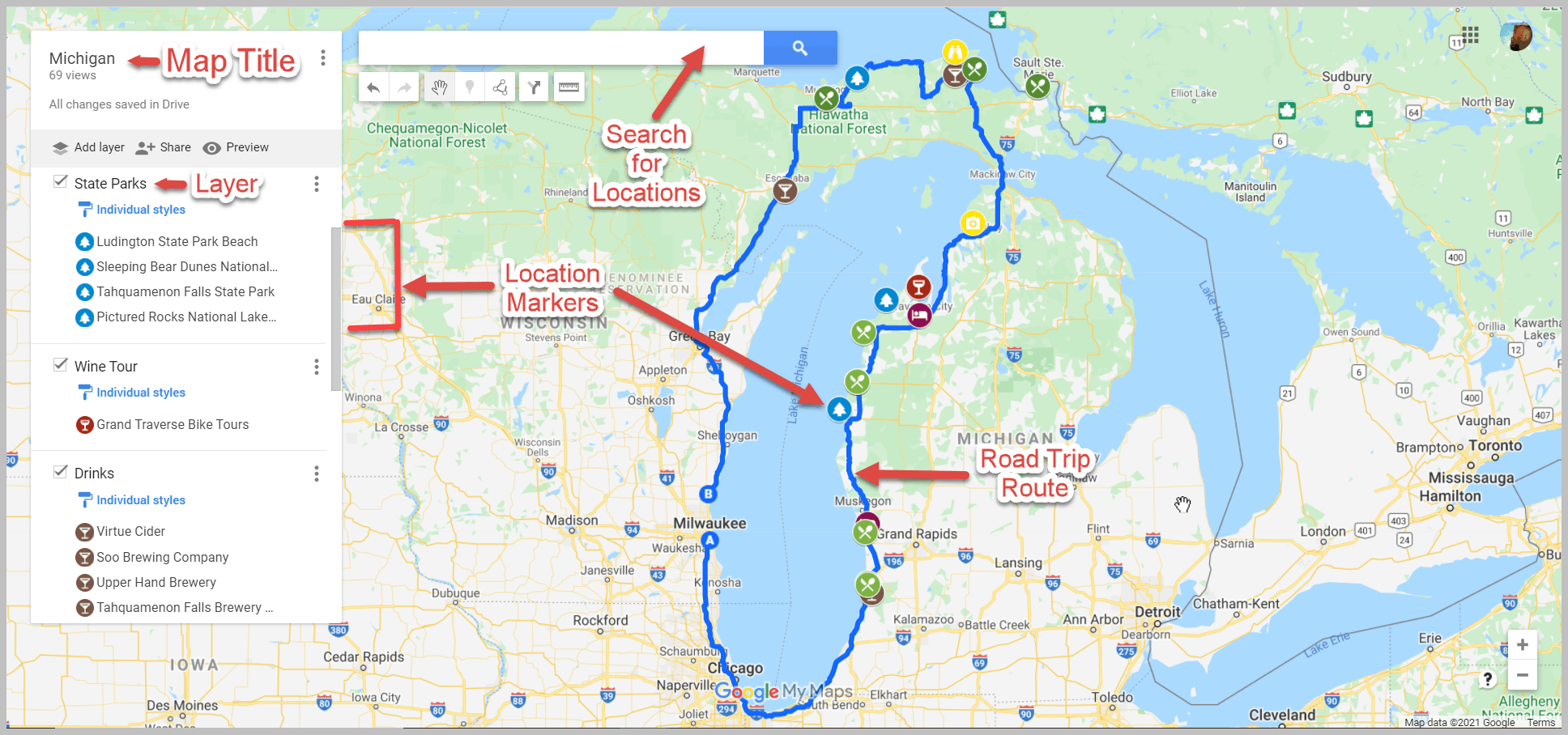
I suggest creating your first Google My Map and playing around with the functions of the map to help you get familiar with them.
Note: You must either create a Google Account or sign in to your Google account to start using Google My Maps .
Location Markers
Location markers are points that you add to a map. They can be things like restaurants, hotels, sights-to-see, bathroom stops, etc.
Find things to do along your route with our Favorite Tools to Find Things to Do Along Your Road Trip Route .
Each point you add to a map will include any information that Google already has for that point.
These include things like:
- GPS coordinates
- Website address
- Phone Number
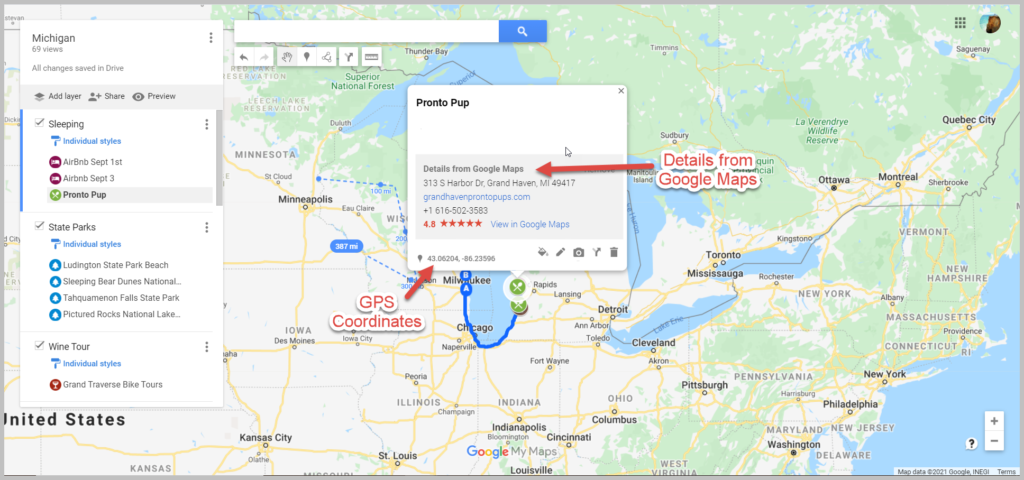
Three Ways to Add Markers to Your Google My Map
You can add markers to your road trip map in three ways:
- Using the search function
- Selecting a Point already on Google Maps to add to your own map
- Add a point manually
Let’s look at how to do all three.
Search Function
You can find a marker by typing in the name, address, or GPS coordinates into the search bar.
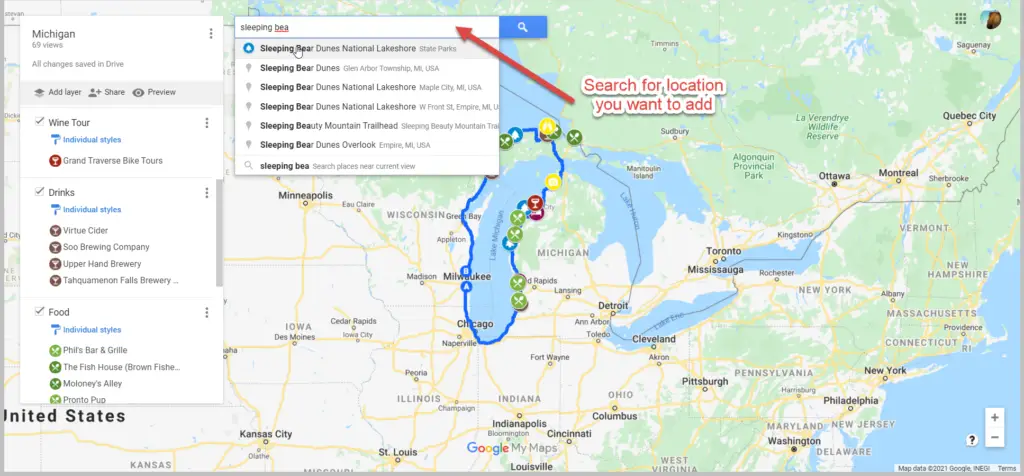
Adding a Marker That is Already on Google Maps
Google Maps already has many markers in its database. When you zoom into an area, many points of interest will start to show up. If any of these markers look appealing to you, you can add them to your own map by clicking on them.
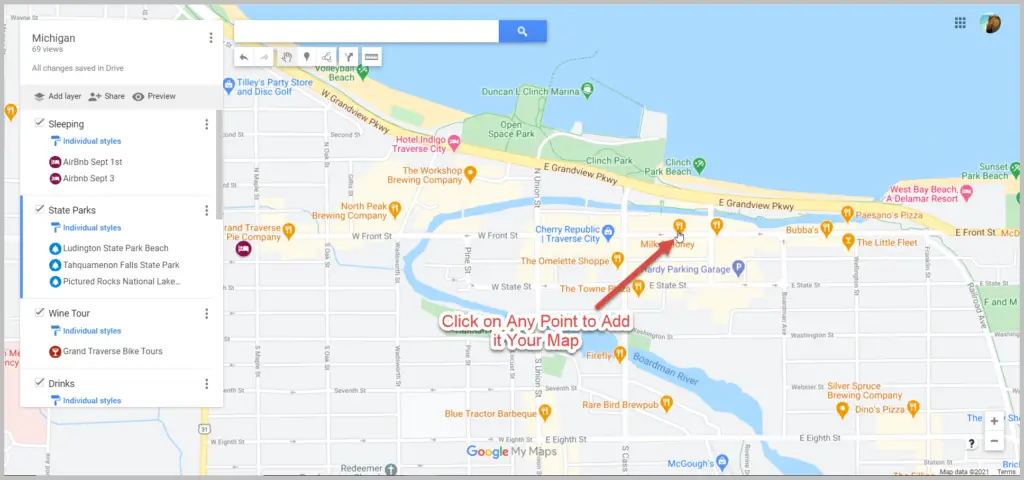
Adding a Marker Manually
You may need to add markers manually when you can not find them via the search function and don’t have the location’s GPS coordinates.
For example, sometimes, I struggle to find the exact location of a trailhead via the search bar. In these cases, I find the location of the trailhead via a different resource and plot it on the map myself.
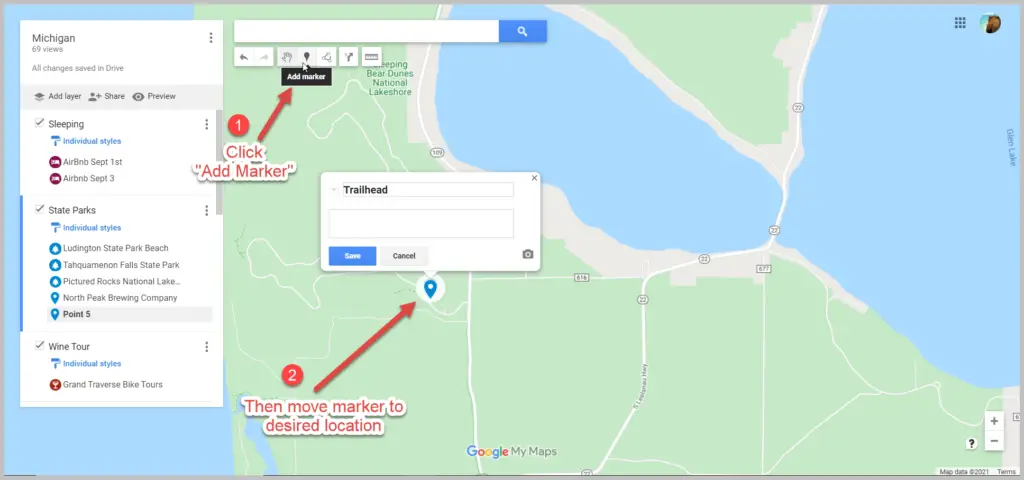
Color Code and Change the Icons of Your Markers
To keep your map organized, you’ll want to customize and color-code your icons to help you group locations together.
Luckily, Google lets you fully customize your markers.
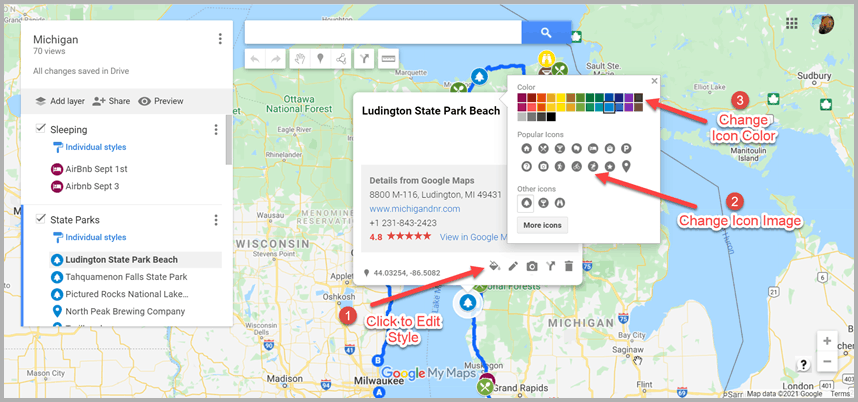
Map layers are a great way to organize your maps.
But before we dive into adding layers, let’s talk about map layers.
What are Map Layers?
A map layer is a set of markers that are layered on top of an existing map. You can see your different layers on the left-hand side of your map.
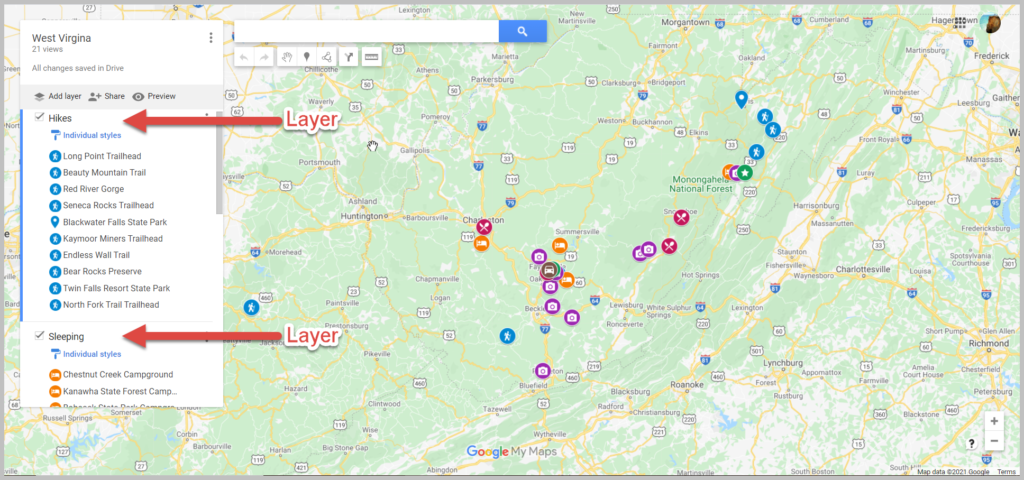
When you add a marker to a map, Google My Maps will add it to a layer. You can then use these layers to organize your map.
The added marker will appear on the selected layer. If you want to move a marker to a different layer, click and drag that marker to the desired layer.
For example, I made a map of Wisconsin Campgrounds to help me find campgrounds nearby during our road trips.
I have chosen to use separate layers for different types of campgrounds; National Forests, State Parks, and County Parks.
The benefit of using separate layers versus adding all of the campgrounds to a single layer is that I can check and uncheck specific layers depending on what information I want to see on my map.
If I don’t want to see the State Parks on my map, I can uncheck “Wisconsin State Parks,” and they will not be plotted on my map until I recheck the box.
How to Add Layers
Within Google My Maps, you can have up to 10 layers on a single map.
To add layers, click on “add layer” on the left-hand side of your map just below the map title and description.
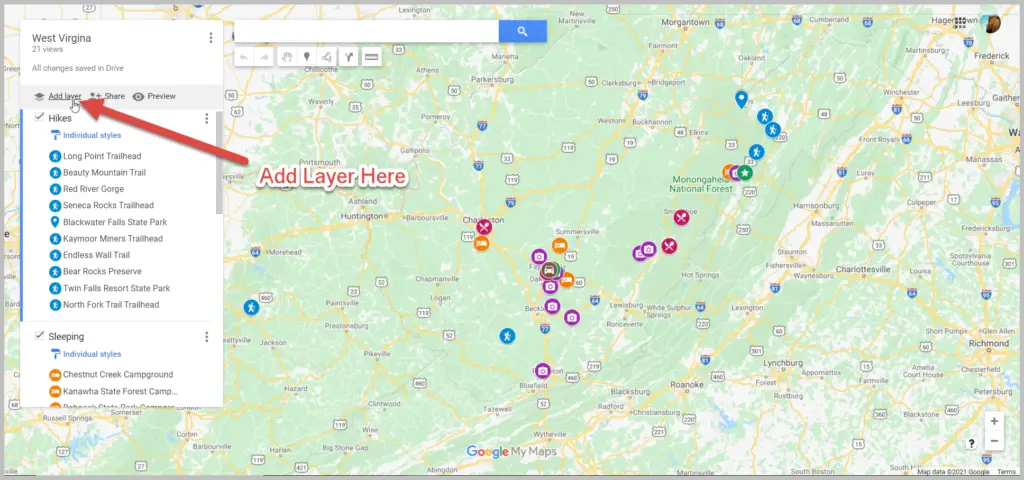
Google My Maps then adds an “untitled layer” to your map.
To change the title, click on “Untitled layer,” and it will give you the option to rename the layer.
The current layer selected will have a solid vertical blue bar on the left side of the layer panel. Any new markers created will be added to the selected layer.
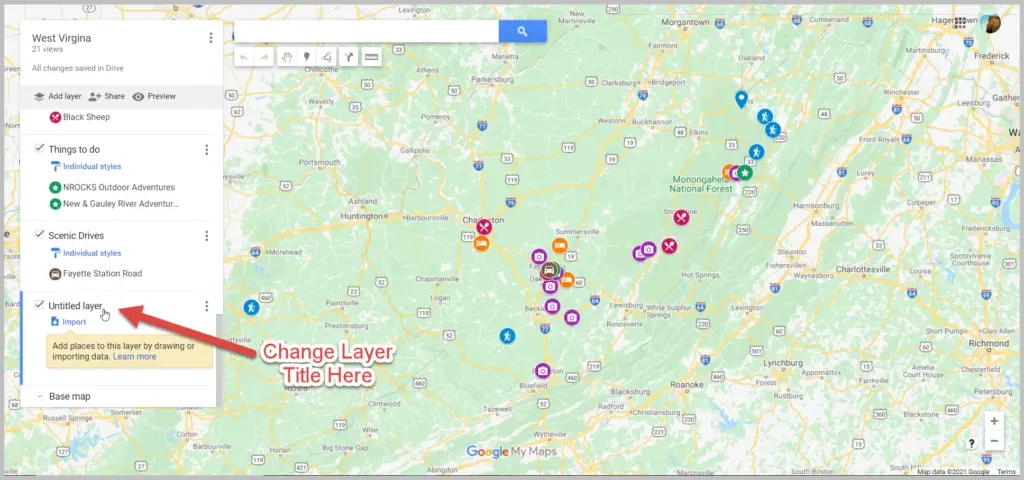
You can use Google My Maps to plot your driving route. Unfortunately, you can’t use these routes for navigation in Google Maps. This is one of the downfalls of Google My Maps.
But that is not to say that adding driving directions to your Google road trip map isn’t helpful. Adding driving directions helps you visualize your route so you can better understand where you are going while on your road trip. It also will help you figure out how long you can drive in one day .
Here’s how to add and use Directions on your Google Map:
Start by clicking on the direction icon located below the search bar.
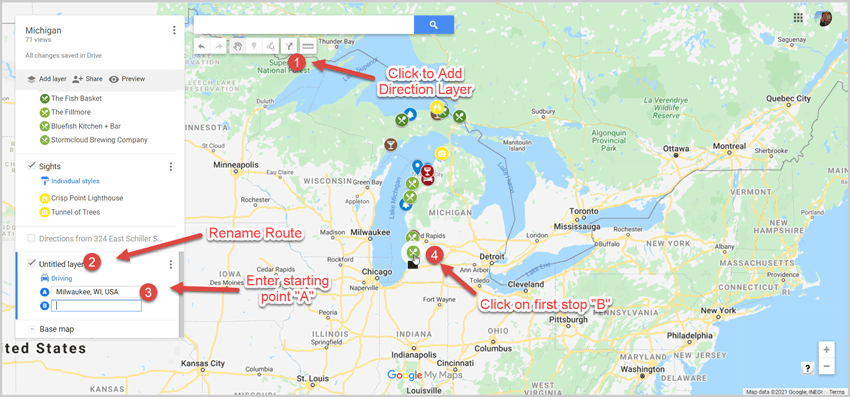
You will then continue to add stops along your route to get a visual of your driving route.
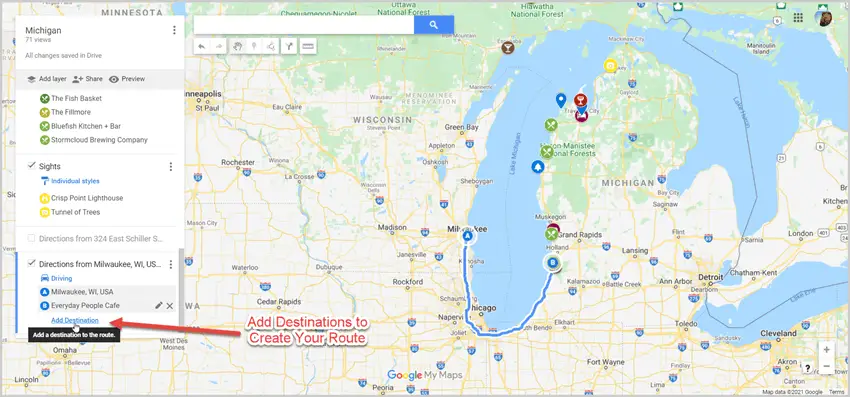
Google Maps will default to the quickest route when creating your driving route. The quickest driving route will likely be the main highways and not always the most scenic. Therefore, there may be times you want to deviate from the quickest route and take a more scenic route.
Fortunately, you can adjust your route by dragging it to where you want it to go.
Start by clicking on the route, and a small circle will appear.
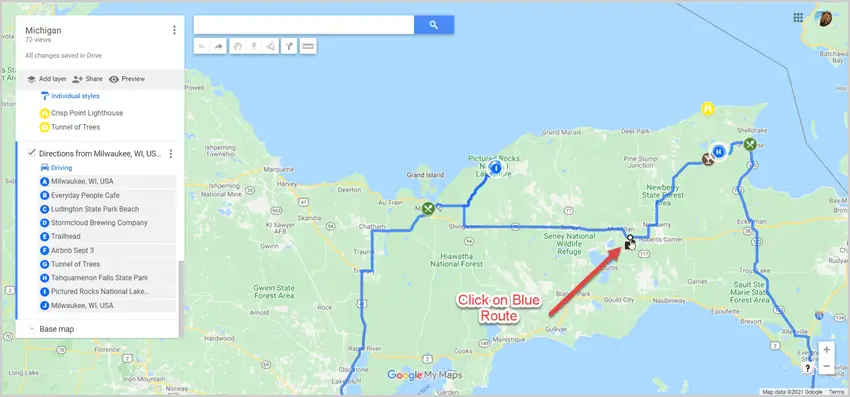
Then drag this route to where you want the route to go.
How to Plan a Road Trip with Google My Maps – A Step-by-Step Tutorial
Now that we know the ins and outs of Google My Maps let’s learn how to use it to create your very own customized road trip map.
- Create a New Google Map
- Add Layers for Different Types of Locations
- Add Locations to Your Map
- Plan Your Road Trip Route
Step 1: Create a New Google Map
You will need to sign in to your Google Account or create a new account to create your own Google My Map.
Once you’re logged into Google, follow this link to bring you to Google Maps .
Click on the hamburger ( 𝄘 ) in the top left-hand corner of Google Maps.
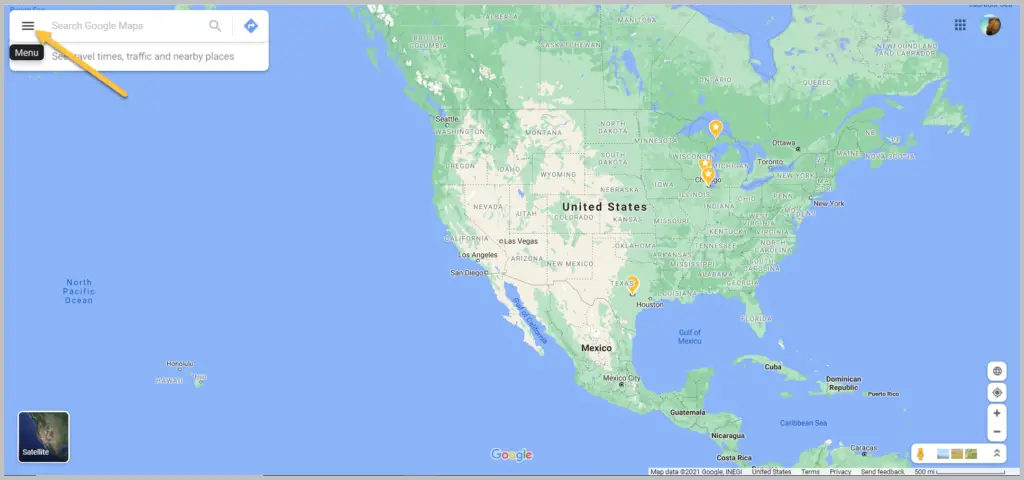
Click on “Your Places”.
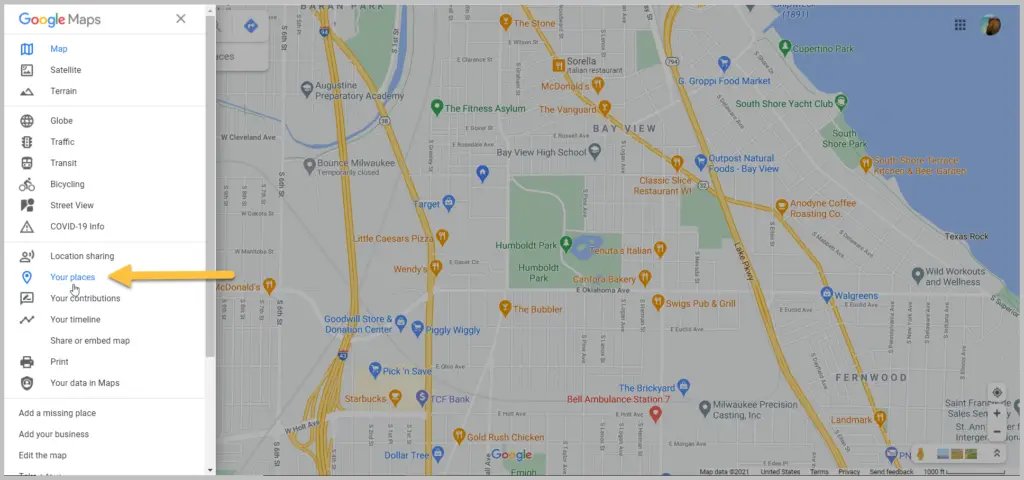
This brings up any saved information you’ve stored in Google maps, like your favorites
Now it’s time to bring up your very first map.
Click on Maps on the top left →, then click “create map” on the bottom left.
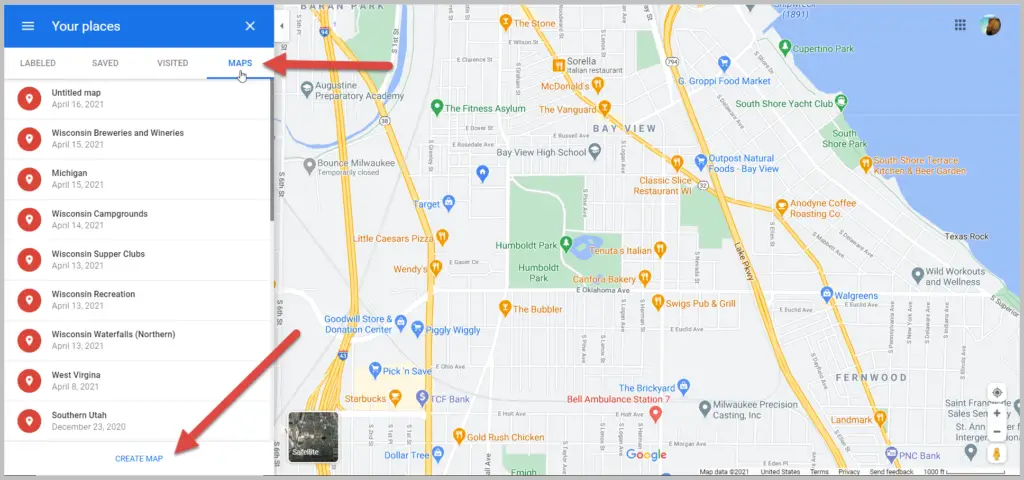
You now have your blank map!
Give your map a title, and get ready to create your first custom road trip map.
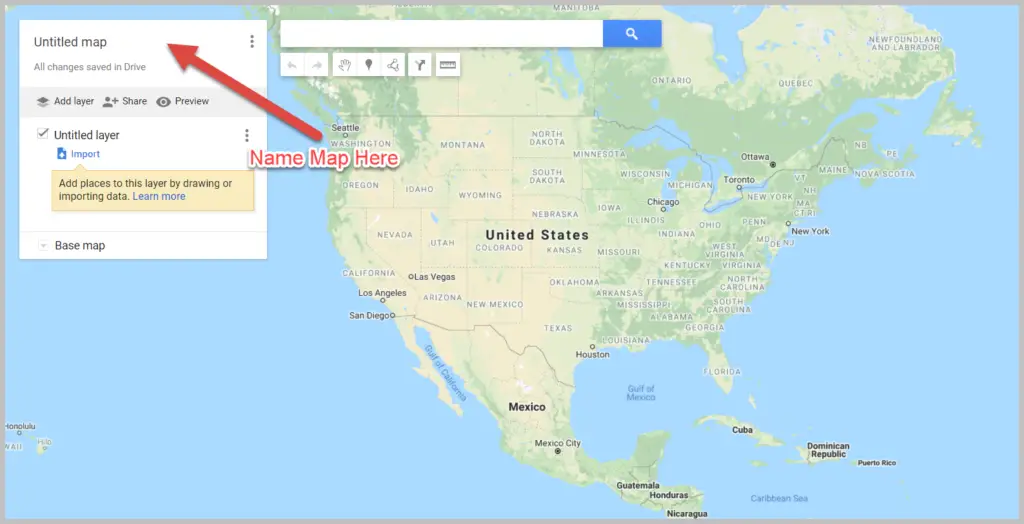
Step 2: Create Layers for Different Types of Markers
I like to start trip planning by creating different layers for the types of markers I plan to add to my map.
The layers I typically use are: – Places to Sleep – Places to Eat – Places to Drink – Things to Do
You can always add layers while you plan. But I find it easier to stay organized if I start with some layers on my map before adding locations.
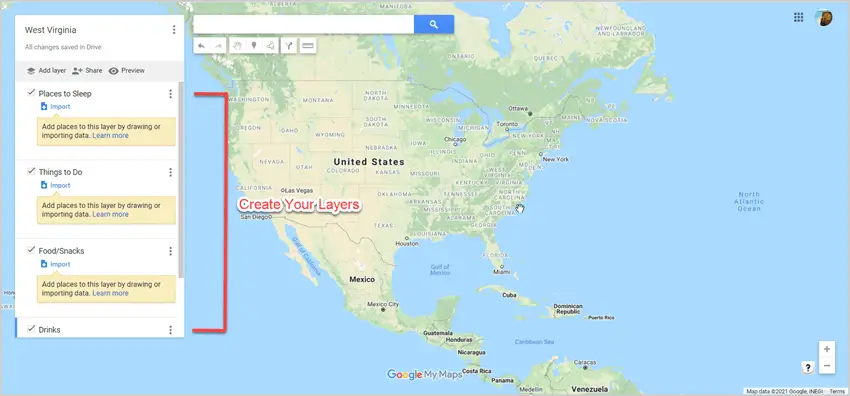
Step 3. Add Markers to Your Map
This is the best part of planning your road trip with Google My Maps.
Whether you are in your brainstorming stage of travel prep or you already know where you want to go, this step is where your trip starts to come together.
To start, you’ll research your destinations to find markers to add to your map.
I like to use the following resources for trip research:
- Google: Search for things to do, places to eat, places to stay, etc., in the areas you plan to visit or pass through
- Visitor Centers: Find tourism information online or request info from your destinations’ tourism bureaus to be mailed to you
- Travel books: We like to get ours from the library
- Facebook groups: Join a Facebook Group for the area you are traveling to. They are filled with tons of suggestions on the best things to do in the area.
When you find a location you want to make note of, add it to your map.
Do this by entering it into the search bar.
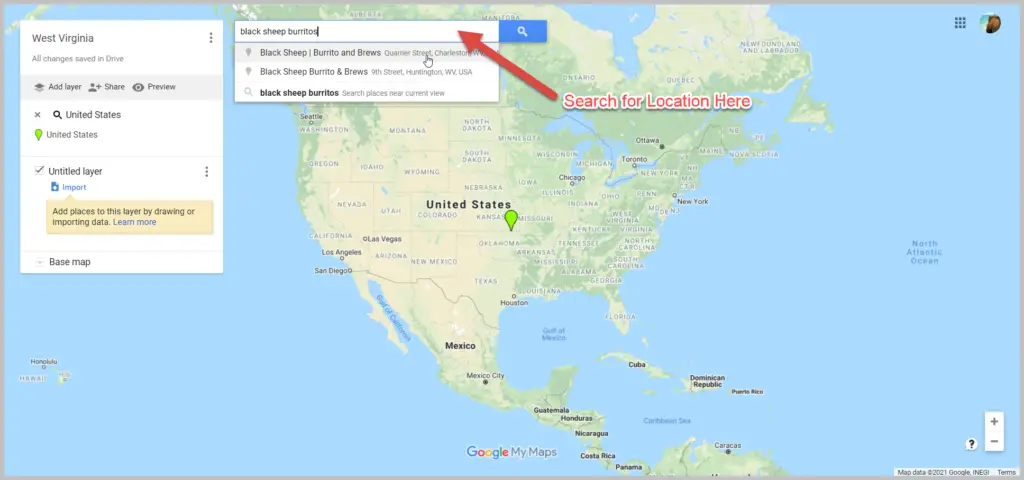
The great thing about Google Maps is that it pulls up all of the information on a location that Google has. If available, you can find the exact address, reviews, and website address.
If the location looks good, you can then add it as a marker to your map by clicking “add to map”.
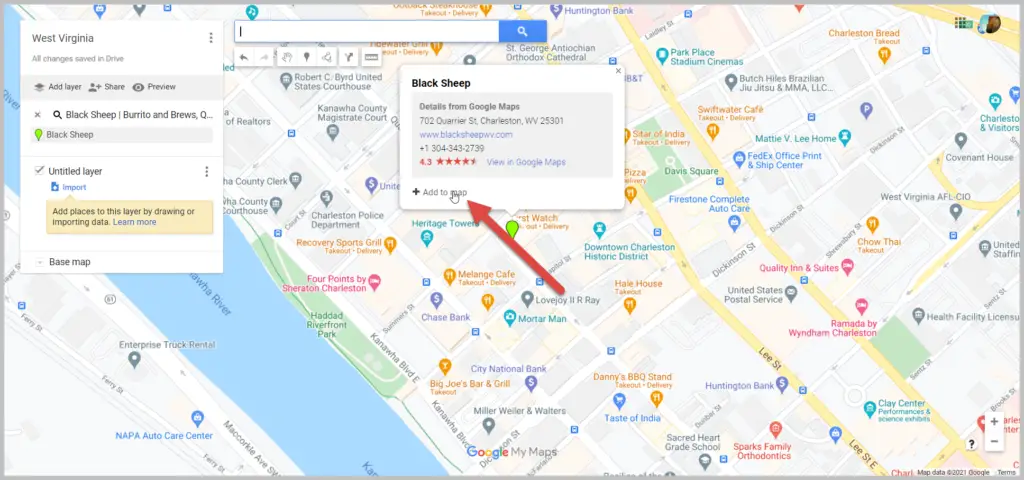
Once added to your map, you can customize your marker by changing your icon’s color and/or shape by clicking on the paint bucket icon labeled “style”.
I like picking a specific color and icon for each marker category. For example, my “restaurants” may all be blue with a fork and spoon icon, while my “sights to see” will be yellow with a binocular icon.
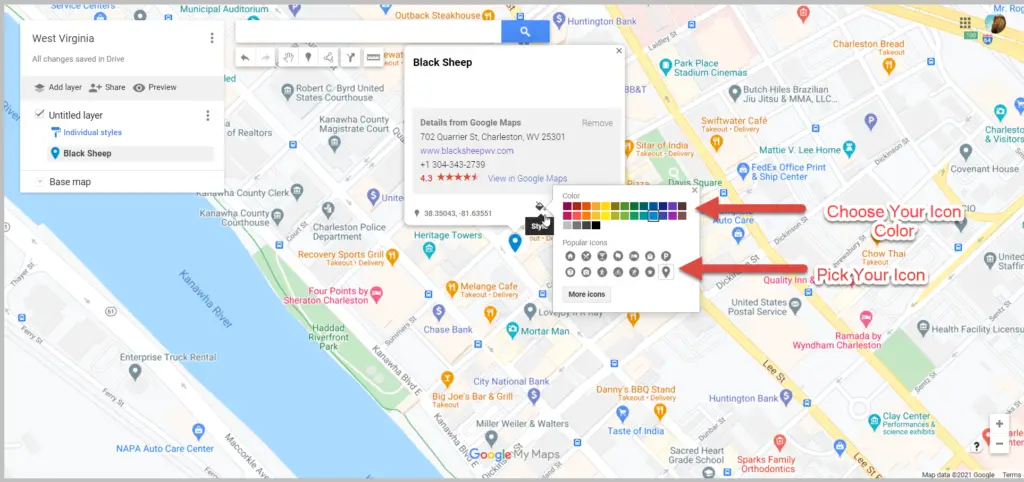
One of my favorite features of Google My Maps is that I can add my own info to the marker. Typically, this info comes from the research I’ve done on the location. If I found a blog post recommending a specific restaurant, I’ll add that to the marker, so I have that info at my fingertips when we are on the road.
Add any info you want to your marker and click save.
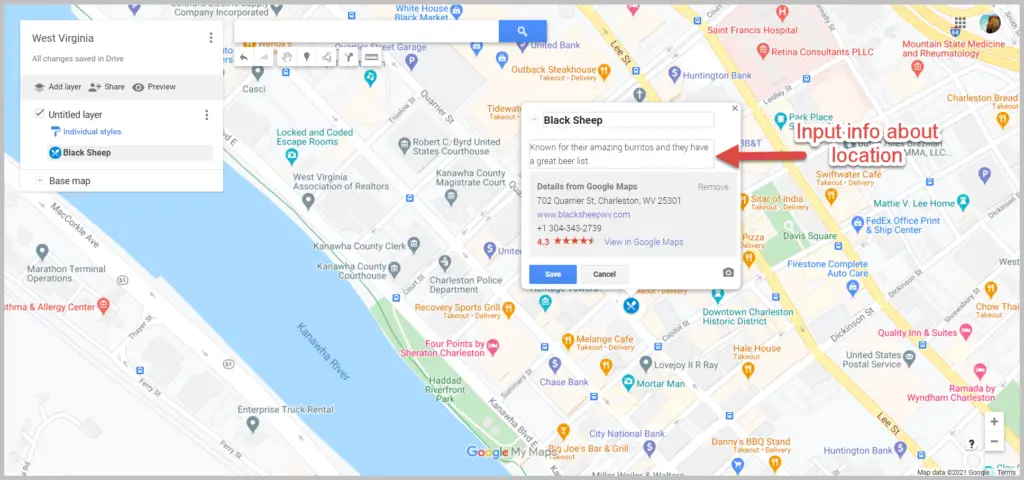
Your marker will now be added to your map.
You can see your marker in two places: one on the map and the other in the layer it was added to in the layers menu on the left-hand side of the screen.
Continue to add locations until your map starts to take shape.
Here is an example of a map we made for a West Virginia Road Trip .
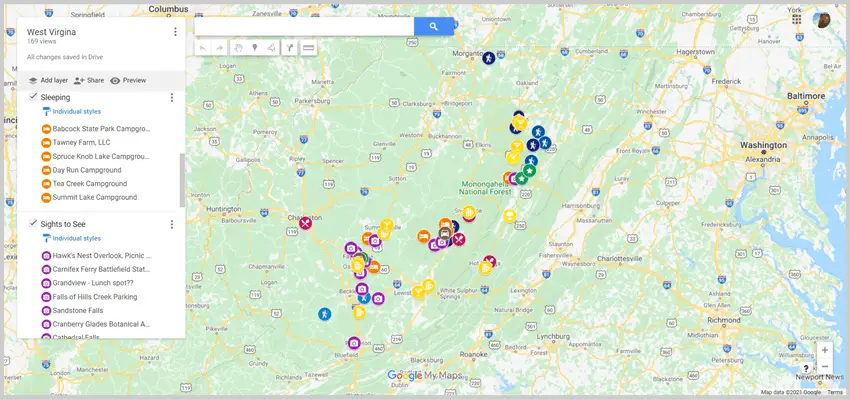
Step 4: Determine Your Route / Itinerary
Now that you have location markers on your map, you can determine your route and day-to-day itinerary.
Take a look at where all your location markers are situated and start planning your route.
Start by creating a directions layer on your map.
Once you have your directions layer, rename it, and begin plotting your route.
First, you will need to enter your starting point. This can be done by either entering an address manually or clicking on a marker on your map.

Continue to add stops until your route is complete.

Here is an example of what our Lake Michigan Circle Tour Road Trip looked like.
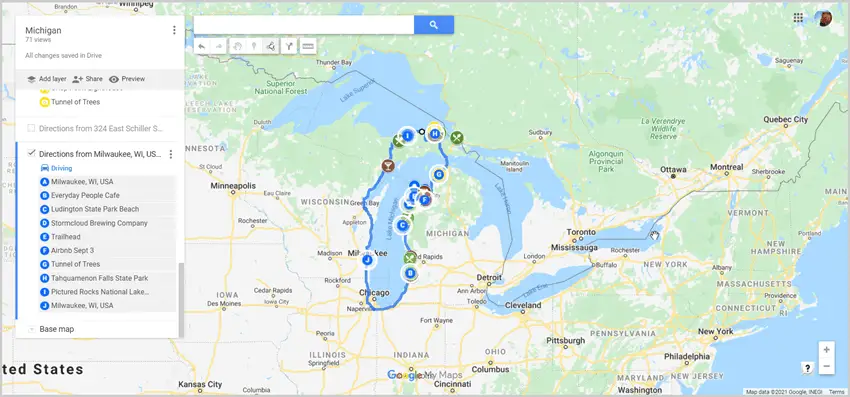
Google Maps will default to the quickest route from two points. If you want to go a different route than the one suggested, you can drag the route to force it to go a different way than it was originally displayed.
You now have your own customizable Google Map for your road trip.
We use these maps for both planning our trip and for reference during our trip.
Now let’s look at how to use your awesome map during your trip.
How to View Your Google My Map on Your Phone
Now that you have your map customized, you’ll likely want to be able to view it on your phone.
You will first need to download the Google Maps app from your phone’s app store.
Once you have the Google Map app, here is how you access your map:
- Click on “Saved” on the lower toolbar on your phone
- Click on “Maps” on the lower right
- Select your customized map
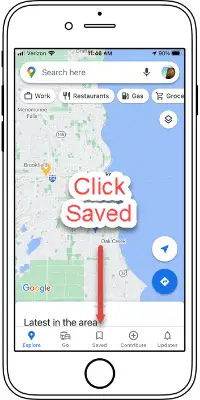
Now you can view your location markers and all the customized information you added to your map.
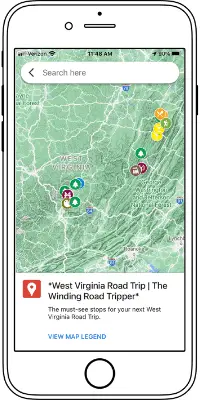
Click on your marker to bring up basic information. For the more detailed information you added, swipe up.
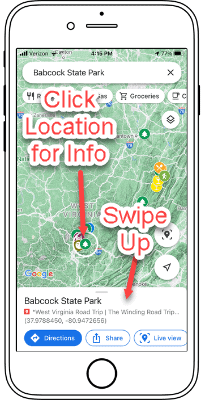
How to Use Your Google Map to Get Directions During Your Road Trip
Unfortunately, you can’t use the turn-by-turn directions you may have added to your map for actual driving instructions for your trip.
But not all is lost; you can still get directions to the next stop by using your customized map and Google Maps.
To do this, click on the location you want directions to and click on directions.
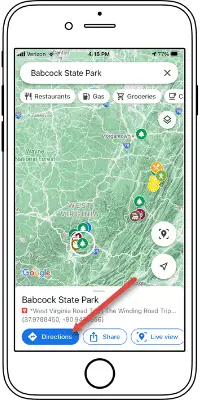
This will launch your Google Map app and allow you to get turn-by-turn directions to your next stop.
How to Export Your Map for Offline Access
Google My Maps works great when you have cell phone service on your trip. Unfortunately, you will not always have service, and you can’t download your Google My Map for offline use like you can in Google Maps.
Thankfully, there are ways to export your map for use offline.
To do this, we use Gaia GPS .
Let’s walk you through downloading your Google My Map for importing into Gaia GPS, an offline mapping app.
On your computer, click on the ( ⋮ ) in the top left corner by the map’s name. Then click on Export to KML/KMZ.
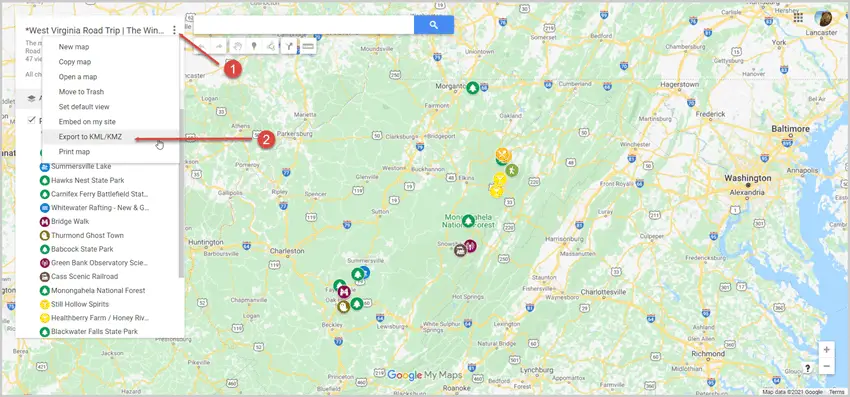
A pop-up will appear. Keep the default of “entire map” and click “download”.
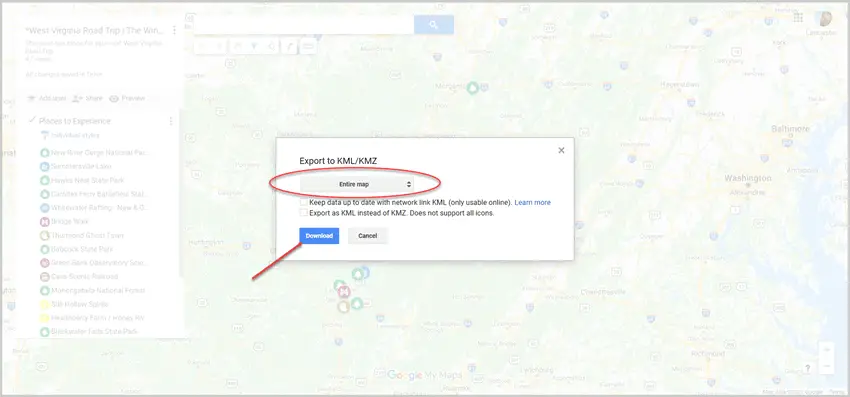
Now you can import this map into Gaia GPS.
Start by creating a Gaia GPS account .
Once logged in, click “Import Data” and select the .KMZ file you downloaded from Google My Maps.
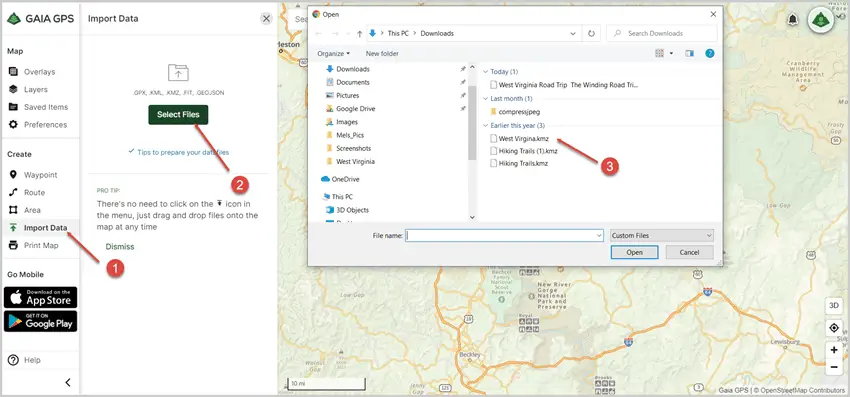
Your locations will now populate in your Gaia GPS map. Make sure to click “save” .
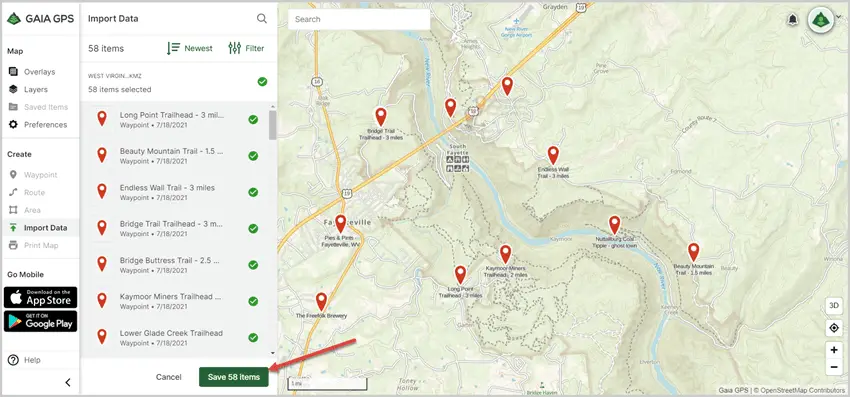
You can now access your map locations offline on your phone via Gaia GPS.
To do this, download the Gaia GPS App on your phone and log in.
Once logged in, you will see a notification that you have a saved location available.
Click on the Saved folder
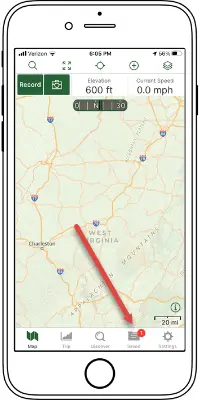
You can now see all your locations on your Google My Map. Including the details, you added.
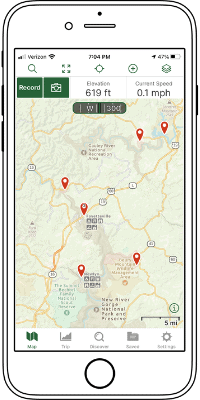
More Road Trip Tips: Road Trip Hacks for a Stress-free Trip Road Trip Activities for a Long Car Ride Road Trip Meal and Snack Ideas Money-Saving Tips for Your Next Road Trip How to Budget for a Road Trip
How to Save a Route on Google Maps on Any Platform
Whether you're using Android, iOS, or the good old web, you can save your Google Maps route for when you need it next.
Key Takeaways
- Save routes on Google Maps for quick and easy access without re-entering information, avoiding congested roads and reducing traffic congestion and fuel consumption.
- You can save Google Maps on iOS, Android, and in your web browser for easy access.
- Furthermore, you can customize your travel experience by adding routes to your home screen and saving entire trips using Google's MY Maps feature.
Not everyone is good with directions. Thankfully, Google Maps guides you through unfamiliar areas and finds the best route. What's even better is you can save routes on Google Maps to access them later easily, no matter if you're using Android, iOS, or the web.
What Are the Benefits of Saving Routes on Google Maps?
Saving a route on Google Maps offers many benefits:
- Quickly access used routes without re-entering the same information every time
- Avoid clogged roads and construction zones
- Reduces traffic congestion and fuel consumption
Google Maps uses these saved routes to enhance routing algorithms and generate live traffic data. Overall, saving routes on Google Maps benefits not just you but others, too.
How to Save a Route on Google Maps for Android and iOS
If you don't have Google Maps, download it from the App Store or Google Play Store. After that, open the app and sign in using your Google account .
Download: Google Maps for Android | iOS (Both free)
In the top search bar, type the location you wish to visit. After that, tap the blue Directions button and add your starting point. If you want to change your transportation mode, tap the bike or car icon. Walking mode does not allow you to save routes.
Google Maps will suggest different routes with estimated travel times and distances. Select the route you'd like to save. Now, at the bottom of your screen, tap the Pin icon. You will see a message confirming that the route has been pinned.
To see your saved routes, head to the Google Maps home page and tap the Go tab. On this page, you will see all the saved routes alongside their estimated time and distance. Now just find the route and click Start . Google Maps will provide traffic updates and guide you along your chosen route.
You can remove a saved route you no longer need. For this, open the Google Maps app and navigate to the Go tab.
Now locate the route you want to delete and tap on it. In the bottom right corner, click the Pinned icon. Doing so will remove the saved route from your list.
How to Save a Route on Google Maps on the Web
If you're using Google Maps web, the route-saving process differs slightly. First, open your web browser and head to Google Maps. Sign in to your Google account if you aren't already.
To start, locate the Search Google Maps field at the top of the page, click on it, and type your destination's name or address. Press Enter , and Google Maps will highlight your destination on the map. Next, click the Directions button in the left pane to open the directions interface.
Afterward, type in your starting point in the first field that says Choose starting point and press Enter. Google Maps then calculates the route and provides a few options. Review these options and select the one you prefer. To save this route, look for Send directions to your phone next to your selected route.
Click on it, and a pop-up will appear. In this pop-up, select the device to which you want to send the directions.
You will receive a notification on your phone. Open this notification, and you will see the route on Google Maps. Now, to save this route, tap the Pin icon as we did in the previous method for mobile devices.
If you don't have your mobile device on hand, you can still save the route on your PC. In the Send directions to your phone pop-up, choose Email to yourself instead.
This will send the route link to your email, which you can access later on your phone or other device.
How to Add Routes to Your Home Screen for Quick Access
So far, we've covered how to save a route on Google Maps. But what if you want even quicker access to your saved routes? Well, Google Maps has a solution for that. You can add routes to your home screen and access them with one tap.
This feature is only available on Android devices. So, if you're an iOS user, you may skip this section.
To add a saved Google Maps route to your home screen:
- Open the Google Maps app and navigate to the Go tab.
- Select the route you'd like to add to your home screen.
- Tap the three vertical dots icon in the upper right corner.
- From the options, choose Add route to Home Screen .
- A pop-up will appear asking for confirmation. Click Add to confirm.
Now you have the route icon on your home screen. You can drag and place it anywhere for easy access.
How to Save Google Maps Routes for Long Trips
When planning a long trip with multiple stops, it's more convenient to save the entire trip instead of individual routes. One way to do this is by using Google's MY Maps feature.
To save Google Maps routes for a long trip, follow these steps. Open your web browser and visit Google My Maps . Click Create a New Map and give it a name. You can also add a description.
Next, click the Add directions icon at the top (it's shaped like an arrow indicating a turn).
In the left sidebar, add the first two stops of your trip.
Then click Add Destination to add more stops along the way. You can drag them up and down if needed.
Once you've added all your stops and routes, navigate to Saved > Maps in Google Maps. You will see your custom map with all saved routes and stops. Thus, you will have a comprehensive overview of your entire journey and can adjust accordingly.
Customize Your Travel Experience With Google Maps
Google Maps offers more than just directions - it elevates your travel experience. You can save routes, add them to your home screen, and create custom maps with all your stops and detours included. So, if you're heading on a long trip, let Google Maps be your trusted guide.
- PC & Mobile
- Google Maps
How to Save a Route in Google Maps
Lee Stanton Lee Stanton is a versatile writer with a concentration on the software landscape, covering both mobile and desktop applications as well as online technologies. Read more July 18, 2022
Device Links
- Device Missing?
Knowing how to save a route in Google Maps can be quite useful if you’re planning a trip. Not only does this feature allow you to plan your journey efficiently, but it can also prevent you from getting lost along the way. You can even download maps to view offline, so you don’t need an internet connection to see where you’re supposed to go.

In this guide, we’ll show you how to save a route in Google Maps on your phone and PC. In addition, we’ll answer some common questions regarding Google Maps routes.
How To Save Routes in Google Maps on Every Device
Even though you can plan and create your own routes in Google Maps down to the last detail, you can only save a route on your Android device. However, once you create a route on your PC, you can send the directions to your phone, where they can be saved.
To save a route on Google Maps on your Android device, follow the steps below:

- Go to Navigate in the bottom-right corner of your screen.

You can also save the destination. To do this, type in the direction in the search bar and tap on Save on the bottom toolbar. Google Maps will ask you whether you want the route to be saved in the following folders: Favorites, Want to Go, Starred Places, Bookmarks, or if you want to create a new list. When you want to open the map and start the route, simply open Google Maps and go to the Saved tab on the bottom toolbar.
If you aren’t happy with the route that Google Maps planned out for you, you can review other possible routes. When you choose the one that works best for you, just tap on it.
Google Maps is usually pre-installed on your Android, but if you don’t have the app and don’t want to install it, you can still use it on the web version. If you have an iPhone, you can download Google Maps and follow the same steps to save a route. Apart from your computer, you can also save a route in Google Maps on your tablet.
As mentioned before, you can’t save a route in Google Maps on your PC, but you can send it to your phone or any other device. Here’s how it’s done:

You should get a notification from Google Maps on your phone right away. Even though you can’t save a route in Google Maps on your PC, you can save the destination. This is how it’s done:

You can also create your own map in Google Maps’ My Maps . Here’s how it’s done:

You can select items, add markers, draw lines, measure distances, name the map, and write the description once you’re done. You can share it with whoever you want through a link or via Google Drive.
Additional FAQs
Does my google maps saved route ever expire.
When you save a route in Google Maps on your phone or tablet, it has an expiration date of 30 days. That’s why we recommend planning a route in the same month you’re going to go on a trip. However, routes are generally easy to create and save, so even if it expires, you can save it all over again in a matter of moments.
Travel Better With Google Maps
Now you know how to save a route in Google Maps on your phone and how to share a route from your PC. You also know how to customize a route and save a map so you can use it offline. Once you save all the necessary routes and maps, your journey can begin.
Have you ever saved a route in Google Maps before? Did you use the same method we went over in this guide? Let us know in the comments section below.
Related Posts

Disclaimer: Some pages on this site may include an affiliate link. This does not effect our editorial in any way.

Lee Stanton March 2, 2024

Lee Stanton December 22, 2023

Lee Stanton December 16, 2023
Send To Someone
Missing device.
Please enable JavaScript to submit this form.
How to Use Google Maps to Plan Your Next Road Trip (Step-By-Step Tutorial With Examples)
Post summary: A comprehensive guide on how to use Google Maps to plan a road trip itinerary and why Google Maps is the best tool/app for planning a trip. Includes a road trip planning tutorial!
Author’s Note: This post was originally published in 2020 and was updated in April 2023 for accuracy and comprehensiveness.
So, you want to plan a road trip. But, where do you start? Better yet: How do you start?
I’m often asked about my trip planning process. Where to go, what to do, and how exactly to fit everything into a cohesive itinerary that, well, makes sense .
Planning a road trip can be hard. But, with the right tools and resources, it doesn’t have to be. I’ve already put together a list of my most trusted travel booking resources , and the best apps for road trips , but now I want to talk about one of my favorite road trip planning tools: Google Maps.
Google Maps is like a trip planning goldmine, and it’s always my very first step in organizing my itinerary whenever I take a trip.
Google Maps is one of the best tools for planning a cohesive and successful road trip, because it allows you to create a highly customizable, visual representation of your trip (shoutout to all my fellow visual learners out there). And its FREE!
Basically, if you’re planning a road trip, knowing how to customize Google Maps is going to make your life so much easier.
So if you’re wondering how to get started, then you’ve come to the right place. I’m breaking the entire process down into an easy to follow step-by-step tutorial on exactly how to use Google MyMaps to plan your next road trip. So, lets get started!
GOOGLE MAPS TRAVEL PLANNING OVERVIEW
Here’s exactly what we cover in this guide:
- Create a new Google Map for your trip.
- Add location pins to your map
- Customize and color code your location pins.
- Create Google Map layers to plan your day-to-day itinerary.
- Add driving directions to your map.
- Download your custom Google Map to your phone.
- Share your map with friends.
- Calculate gas milage for your road trip.
Scroll down for a super detailed step-by-step guide to planning your own travel itinerary for free using Google Maps or skip ahead with the table of contents.
Table of Contents
Need some road trip inspiration? Visit my most popular travel guides:
Las Vegas to Sedona Road Trip (3 Jam-Packed Itineraries to See it All in Less Time)
5-Day British Columbia Road Trip Itinerary
1-Day Yoho National Park Road Trip Itinerary
The Perfect 2-week Costa Rica Itinerary
. Don’t forget to grab my FREE Travel Expense Planner Download below to help you plan your next trip . Use it to easily and automatically calculate how much money you’ll spend on gas, flights, accommodation, food + more
WHY GOOGLE MAPS IS THE BEST TRAVEL PLANNING TOOL FOR YOUR NEXT TRIP
Google Maps is the best tool for planning your next trip , whether you’re just using it for adventure inspiration, to share ideas with your friends, or creating a detailed step-by-step road trip itinerary. Here’s why!
IT CREATES A VISUAL REPRESENTATION OF YOUR ROAD TRIP
If you’re a visual learner, Google Maps is going to be your best friend. But even if you’re not a visual learning, using Google Maps to plan your trip is still going to be incredibly helpful.
Planning your trip with Google Maps is the fastest way to familiarize yourself with the layout of an area. It allows you to wrap your head around how large an area is and where everything is in relation to each other, which, in my opinion, is the best way to start planning any trip.
Here’s an example of the Google Map I created for our 4-day road trip in Iceland.
Click here to access the interactive map.
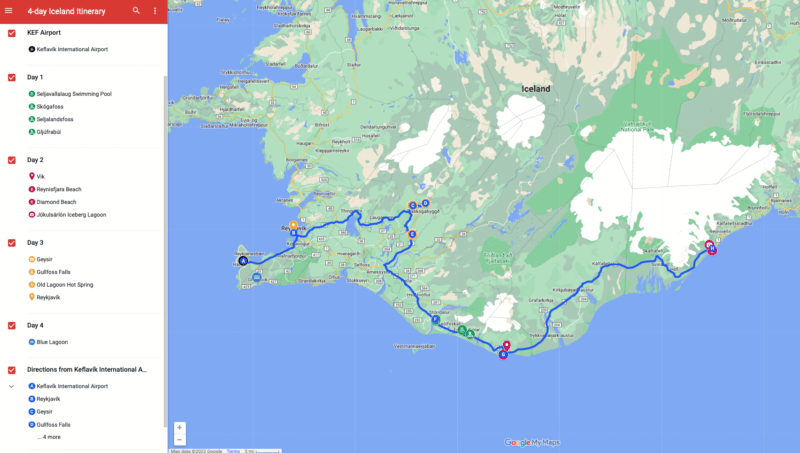
GOOGLE MY MAPS HELPS YOU FIGURE OUT WHERE TO SPEND YOUR TIME
Have you ever had a list of places you wanted to see, only to find out that they’re super far away from each other?
Pinning your locations to your custom Google Map will show you where your stops are. This will help you figure out where to spend your time and plan accordingly.
Are your pins clustered in one place? If so, then you might want to allocate more time to that area. Or maybe your pins are spread out all over the map? If this is the case, then it might be best to prepare yourself for a lot of driving or focus on a smaller area instead.
YOUR GOOGLE MAP IS HIGHLY CUSTOMIZABLE
Whether you’re touring NYC, road tripping cross country, or backpacking to Beaver Falls in the Grand Canyon , you can create a highly customizable Google Map to help plan your adventure.
Handy features like customizable locations, adding multiple stops, pinning by GPS coordinates, organizing by categories, and overlaying direction layers, all make it incredibly easy to customize your Google Map to plan your travel itinerary.
Need to remember entrance fees, operating hours, or best places to see? You can even add notes to your location pins so you don’t forget important details!
IT HELPS YOU NAVIGATE AND PLAN YOUR ROUTE
Quickly learn how to navigate between stops by adding directions between multiple locations to your map.
This is an incredibly useful tool for figuring out the best routes to take, roads to avoid, and to plan for drive time. You can even choose between walking, biking, or public transportation directions. This is especially helpful for choosing the best entrance to Yellowstone National Park , taking the scenic route on an Ecuador road trip , or mapping out the best Hudson Valley wineries .
IT’S EASY TO COLLABORATE AND SHARE YOUR TRIP
Traveling with friends? Google Maps makes it super easy to collaborate by allowing you to share your map with your travel partners. You can even give them editing access so that everyone can add their must-do’s to the map.
YOUR MAP IS EASY TO SHARE BETWEEN DEVICES
You’ll have to create your Google Map on desktop. But, luckily, you can seamlessly share your custom map straight to your iPhone or Android using the Google Maps App!
Sharing your custom map to your phone makes it super convenient to access your itinerary on the go. You can even set up your map for offline use if you’re traveling without cell phone service.
HOW TO CREATE A CUSTOM MAP IN GOOGLE MAPS: A STEP-BY-STEP GUIDE
1. create a new google map, login to google drive on your desktop.
Before you start planning your road trip using Google Maps, make sure you’re signed into your Google Drive.
- Visit www.google.com/maps from your desktop and log in .
- If you don’t have a Google Drive account, create one now.
CREATE A NEW GOOGLE MAP
To create a new map, select “Saved” in the sidebar on the left > “Maps”. You can also click on the menu (the three lines) in the upper left corner > “Saved” > “Maps”.
For now, your list is probably empty. But as you create more maps, this is where they’ll be stored.
Begin creating your first custom map by selecting “CREATE MAP”
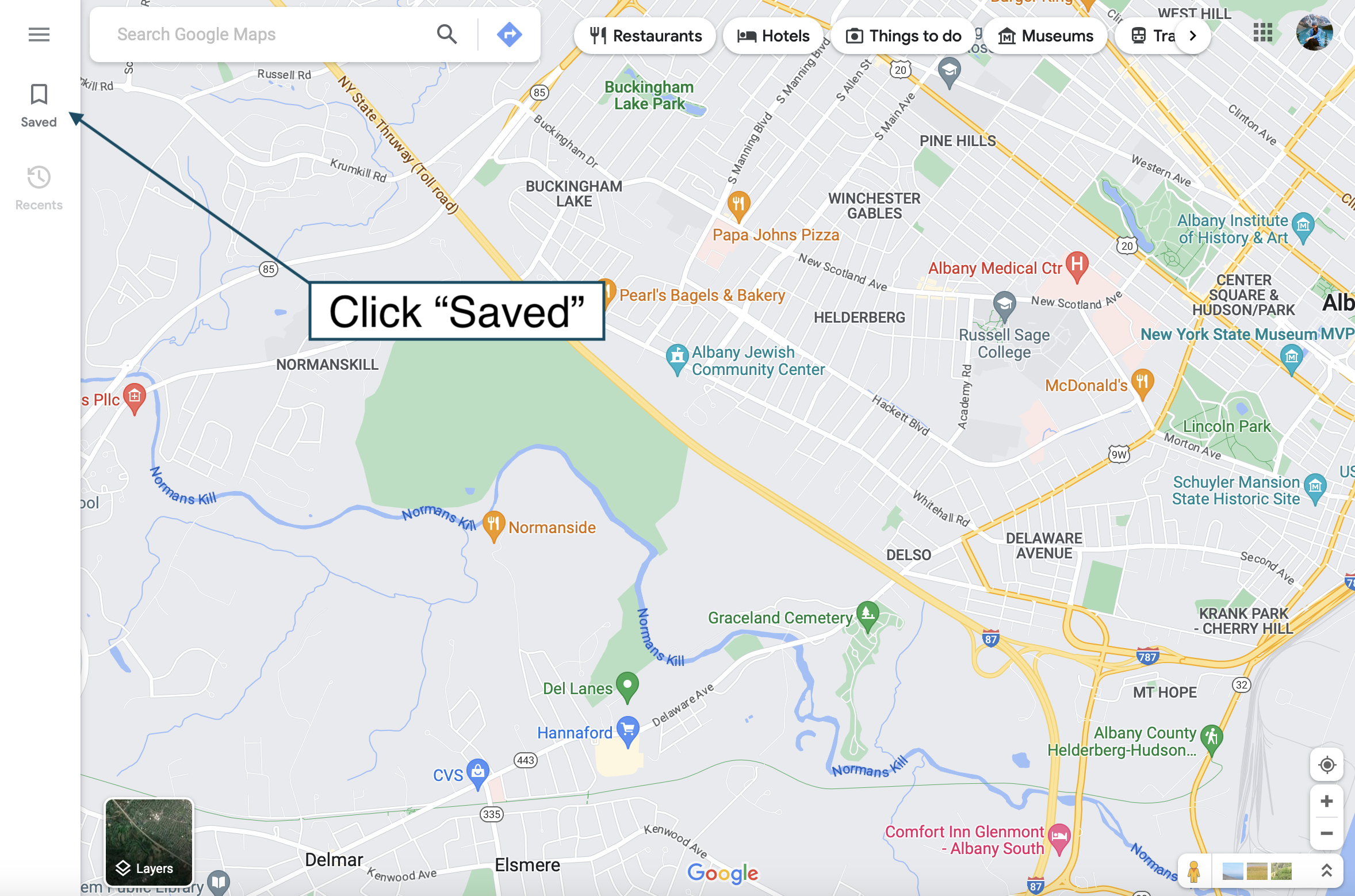
This opens a new blank map. Start by giving your map a title and a description.
Once you’ve named your map, you’re ready to start pinning stops! Keep reading to learn about adding and customizing location pins.
2. ADD LOCATIONS TO YOUR GOOGLE MAP
This is where you start adding the places you want to go!
HOW TO ADD LOCATION PINS
Add multiple stops to your Google map by pinning their locations. There are a few different ways to add location pins to your Google Map :
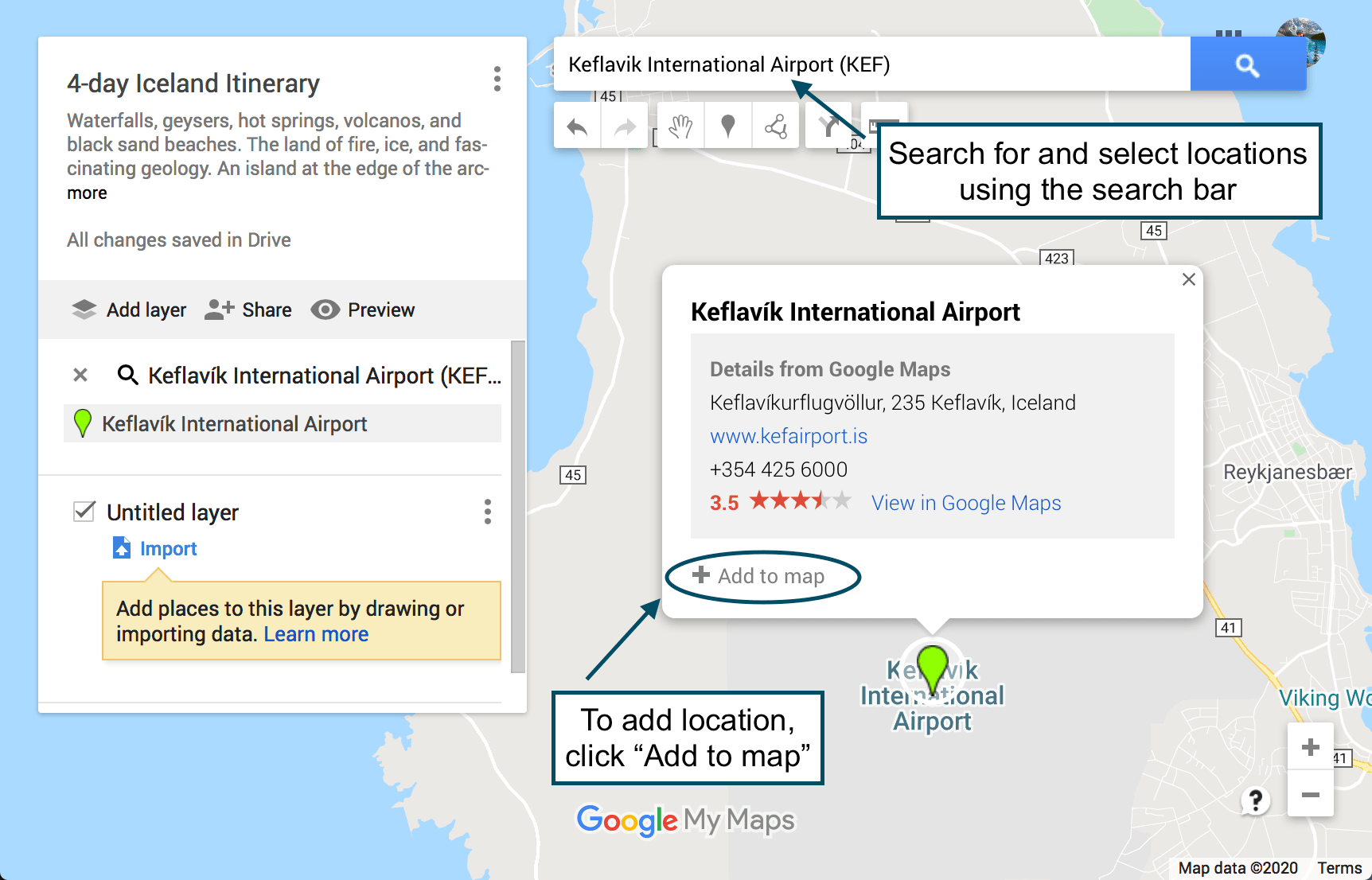
- Add a pin using coordinates if you can’t find the exact location in the search bar drop down list. You may have to use this method for extremely specific or remote locations, such as a backcountry campsite or an unmarked trailhead. Simply type the location’s latitude and longitude coordinates into the search bar. .
- To pin a general area, click on the “Add Marker” button below the map search bar . You’ll be able to drop a blank pin by clicking anywhere on the map. A box will appear asking you to add a title and description
NOTE: You’re allowed to pin 10 location pins per layer. Continue reading to learn how to use layers to add more than 10 location pins to your map.
3. CUSTOMIZING LOCATION PINS
Once you save your pins to the map, they’ll be blue by default. However, you can customize a pin by changing the color, icon style, description, and title . You can even add pictures or videos if you’re feeling extra fancy.
To change the color and style , begin by clicking on your location pin (either in the list to the left or directly on the map) > “Style” (the little paint can) in the lower right hand corner of the text box. Click “More Icons” to view more options.
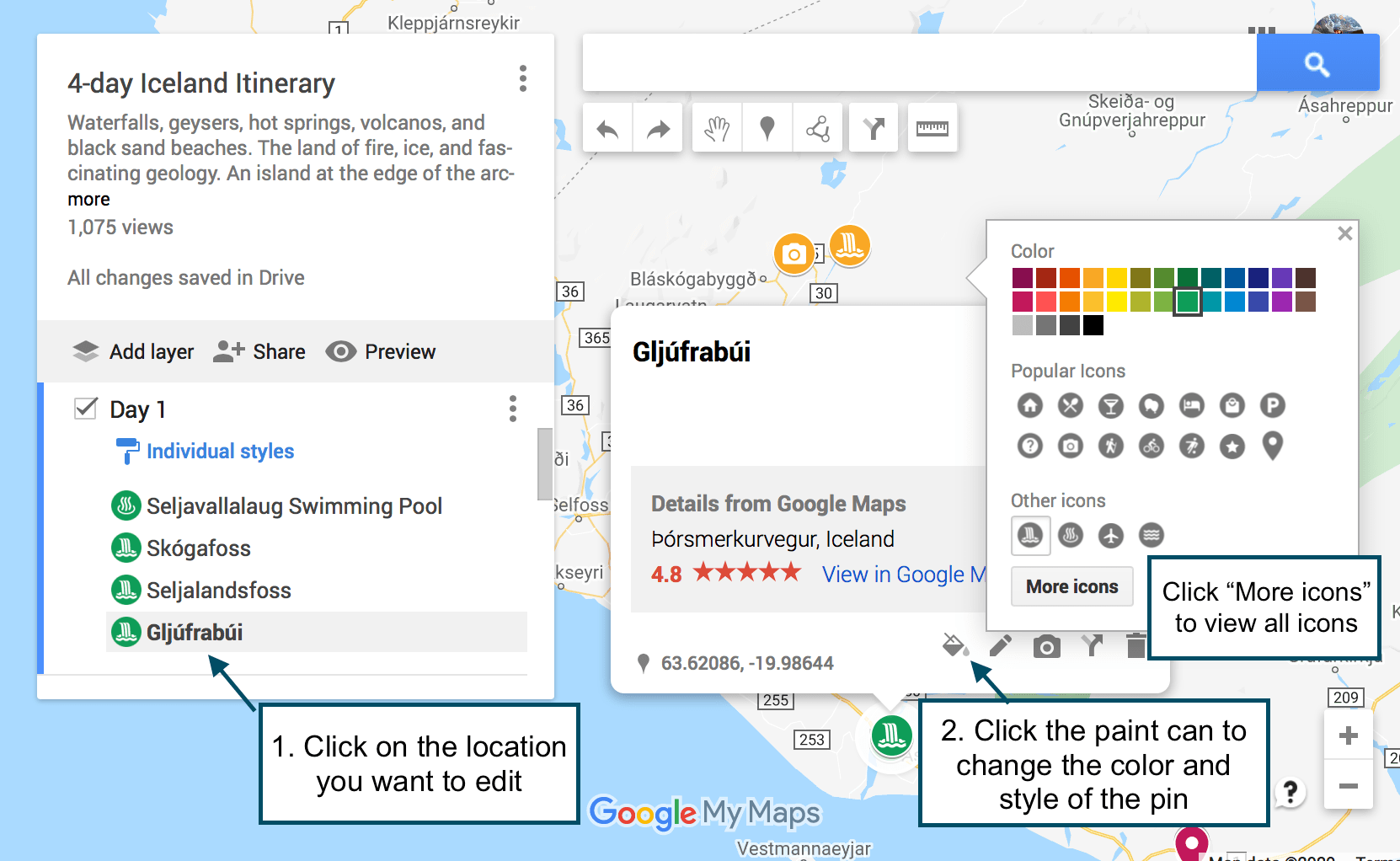
To change the location title , click”Edit” (the pencil icon) in the text box. You can also add notes in the “Notes” box. Use the notes box to add more details about finding trail heads, hiking logistics, packing reminders etc. I also like to use it to keep track of specific places to see within a general location, such as a National Park.
To add media (i.e. photos or videos) , click “Add Image or Video” (the camera icon) in the text box. I found this especially helpful on my first Iceland road trip to remember which waterfall was which, since they all sound the same (if you’ve been there, you know what I mean!). You can also add your own photos and videos if you want to create a map to share with others.
To delete a pin , click on it and then click on the trash can icon. .
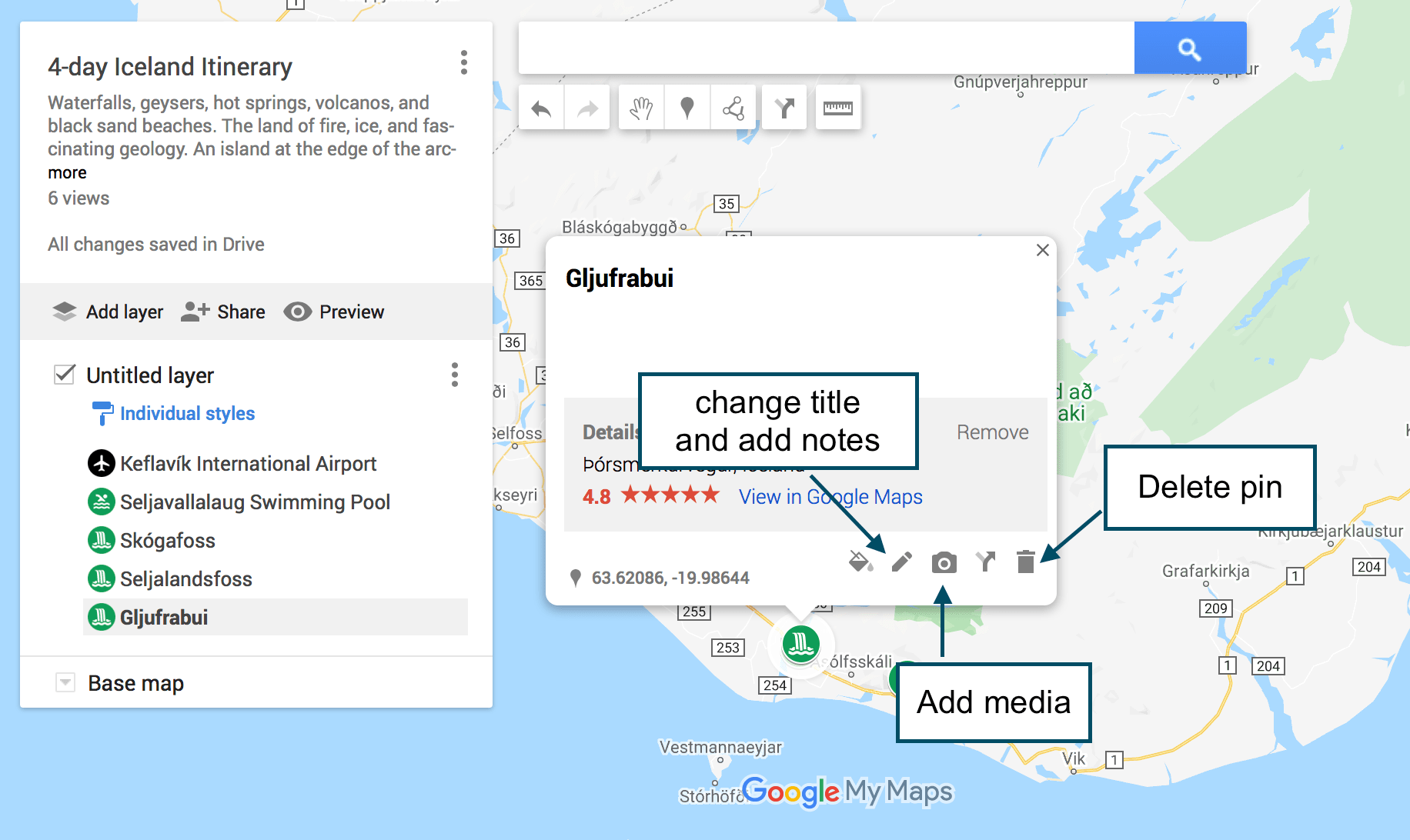
. 4. CREATING MAP LAYERS TO PLAN YOUR TRIP IN GOOGLE MAPS
What are google map layers.
Google Map layers are a really useful tool for organizing your road trip itinerary. But, what exactly is a layer? A layer in Google Maps is, by definition, a way to contain arbitrary geospatial data.
Okay, English please ?
In other words, each layer can be used to display different types of information on your map. You can dedicate different layers to different types of places like restaurants, cafe’s, hotels, hiking trails, etc. Or you can dedicate layers to different days of your trip. Or you can stick to one layer. Its up to you.
Here’s an example of how I broke up my Iceland itinerary, using a different layer for each day of our road trip:
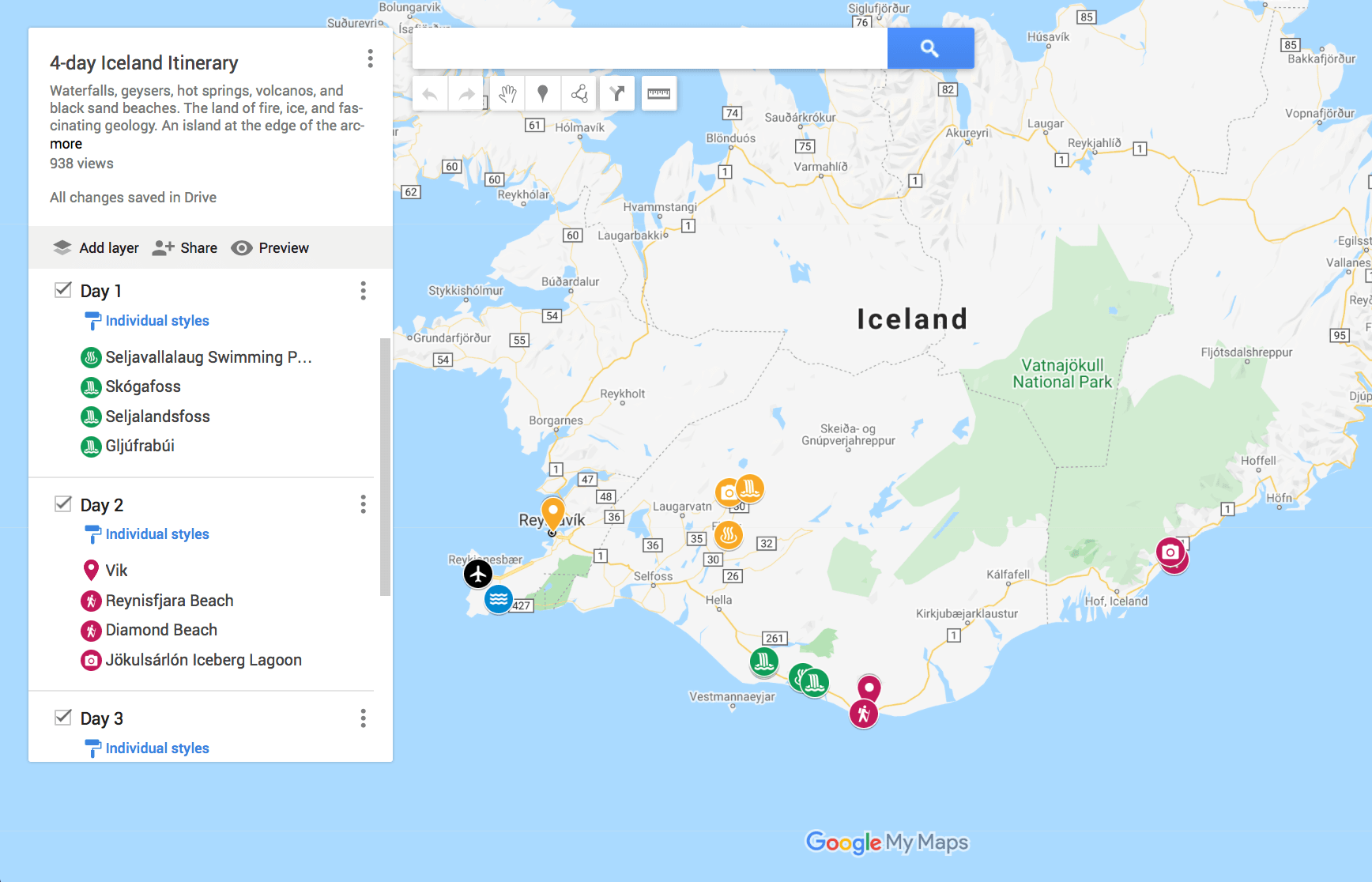
HOW TO ADD LAYERS
When you create your map, you’re automatically using one layer (“Untitled Layer”). This is the layer that your location pins are added to by default, unless you add additional layers. You can add up to 10 location pins per layer, and 10 layers per map.
To add a new layer to your Google Map , simply click “Add Layer”. This creates a new “Untitled Layer”, which you can rename accordingly. To rename layers, click on the title name or click the 3 dots next to the title > “Rename Layer”.
To move a pin between layers , click on the location pin in the list, then drag and drop it into the desired layer.
Choose which layers to display by turning individual layers “on” and “off”. You can do this by checking/unchecking the box next to the layer’s name.
To delete a layer , click the 3 dots next to the layer’s title > “Delete this layer” > “Delete”.
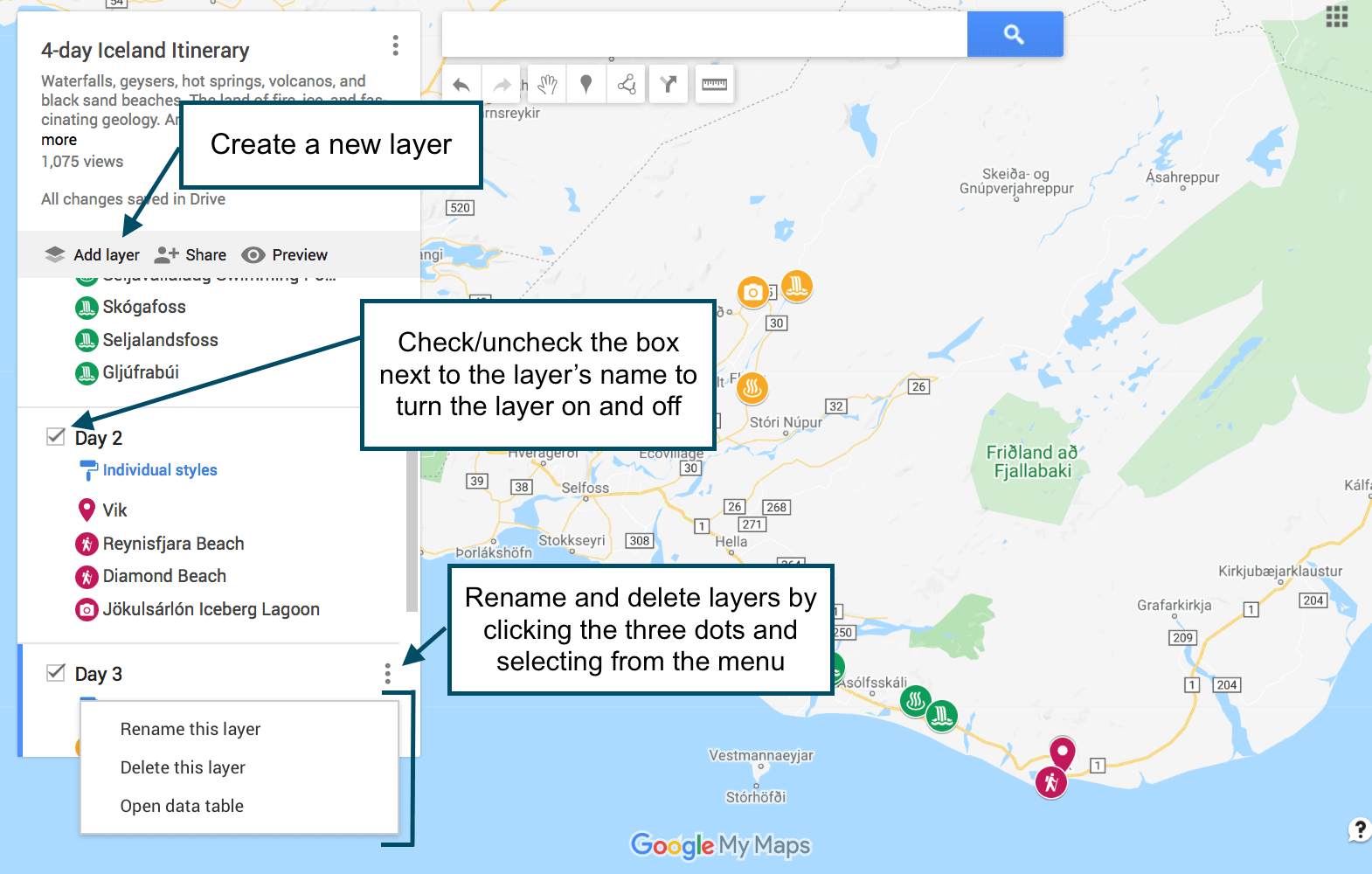
. TIPS FOR USING LAYERS TO PLAN YOUR ITINERARY IN GOOGLE MAPS
When planning my road trip itineraries, I usually give each day its own layer (unless the trip is longer than 10 days, in which case then I’ll combine days or make another map). Then I color code all of my pins by day.
For example, all of my stops (i.e. location pins) on day 1 (layer 1) would be orange, all of my stops on day 2 (layer 2) would be red, and all of my stops on day 3 (layer 3) would be blue. Organizing pins and layers this way makes it a lot easier to visualize your day-to-day itinerary on the map.
That’s just what works for me, so obviously you don’t have to do it that way. You can organize your pins and layers in any way that makes sense to you.
WHEN TO MAKE SEPARATE MAPS
Personally, I prefer to make a single map for my road trip itineraries whenever possible. But that won’t work for everything or for everyone.
Sometimes maps can get confusing if you have a lot of stops to make. Other times you’ll find that you need more than 10 layers or directions between more locations than Google Maps allows.
To solve these problems, you may opt to create several maps. Perhaps you’ll find it easier to create a separate map for each day of your road trip, or create one map dedicated just to a certain type of location or activity.
For example, we created two separate maps for our road trip through New Zealand. One map for the North Island and one map for the South Island.
5. ADDING DIRECTIONS TO YOUR GOOGLE MAP
. What good would a Google Maps itinerary be if you couldn’t get driving directions?
To add driving directions to your Google Map , click on “Add Directions” (the arrow icon) under the search bar. A new layer will appear (you cannot add directions without it adding a new layer).
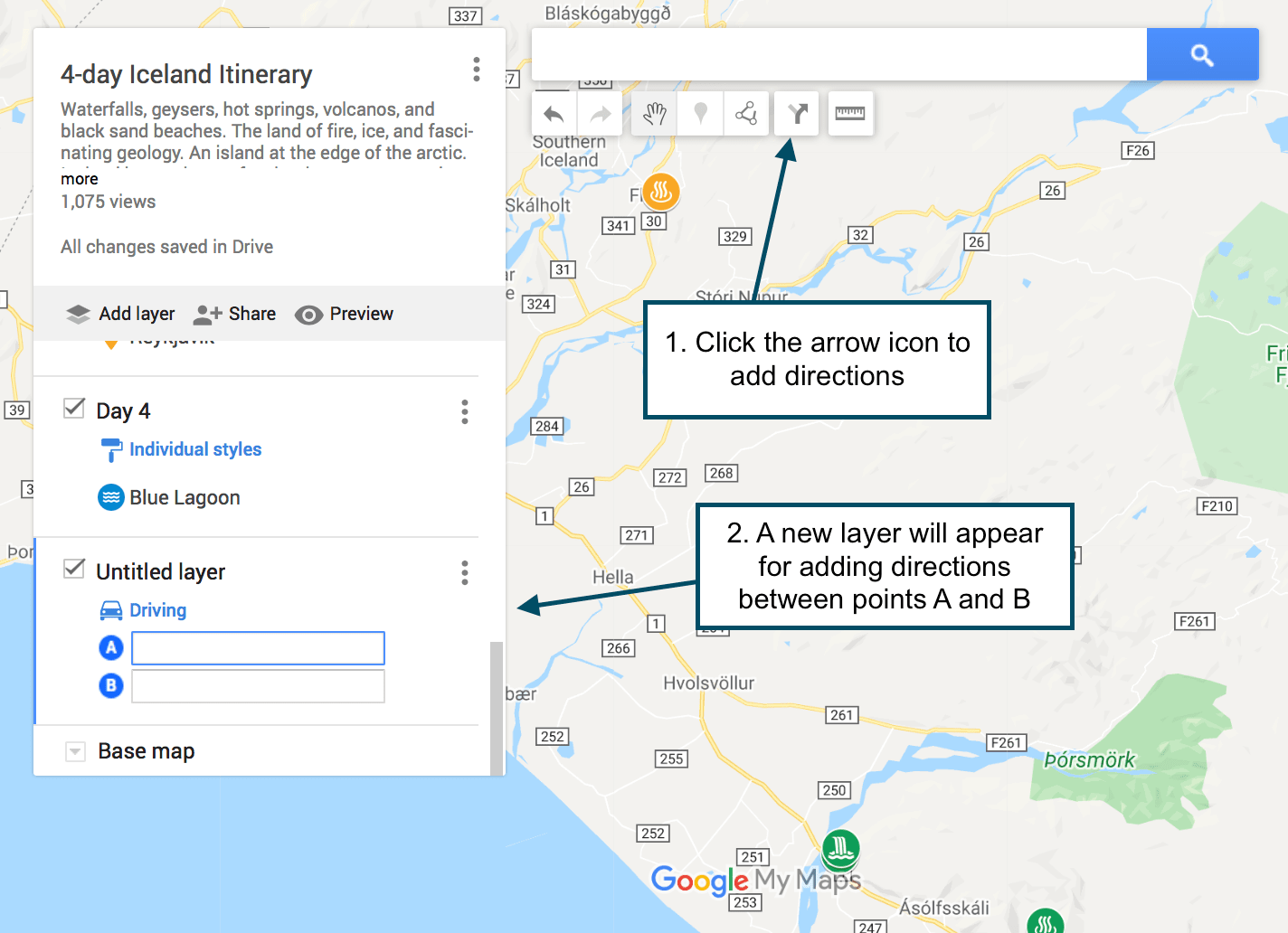
Click on “Add Directions” simply by clicking on a pinned location on the map. It will populate in point “A” . Click on a second location on the map, which will populate in point “B” . The route will show up as a blue line on the map.
The original directions will only give you the option to add points “A” and “B”. To add more destinations, click on “Add destinations”. You can add up to 10 destinations.
NOTE: This may seem obvious, but I’ll say it anyway: When you connect locations, make sure to do it in the order that makes sense. Don’t just add directions between two random locations. Make sure to do it in order!

To choose between driving, walking, or bicycle directions , click on the Directions button in the layer (the blue car icon). Then click on the appropriate mode of transportation.
VIEW STEP-BY-STEP DIRECTIONS
To view step-by-step directions, click the three dots to the right of the little of the directions layer > click “Step-by-step directions”.
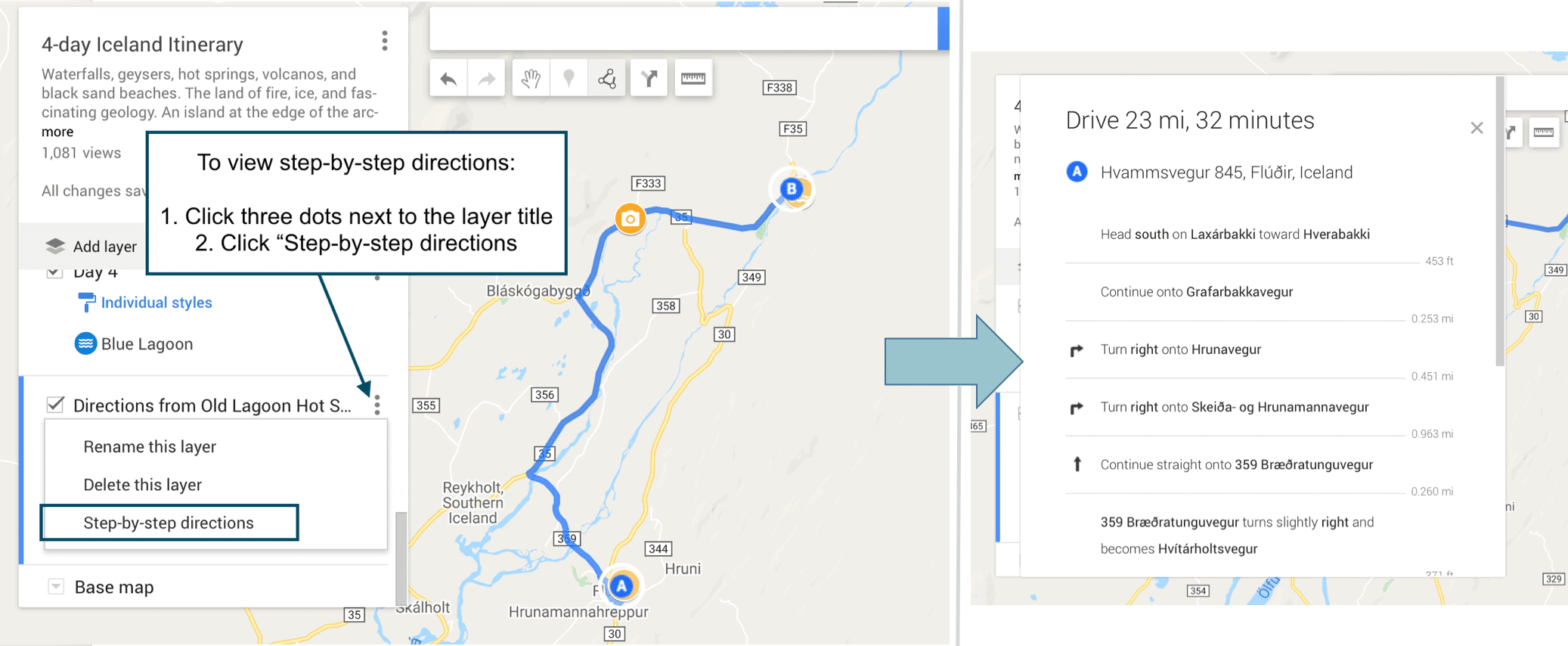
ADJUSTING YOUR ROUTE
Google maps will automatically calculate the shortest route between locations. But you can easily change the route if you prefer to take a different one (i.e. to take the more scenic route, avoid tolls/highways, etc.).
To adjust the route between two points , hover your cursor anywhere along the blue line. Your cursor will change from a hand to an arrow over a white dot. A dialogue box will say “Drag to change route”. Click and drag the white dot to the desired road or highway on the map.
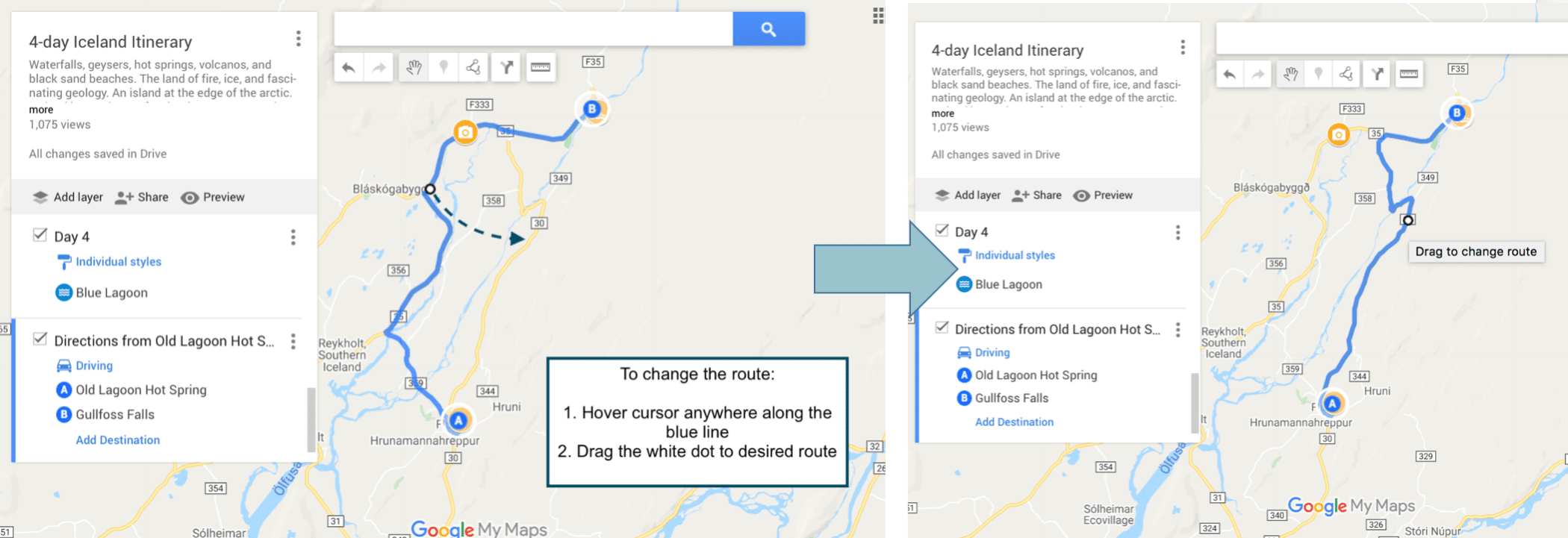
. 6. HOW TO ACCESS CUSTOM GOOGLE MAPS ON YOUR PHONE
. There are two ways to access your custom Google Maps on your phone. You can (1) reference your map through the Google Maps app or (2) export the entire map for offline access using Maps.me . Which method you use depends on your personal preference.
Steps are the same for iPhone and Android.
1. To view your maps in the Google Maps app:
- You will need to download Google Maps, if you haven’t done it already
- Sign into the same Google Drive account you used to create the map
- Click on the search bar > “…More” > scroll to the right and click “Maps”
- Select your custom map
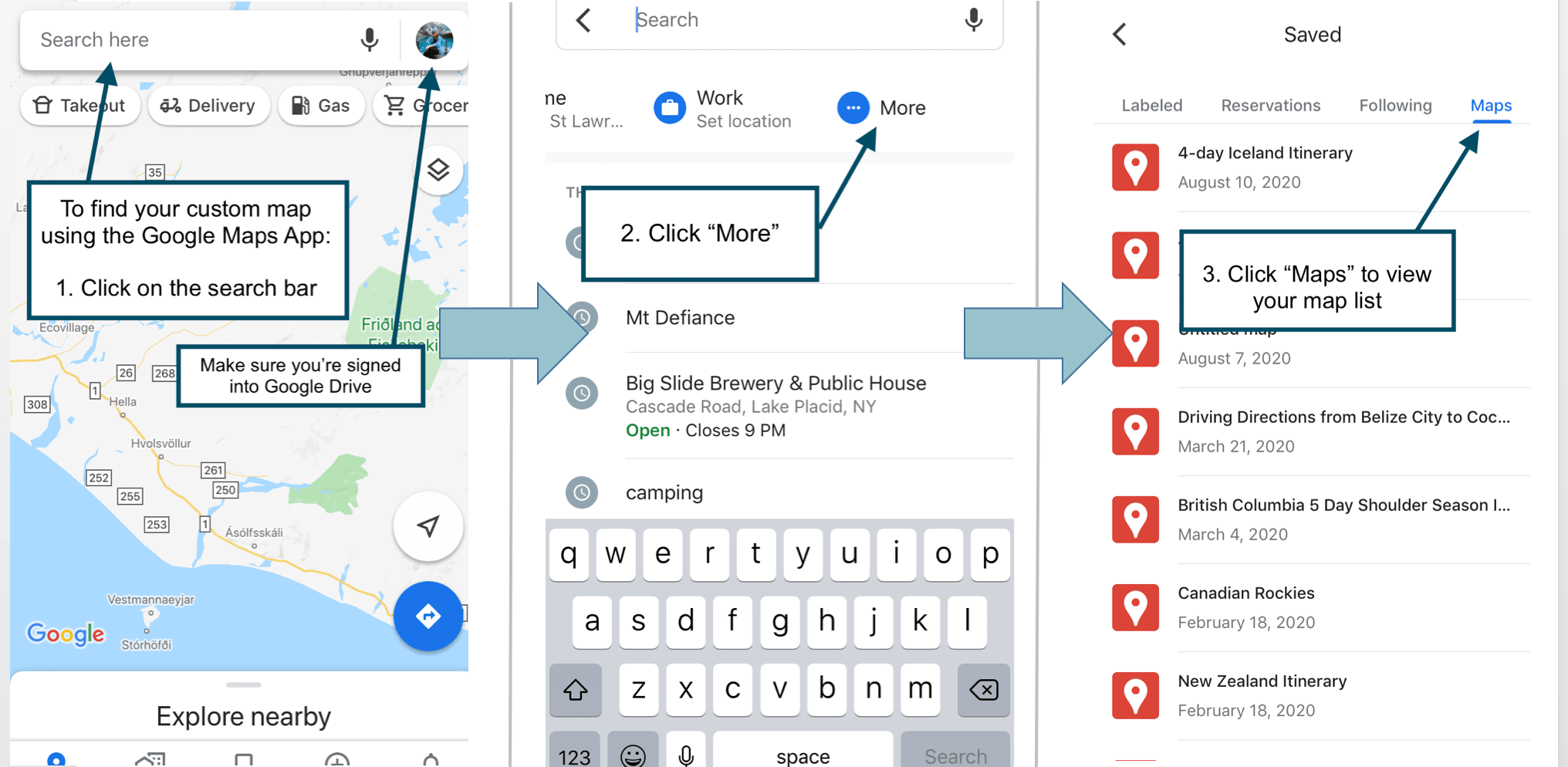
How to view your custom Google Map on your phone using the Google Maps app .
Essential tips for using the Google Maps app:
- Accessing step-by-step directions: When you open your map in the Google Maps app, your directions layer will be visible, but you won’t be able to click on it and get the step-by-step directions. . Instead, navigate to the individual location pins on the map. Click the pin and the directions instruction will populate in the search bar. Click on the search bar and then hit “Search”. This will exit your custom map and open up the regular Google Maps navigation screen. .
- Accessing your map offline: You can’t. There is currently no way to access your custom map offline in the Google Maps app. Which is obviously not ideal if you’re traveling without cell phone service or wifi. . You can download an area for use offline by clicking on your photo (the circle in the upper right corner) > “Offline maps” > “select your own map”. However, when you do this, the map will be blank and you’ll have to repin/save all of your pins. You can repin/save locations by searching for the location > “save” > and then either add to an existing list or create a new list.
2. To export your custom map to Maps.me:
This method is quite a workaround, but (unlike the Google Maps app) it allows you to access your custom map offline without having to repin anything.
On your desktop:
- Open your map on desktop
- Click the 3 dots next to the map title > select “Export to KML” > check the box next to “Export to .KML file instead of .KMZ”.
- Make this file accessible through your phone by uploading it to Dropbox, Google Drive, email, or any other file sharing app.
On your phone:
- Download the Maps.me app
- Search for the city, state, or country your map is based in and then download
- Go to your photo sharing app and open your .KML file with Maps.me
- You’ll be directed to your custom map in Maps.me
Tips for using Maps.me
If you download your map in Maps.me, you’ll be able to use it offline. However, the major drawback is that you will only be able to access step-by-step directions from your current location. So, even though your directions layers will populate on your map, you’ll only be able to view the drive times and not the actual directions, unless one of those points is your current location.
That being said, I am not a Maps.me expert. So, if you have an update or workaround for this issue, please reach out and let me know :)
7. CREATE A SHARED GOOGLE MAP
You might want to share your map if you’re planning a trip with someone else, collaborating on an itinerary, or sharing your map on a website.
To share your Google Map , open the map > click “share” in the gray bar above the layers. Make sure the slider for “Anyone with this link can view” is set to blue. Then copy the link and send it to friends!
To embed your map on a website , check that your sharing sliders are set to “Anyone with this link can view” and “Let others search for and find this map on the internet”. Next, click the menu (the three dots) next to the map title > then click “Embed on my site”. Copy the HTML and paste it in the source code for your page.
8. BONUS: CALCULATE GAS MILEAGE
. Download my customizable Travel Expense Planner below for free . Use it to easily and automatically calculate how much money you’ll spend on gas, using your custom Google Map!
And there you have it! All the tips, tricks, and general instructions on how to use Google Maps as a road trip planning tool . As always, if you have any questions or have anything to add, leave a comment below. I love to hear from you!
Happy adventuring!
Did you find this Google Maps road trip planning tutorial helpful? Don’t forget to pin it for later!
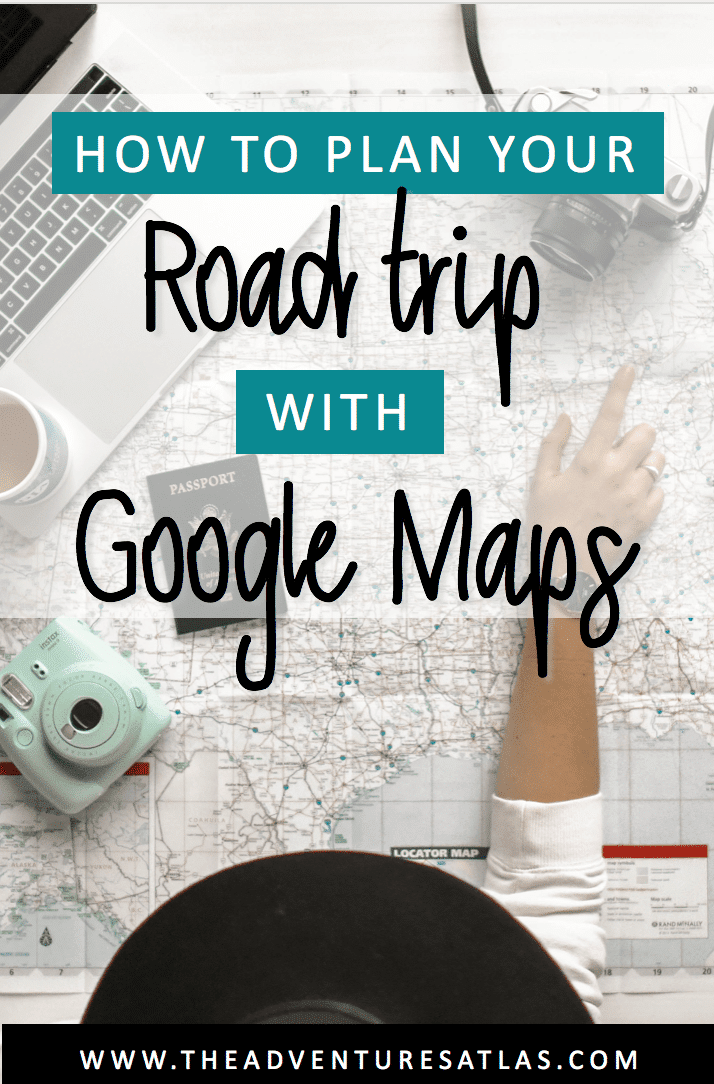
Hi, I’m Jackie! I’m a travel photographer and content creator based near the Adirondack Mountains of Upstate New York. I’m also a millennial who works full-time, yet I still find ways to travel frequently without breaking the bank, because traveling is what makes me feel most alive. Now I help fellow travelers who also work 9-5 and are looking for ways to travel more with limited PTO.
Related Posts
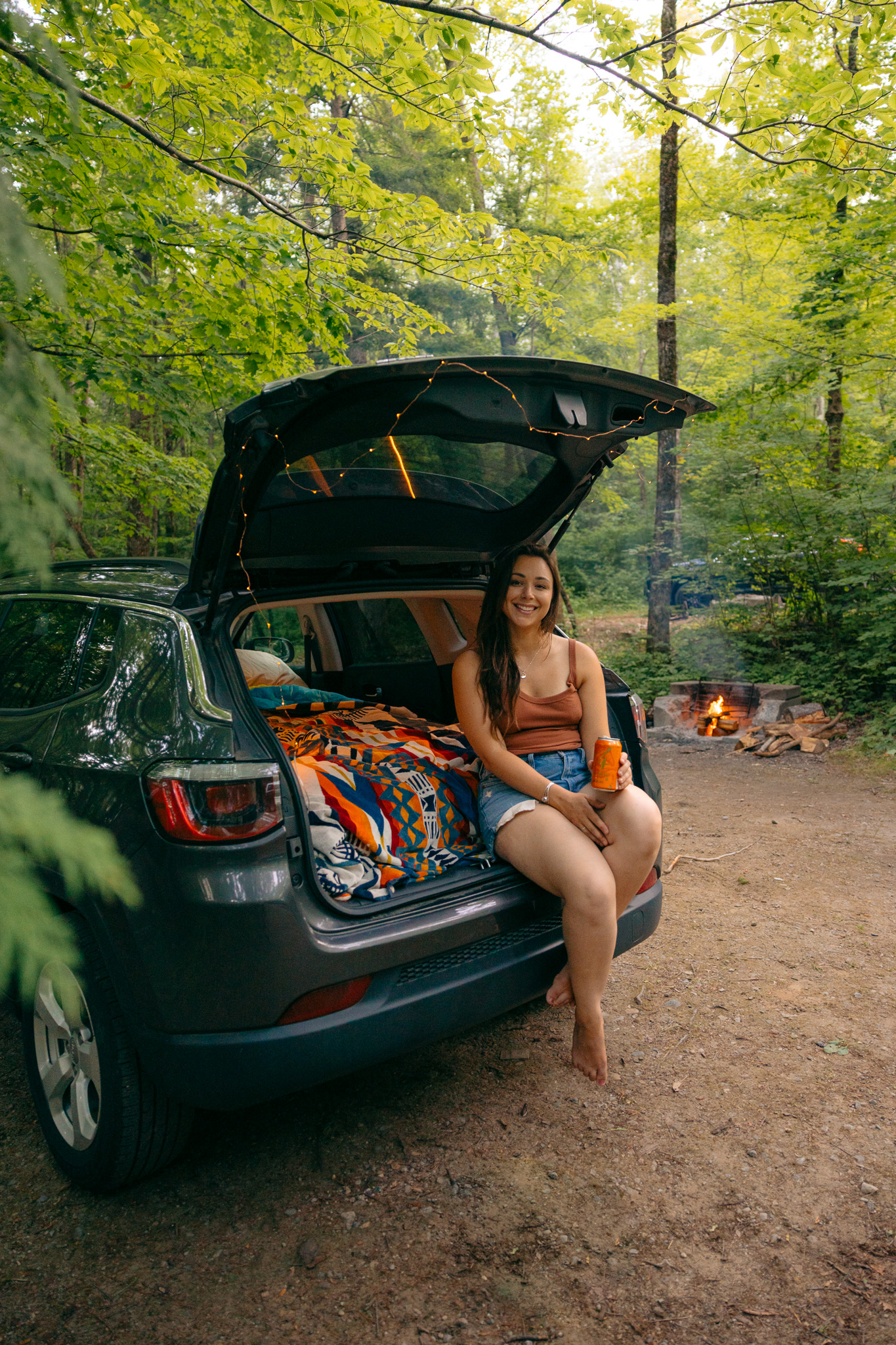
15 Useful Apps to Download Before Your Next Road Trip (for Free!)
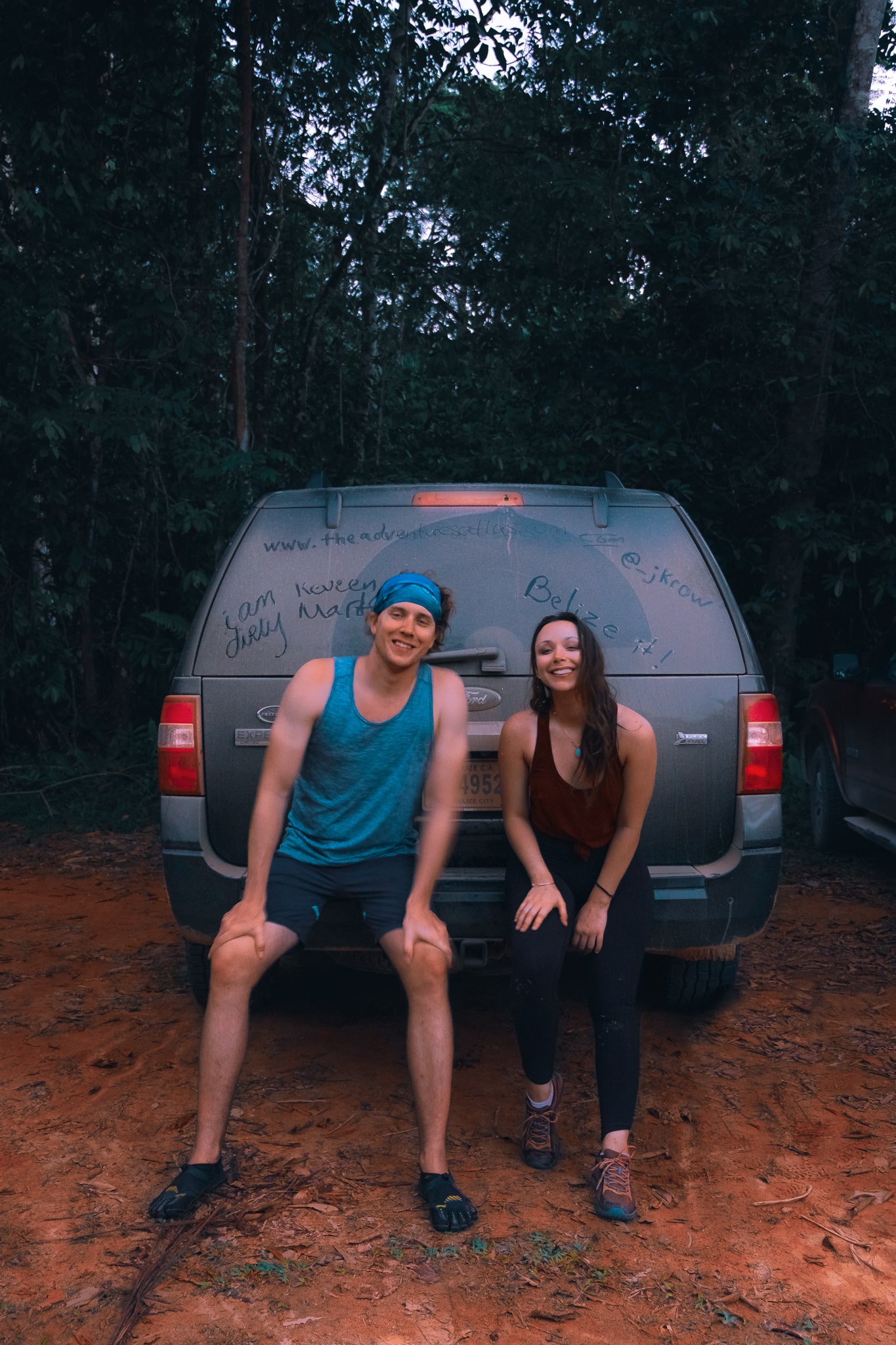
All You Need to Know About Renting a Car in Belize | Cost, Tips, FAQs – Updated Guide 2023

19 Important Things to Know About Ecuador Before You Go
27 comments.
[…] Krawiecki, J. (n.d.). How To Plan Your Road Trip With Google Maps. The Adventure Atlas. Retrieved from How To Plan Your Road Trip With Google Maps (Tutorial With Examples) | The Adventures Atlas […]
[…] that an SUV or an RV is better suited for the whole family. Once you’ve secured your vehicle, map out your route, research the stops that you want to make, and make a list of the things that you’ll need to […]
[…] You won’t have service once you get there though, so I suggest downloading offline Google Maps of the area before you go. To learn how to download offline Google Maps, visit my blog post on How To Plan Your Road Trip Using Google Maps […]
[…] How to Plan Your Road Trip Using Google Maps […]
[…] How to Plan Your Trip Using Google Maps […]
All I needed when I googled “how to plan a trip in google maps” was to be pointed in the right direction of where to look for the feature. This went WAY beyond what I could have ever asked for and helped SO MUCH! Thank you, thank you, thank you!

Hi Nicole – I’m SO glad to hear you found this post helpful!
[…] How to plan a road trip using Google Maps […]
Hello Jackie, and thanks for the very informative article! It was well written and I used Google Maps on my last trip to the Baja in Mexico. One other tool I used was the free trip planner from Geovea https://geovea.com/trip_plan/new_trip to create and share my trip, and estimate my trip budget. You can also take your itinerary with you on your phone for navigation. I really appreciate all of the great travel guides and already planning my next trip :-)
Thank you for sharing all of this valuable information! I see how to view the turn-by-turn directions, but is there a way to start the route so you can follow it while driving? Thanks!!
[…] How to Plan Your Road Trip using Google Maps […]
This literally just changed my life! Thank you for sharing how to use google maps to plan a road trip. I will use this all the time now!
Hey there – so happy to hear you found this post useful!
[…] Planning a Costa Rica road trip? Read: How To Plan Your Road Trip With Google Maps (Tutorial With Examples) […]
[…] a large geographical area you need to give your trip a bit of structure. You can start by using Google Maps to plot and plan your journey so you can make a note of all the destinations you are interested in. You can then agree on a few […]
[…] Read next: How To Plan Your Road Trip With Google Maps (Tutorial With Examples) […]
said no driving directions from point a to point b, so i couldn’t get started. E.G. Badland SD to Mt Rushmore to Custer Nat. Park, I need a little more direction, i’m not to good with comp. thanks
Hey Billy – Sometimes Google Maps won’t recognize directions to very general areas because it wants you to use something more specific. This most often happens with National Parks and wilderness areas. In those cases, Google Maps will generally present you with a list of specific locations you can choose from, such as the park’s ranger stations, visitors centers, etc. However, in your situation, I was able to pull up directions using “Badlands National Park”, “Mount Rushmore National Memorial”, and “Custer National Forest”. Hope that helps!
[…] necessary than you suppose to sleep, bathe and plan for slower days. A very good rule of thumb is to plan in rest time each three days. That method, you possibly can push your self however forestall exhaustion in your […]
[…] essential than you assume to sleep, bathe and plan for slower days. An excellent rule of thumb is to plan in rest time each three days. That means, you possibly can push your self however stop exhaustion in your […]
I’ve been a user of paper maps, since before the Internet, or color TV for that matter. For an up coming trip, basically Texas to FL, and back, I decided to make better use of Google Maps. A google search brought me to this page. Super helpful, and the pins per layer note answered a long standing confusion of mine. Thank you. I do have one question. Is there a way to to add waypoints based on distance or travel time? For example, this is going to be a two day trip. I want to find the halfway point (easily)? Or in the case of a longer trip, I want to drive X miles or Y hours? I know I can trial and error it, but what if I want the half-way point? What’s the easiest way to find it? Or where will I be in 8 hours of driving? Thank so much! Cheers, Eric
Hey Eric – thanks so much for your comment! Unfortunately, I don’t know of an easy way to calculate your half way point or location after x amount of hours. I typically eyeball it, which might be the only way to find your answer
Thanks very much, it is really helpful
This was most helpful for creating a personal map. I tried it and created a practice map on my laptop; named it and accessed it exactly like your instructions indicate. The part that has me puzzled is the accessing it from your phone. I have used Google maps on my phone for a long time and believe I am signed in using the same account. The Google Maps app on the phone identifies me (the right end if the search bar has my initial and shows the account when tapped.) When I tap the search bar I get to the … More but that is it. All I then see is the opportunity to set my Home and Work Locations but no listing of My Maps.
On the laptop going to the Menu (bars at left side of Search) allows access to Lists, Labeled, Visited, and Maps. (Maps is the one, as you indicate, to get to your personal Maps.) On my phone the only thing that seems to be available is the Labeled option. What am I missing to get to the Maps? I feel like there must be a switch somewhere to have the Maps come through … but I can’t seem to find it! Hoping you or someone can point me in the right direction. Thank you.
Without creating a custom map, is there a way to display a route in Google Maps and show attractions at the same time?
You’ve written a terrific guide and I’m learning a lot more about Google maps. Is there some way to print this guide or download a printable copy? Thanks.
Leave A Comment Cancel reply
Save my name, email, and website in this browser for the next time I comment.
WANT TO SAVE MONEY TRAVELING?
Check out the travel resources →
Check out my list of reliable budget-friendly travel resources that are guaranteed to save you the most money, without compromising your experience.
This error message is only visible to WordPress admins Error: There is no connected account for the user 17841400792270379.
Get in touch
Contact Portfolio Let’s work together
Explore the blog
Destinations Guides and itineraries Travel planning tips
Let’s connect
Never miss an adventure, privacy policy | terms of service | disclaimer | by zazen designs.
Back to top

How to Plan a Road Trip with Google Maps – A Step-by-Step Illustrated Guide
By Jason Barnette | Travel writer and photographer with 15+ years of road tripping experience
- Last Updated on May 26, 2023
- Published on March 25, 2022
This post may contain affiliate links. Read my Affiliate Disclosure here .
My road trip planning always begins with Google Maps. In less than half an hour, I can create a new map, add a driving route, and fill layers with markers. Once completed, I sit back with a fully visualized road trip in front of me.
All of this is made possible with Google My Maps – a component of Google Maps that allows users to create customized maps. After years of road tripping, I have built an archive of over a hundred custom maps. It’s great for planning a road trip – and remembering my favorite moments years later.
Follow this step-by-step illustrated guide to learn how you can create custom maps, load them in Google Maps, and create the perfect road trip itinerary.
Google Maps vs Google My Maps
Google Maps has become one of the most popular navigation apps available on mobile devices and online. Users can get turn-by-turn voice navigation, search for points of interest, and save them to lists. However, that’s where the usability ends. It’s not the ideal way for planning a road trip.
Google My Maps is a tool for creating a custom map with layers, stylized markers, and routes.
READ MORE: 10 Ways to Save Money on Gas on Your Next Road Trip
This helps visualize a road trip, place destinations in the correct order, and make sense of the grand scale of the road trip. After creating a customized map, users can open it in Google Maps on any mobile device, plug into a compatible vehicle, and let the road trip adventure begin.
Here are three primary differences between Google Maps and Google My Maps:
- Google Maps cannot be shared with friends and family, but Google My Maps can be shared
- Google Maps cannot stylize the markers, but Google My Maps can style colors and icons
- Google Maps has an app for mobile devices, but Google My Maps can only be used in a web browser
Google Maps lists is a great way to build your road trip wish list, and Google My Maps is a great way to build your road trip itinerary. Used together, these are powerful tools for planning every moment of your road trip adventure.
Google My Map Example
“Wish, however, that you had added a road map that I could use on my GPS,” Karen commented on Road Trip: Exploring the Tennessee Mountains From Knoxville to Chattanooga . She wasn’t the first person to request a map to download to mobile devices and take on the road with them.
I listened.
One of the benefits of using Google My Maps is the ability to share the map with friends, family, and fellow road trippers. But after posting a story about a road trip, I would delete the Google My Map. Eek! I wish I hadn’t done that.
I am in the process of recreating all the road trip itineraries I’ve posted in Google My Maps. In the future, when you see a road trip itinerary, “things to do” post about a destination, or roundup of coffee shops, breweries, and restaurants, you will see a link to a custom Google My Map. You can download the map to your Google account and take it with you!
For now, here is an example to help you with this tutorial: Road Trip to the Southern Sixers at Google My Maps .

Step No. 01
Create a custom map.
To begin creating a custom map, visit the Google My Maps website. You’ll need a Google account if you don’t already have one – there are lots of travel benefits to having an account.
Google My Maps requires a web browser – Google recommends Safari, Firefox, or Chrome. It’s possible to create these custom maps a browser on a tablet, but the ideal situation would be desktop or laptop computer.
1. Create a New Map
Click the “Create a New Map” button.
2. Give the Map a Name
Initially, the map will be named “Untitled map.” Not exactly memorable or descriptive. Click on the map’s name to change it and make is something you can easily identify later.

Step No. 02
Edit the first layer.
By default, an “Untitled Layer” is already present in any new map. This is the starting point for creating a custom map.
1. Rename the Layer
Click the title of the layer and change it to “Destinations.” This will always be the first layer when creating a road trip map. In this instance, destinations are cities, towns, or parks used for creating the route of your road trip. You will create additional layers later for attractions, restaurants, and hotels.

2. Add Markers to the Layer
The next step is to lay out the road trip route. You may not yet know the exact route you want to drive, but you’ll likely know the destinations you want to visit.
Always begin by adding your home address as the first marker. You will need this when creating the driving route.
Using the search bar, search for the name of the destination. It can be a city or town, state or national park, or any type of business listed in Google Maps. Add each destination to the layer, and then drag the markers into the order you wish to visit them.
Layers can have an unlimited number of markers. But keep this first layer to strictly the destinations you want to visit.

Step No. 03
Create a route between destinations.
The hardest part of planning a road trip is determining the route to drive. Sometimes, it’s easy if there is only one way to get from one destination to another. Fortunately, creating a route with a Google Map presents options.
1. Create a Driving Route
In the Map Tools area, click on the icon to “Add Directions.” Clicking this tool will create a new, untitled layer. The default directions are for driving, however it’s possible to change the transportation mode to bicycling or hiking.
2. Enter the Start and End Points
Two empty boxes appear in the driving route. In Box A, begin typing the name of the first marker saved in the Destinations layer – most likely your home address, unless you’re on a multi-stop road trip. It will appear in a dropdown menu. Select the name of the destination to add it to Box A. Do the same with Box B, choosing the end point of your road trip.
An initial route will appear on the map. Like planning a route in Google Maps, this is Google’s default route based on traffic conditions, road closures, and speed limits. It’s just a suggestion. It’s possible to change this route depending on your personal preferences.
If you want to create a loop, simply enter the start point again as the end point. Google Maps will automatically create a loop connecting all the destinations.

3. Add Additional Stops
If you want to add additional stops to the driving route, click “Add Destination” at the bottom of the layer. Another empty box will appear. Begin typing the name of a destination and select it from the dropdown list.
Driving layers can have a maximum of 10 stops. If you’re road trip is longer than ten stops, consider dividing the route into multiple layers. One option would be to create a driving layer for each day of the road trip. Another option is to divide the road trip into segments.

4. Customize the Route
Click on any point along the route. With the route highlighted – a faint white line surrounding the bright blue line – you can now edit the route. Click on any point along the route and drag it in a different direction. Let go, and the route automatically adjusts to your preference.
Customizing the route must be the last step in the process of creating a driving layer. If you add another stop to the layer, it will reset the custom route and you’ll have to start over again.
Customizing the route gives you the option to avoid interstate highways, take the scenic route along national scenic byways, or to select country roads for a long summer drive.
5. Rename the Driving Layer
When a route is created, Google My Maps automatically generates a name for the layer. However, you may want to rename this layer something easier to remember. “Route” is always a good option.

6. Route Information
One of the neatest features of Google My Maps is the step-by-step directions with driving, biking, or hiking routes. Click the three dots beside the layer name and select “Step-by-Step Directions” in the dropdown menu. At the very top of the directions, you’ll find the total miles and suggested drive time for the route. This can be valuable information for budgeting gas and planning how long to drive each day of your road trip.

Step No. 04
Add additional layers and markers.
With the route finished, now comes the fun part. Adding the markers! Layers and markers are a good way to visualize your road trip adventure, adding places you don’t want to miss and roadside attractions you need to visit.
1. Create a New Layer
Click “Add Layer” to add a new layer to the custom map. Custom maps can have a maximum of 10 layers, including driving layers. Make use of this limit to organize your road trip information.
What kind of information would you want to save into layers?
Hotels, campgrounds, bed and breakfasts, and Airbnb rooms. It can help to save the place where you’ll spend each night of your road trip into a “Lodging” layer.
Restaurants, coffee shops, and dessert cafes. Everybody needs to eat. Creating a “Restaurants” layer can help you remember all those places your friends told you to visit.
Points of interest. Friends inevitably bombard you with tips on places you shouldn’t miss. The best way to keep up with that information is to drop a marker onto the map in a “POI” layer.
Layers can be organized by theme, date, location, or any way you could possibly think to organize the content. The purpose of layers is to organize the markers to make them easier to show or hide on the map while traveling.

2. Add Markers
There are three ways to add markers to any layer. The first is visually as you scroll through the map. Like Google Maps, Google My Maps allows users to click on business names to see more information.
The popup box includes a wealth of information. Typically, each marker will include “Details from Google Maps” like the street address, website, and phone number. Clicking the website will open it in a new tab or window in your browser.
At the bottom of the popup box, click “Add to Map” to add the marker to the current layer.
A second way to add markers is with the search box. After entering a search, lime green markers appear on the map and a list appears at the top of the layers. Clicking on the markers or names in the list will display the popup box and the option to add it to the current layer.

The final way to add a marker to the map is to create a custom marker. In the Map Tools menu, click “Add Marker.” The cursor changes to a crosshair. Wherever you click on the map, a new marker will be created.
A popup appears asking for information about the new marker. Enter a name for the marker in the top box. You can add a description in the second box, if needed. Click “Save” to add the marker to the layer.


Step No. 05
Stylize the markers.
After adding a route and dozens – perhaps hundreds – of markers, the data can be overwhelming to view on a single map. This is where Google My Maps differs the most from Google Maps: the ability to stylize the markers.
There are three ways to stylize markers in a custom map: Individual Styles, Uniform Styles, and Sequence of Numbers.
1. Individual Styles
By default, Individual Styles is selected. With this option, you can change the color and icon for each marker individually. This is helpful if you want to color code markers or create groups of icons within a single layer.
2. Uniform Style
The second option is to create a Uniform Style. This collapses the list of markers and allows you to choose a custom color and icon for all the markers in that layer at once. The markers are still viewable if you want to see them, but not editable. Uniform Style is a great way of grouping all the markers in a layer by subject like restaurants, hotels, or museums.
3. Sequence of Numbers
The third option is to create a Sequence of Numbers. This is a great option for creating an itinerary for the markers in the layer. The markers are still visible in the list and draggable to reorder them, automatically updating the number sequence. Changing the color of any of the markers will automatically pass that color to all the markers in the sequence.

4. Style Options
After clicking the edit button for any marker, a popup menu shows a color palette and popular icons. Unfortunately, Google My Maps does not support custom colors. But with 30 colors to choose from, you’re certain to find something that will work for your road trip.

Clicking “More Icons” at the bottom of the popup menu opens the full list of 432 available icons. A search bar makes it easy to find what you need for the markers on your road trip map. Here are some common icons you may want to use:
- Shopping Cart
- Information

Step No. 06
Open the custom map in google maps.
Every change made to a custom map in Google My Maps is automatically saved. Once you have finished customizing the map, it’s time to open it on your mobile device. If you created a new Google account, you will need to use that same login information with the mobile app.

1. Load a Custom Map on a Phone
Open the Google Maps app. Tap “Saved” on the bottom menu bar. Tap “Maps” underneath your lists. Here, you will see the custom map you created earlier. Tap on the map you want to open.
To begin using the map, tap “Go” in the bottom menu bar. You can now scroll through the custom map, zoom in and out, and tap on any of the markers you added earlier.

2. Load a Custom Map on a Tablet
Open the Google Maps app. On tablets, tap the three-line “hamburger” menu icon in the search bar and then tap “Your Places.” Tap “Maps” in the new menu along the top of the lists. You will now see the same list of custom maps you see in the phone menu. Tap on the map you want to open.
Once this map opens in Google Maps on a tablet, it is ready to use.

Step No. 07
Navigation with a custom map.
Although you can create driving directions with a custom map, you cannot use that route for turn-by-turn voice navigation.
So, what’s the point in doing all this work?
Long before Facebook was invented, in the era of Napster and Road Rules on MTV, pioneering road trippers used maps printed on paper. Using a custom map created in Google My Maps, loaded into Google Maps, would be a similar experience but in a digital format.
With the custom map loaded, users can zoom in and out to get more details of the route ahead. Like using Google Maps, your location is pinpointed with a blue circle – if you have location services enabled on your mobile device. Although it won’t be voice navigation, you will still be able to see where you need to make turns to follow the route you created earlier.
Quasi-Voice Navigation
It is possible to get turn-by-turn voice navigation, but it comes with a caveat. Tap on the next marker along the driving route, and then tap on the blue circle to get directions. Tap “Start” and turn-by-turn voice navigation starts.
However, you will notice the driving route may no longer match your customized route. That’s because this method creates a new “initial” route.
If you customized the driving route to use national scenic byways or avoid interstates, you lose that customization using this method. But, depending on how you customized your route, it may not matter anyway.
5 Responses
If you’re using your custom map without turn by turn navigation, it is a small headache to keep the phone from auto-locking. The best I was able to find was that you’d have to make a change in developer mode and even then it would only stay open if the phone was charging, not all the time.
Very helpful in creating the map and the layer with destintaions. Was able to see the map on the phone. When opening the map on the phone however there was no option to “go” so the map was useless.
That’s strange. I just tested it again on my iPhone 14 with Google Maps. I loaded the custom map I had created for places to eat brunch in Columbia, South Carolina, I tapped one of the pins I dropped on the map to a restaurant, and I was given the option to tap “Start” and it began voice navigation. You didn’t see that option on your phone?
MyMaps unfortunately is limited to ten stops on a trip route. So it’s rather useless for long road trips…
This is true. But that’s why this is only for PLANNING a road trip, not executing it. Google My Maps helps you visualize the stops and choose the best route. After that, I think you should use a Garmin automotive GPS for navigation.
Leave a Reply Cancel reply
Your email address will not be published. Required fields are marked *
- share this article
Privacy Policy
Copyright © 2023 Jason Barnette | All rights reserved | Seriously, don’t steal my stuff

Share this Article
Did you enjoy reading this article? If so, then share it with your friends. Sharing is caring, after all.
How-To Geek
How to plan a road trip with multiple destinations in google maps.
Map out multiple destinations in Google Maps on the web or in the app.
Quick Links
Add multiple stops using the website, add multiple stops using the mobile app.
Whether you're planning a day out on the town, or want to orchestrate the perfect road trip across the country, Google Maps allows you to add up to nine stops, excluding your starting point, when you make directions from both the website and the Maps app. Here's how you do it.
First, open up your browser and head on over to Google Maps. Click the "Directions" button to the right of the search bar.
By default, Maps will use your device's location for the starting point. If you want this to be a different location, enter it now.
Next, enter the location of your first destination into the field provided, and then hit Enter. Alternatively, you can click any location on the map to get the same results.
Make sure you have either the driving or walking option selected, as Maps only lets you make multiple destinations with these two travel modes.
To add another destination, all you have to do is click either the "+" or the space below your first destination, and then start typing a new location. You can repeat this to add up to nine total stops. If you have more stops than is allowed, you may need to make another map from where you left off.
If at any point you decide you want to change up the order of your destinations, just drag any location up or down on the list using the circles on the left.
And once you've created your map in your web browser, you can click the "Send directions to your phone" link to send it to your mobile device by email or text message. Assuming you've got the Google Maps app installed, you can open it right up.
If you want to optimize your travel, you can also turn a multi-stop Google Maps trip into a round-trip .
Related: How to Find Public Restrooms Near You with Google Maps
You can use the Google Apps mobile app (free for iPhone , iPad , and Android ) to create a map with multiple destinations in much the same way.
Related: How to Download Google Maps Data for Offline Navigation on Android or iPhone
Fire up the Google Maps app on your mobile device, and then tap the blue "Go" button on the bottom right of your screen.
By default, Maps uses your device's location for the starting point. If you want this to be a different location, enter it now.
Start typing in your first destination or tap a location on the map below to start your journey.
Next, open the menu (the three dots at the top right), and then tap the "Add Stop" command.
Enter the location of your next stop, or tap anywhere on the map to add the next destination.
To change the order of your destinations, just drag any of the locations up or down the list using the "Hamburger" (three stacked lines) on the left.
When you've added all the stops to your trip, go ahead and tap "Done" so you can start your journey.
Related: How to View and Delete Your Google Maps History on Android and iPhone

How to Plan a Road Trip with Google Maps + More Tips
Love it? Share it!
Wondering how to plan a road trip with Google Maps? You are at the right spot. In this post, we will be sharing a step-by-step guide to using Google Maps on your desktop and phone, plus other trip planning and itinerary tips.

Note: These images/screenshots were taken from Google Maps and are used in this guide for illustrational purposes only.
Post Contents
How to Plan a Road trip with Google Maps
Travel planning can get overwhelming. There are so many tools, apps, and resources out there. Truth be told, you only need 1-3 applications for travel inspirations, plotting an itinerary, and keeping track of all these activities

Of all the resources we use, Google Maps is the most powerful. And in this guide, we are sharing our secrets to crafting that epic road trip or weekend trip itinerary, to make the most of your vacation.
This post contains a tutorial and additional tips to planning your road trip.
Decide where you want to go on a road trip
So, your first step is to make a bucket list of places you want to see or the route you wish to embark on for your road trip. It might be a tough choice deciding on where to go. For inspiration, you can check out our itineraries , or use Pinterest (our second trip planning tool).
What to see on your Road Trips?
A good way to narrow down on the road trips, depends on your travel style. When embarking on a road trip, we prefer mountains and pristine lakes, with small towns (for breaks and affordable accommodation), tons of small museums, and sightseeing.
For you it could be a road trip through major cities, or outdoorsy activities – from camping, hiking to water sports.
Once you know where you want to go plan it on Google Maps
Google Maps are an amazing tool to plan and plot your road trip itinerary. You can create the map on your Google account (on the desktop/laptop) and then view it on your phone. You will need wifi or cell connectivity to view it.
To plot the itinerary, open Google Maps, then save your starting point. Use the ‘direction’ option to get from road A to B. Repeat these spots to keep adding all the places you want to visit on your road trip (more details below).
Also, add your hotel, any attractions you wish to visit inside a city or national park. When you click the location on your phone or computer, you will see the opening hours, reviews if any.
Step by Step Directions to using Google Maps to plan a road trip and more
Step 1: log in to your google account, and create a new map for your road trip.
Your first step is to log in to your preferred Google email account, and then go to the MAPS option (on your desktop/laptop). You can find the MAPS option by clicking on the circle near the account name.
Or you can use this link to login.
When you open the link (and you are signed into the Google Drive account or your Gmail), click on the ‘3 dashes’ on the left hand side. This will open a list of options on the left hand side, as you can see below.

Choose ‘Your Places’, to open an ‘Untitled Map’ or brand new map.

When I choose ‘Your Places’, it shows up my previous maps that I had created (both private and public maps I created).
Next, choose ‘Create Map’. The image is that of a new map. You can see options like ‘Add Layer’, ‘Share’, ‘Preview’ and ‘layers’.

Now it is time to customize and rename the Map. We use Google Maps to plan and plot our itineraries. For the purposes of this itinerary, let’s name it a Canadian Rockies road trip .

We renamed the map and using the ‘search’ functionality we can start adding attractions, hotels, restaurants, anything and everything we want to cover (and keep track of) in the upcoming road trip.
Step 2: Adding attractions, hotels and restaurants to the custom Google Map for the road trip
Continuing from Step 1, you can use the search bar to add attractions and sites that you are interested in adding to your itinerary. As I mentioned before, I use Pinterest, and other search and photo platforms for inspiration.
You can color code the attractions to keep them categorised. We categorise them based on
- Attractions: They include photo spots, iconic landmarks, museums, parks, etc.
- Food & Restaurants: For fast-food chains, groceries, etc.
- Hotels & Accommodation: It includes where we are planning to book accommodation

To use the option to change the colors, do the following
- Search the destination/attraction/landmark
- Add it to the map
- Then click on the options below the address to change color or the icons
- You will see it change on the left hand side, in real-time

In the above image, we have listed all the restaurants in Banff, color coded by breakfast, lunch and dining.
You can do the same by different categories (food, hotel, attractions, to name a few). You can create as many as you can inside of the single map layer. However, on a single layer, it is better to stick to 5-15, so that you can see the spots properly without any issues.
This method is extremely useful when you are in the planning or inspiration stage and want to keep track of your road trip bucket list!
Step 3: Use a second layer in Google Maps for Directions
We use the second layer inside of Google Maps to add directions. On the desktop it is easy to see what and which attractions are located close to each other, allowing you to manage your time and drive efficiently.
Based on your interests, you can narrow down the sightseeing to the chosen few, and add restaurants and hotels. Google Maps will automatically choose the best route possible on your phone, when you are road tripping.

Again, using Canadian Rockies road trip itinerary, we use 2 layers
- The first layer is sightseeing
- The second one is for the directions layer
- You can add directions from the option listed under the ‘search bar’

When you click the three dots, you can see the exact directions and time/duration for getting from Point A to B.

In the example above, to get from Banff Avenue to Banff Sightseeing Gondola, it will take 12 minutes.

Step 4: Save the Google Custom Map, and access that on your smartphone
Now we have created the directions, and saved the sightseeing spots on the desktop using Google Maps.
In order to view the same on your smartphone, you must download the Google Maps app, and ensure you have wifi or cell phone data on, to access it. Once you have the Google Maps downloaded on your phone, search for the route you have created on the desktop.

- From Google Maps App, choose ‘SAVED’ (located at the bottom of the phone screen)
- Choose the preferred map. In this example, we choose Canadian Rockies
- When you choose the map, you will find the 2 layers we created (sightseeing and directions)
Note that you do need internet connectivity to check these routes.
You can also use Google Maps, as a GPS too (with or without cell connectivity).
For use as GPS, ensure you have GPS settings on, on your phone (Settings > Google Maps > Location > select “Always”) .
Step 5: Use of offline Maps
As far as offline Google maps go, you can download a city map for general directions. Just make sure you have offline maps enabled and save it ahead of your road trip, as sometimes cell tower connectivity in parks and country-side may not be that great.
In order to access the custom Google map we created – offline, use a secondary application – Maps.me to view the map.

It is an app that you can download on your smartphone. Once you are in, you can create a map list, and export the ‘saved file’ to import all the sightseeing spots and directions, and download it.
You can also download full city maps, and share with others.
How to plan a road trip? Additional Tips
Here are additional tips and factors to consider when planning your upcoming road trip
When are you planning to travel for your road trip?
Whether it is a city bound road trip or a journey through our national/provincial parks, it is important to make note of the seasons. Countries that experience all four seasons, you must be wary of road conditions, route closures, operating hours of sightseeing attractions and businesses.
We love road tripping in the fall and the winter season here in Canada.
- Summer – Summers are a great time to embark on a road trip. You can easily break for walks or short hikes in the summer, and also go camping as the weather is favorable, and most campgrounds open. If you are hitting the popular national parks and cities, ensure you start early to beat the traffic rush.
- Winter – Driving in winters can be tricky. Make sure to listen to local news alerts and winter driving regulations prior to starting your road trip. Also add in additional travel time due to the road conditions, poor visibility, etc. on certain routes.
- Spring and fall – Fall is our favorite time to visit as the weather is still warm, and attractions not too crowded. Late spring is amazing for road trips too. Finding accommodation in cities and small towns during this time will be easy (and fewer crowds). One thing to keep in mind is that during crossover months the weather can be very tricky.
Accommodation: Hotels, RV, Campervan, Camping
When you are road tripping, there are tons of options for accommodation. We like to plan our trips in advance, so we book hotels, Airbnbs and reserve campsites prior to hitting the road.
Here are some of the accommodation options,
- Hotels & Lodges : Whether it is a country-side, city or national park, you can book a hotel, lodge, an Airbnb or a cabin for your accommodation. Book them ahead of time, especially during peak seasons.
- RV & Campervan: One of the popular ways to explore national parks, or enjoy slow travel while road tripping is on a campervan or an RV. Almost every city will have an RV renting place, from where you can book an RV and save money on hotel accommodation. It is also a nicer alternative if you do not own a lot of camping gear.
- Camping: If you are planning to camp overnight, ensure you reserve camp-sites when bookings open for the season. And of course, ensure you carry the right camping gear for your trip. You do not need to reserve for day camp sites (like picnics as part of your road trip), especially in provincial parks in Canada or state parks in the US.
Road Trip Essentials
Here is a list of items to pack for your road trip
- Clothes & Comfortable shoes – Pack 2-3 sets of clothing, depending on the duration of your road trip. Comfortable shoes are a must, they are helpful while you are behind the wheel or taking rest stops (for a stroll) or out and about exploring
- Warm clothes (for winter) – While driving in Canadian winters, don’t forget warm clothing from a parka, warm socks, gloves, beanies.
- Hand warmers are great little items to keep inside the car
- Travel Mug – Coffee and tea lovers, pack your travel mug, and refill it on the go!
- Water bottle – Super important, carry your water bottle. Stay hydrated!
- Healthy snacks – Munch them if you are hungry, whilst feeling light!
- Medications, hand cream, chapstick
- Emergency car kit – An emergency car kit is essential should things happen on the road. You can create one from scratch or buy one pre-pack from Amazon
- Emergency first aid kit – Check the first aid kit inside the car (check for expiry dates). If you don’t have one, here is one that you can buy from Amazon
- Flashlight – Super handy if you are camping or even driving overnight
- Dashboard mount for phone or GPS – Go hands-free while you are driving. Use a dash mount to keep your phone or GPS for navigation.
- Charging cables – Unless your car has cable-free charging, it is important to pack one for your road trip. Buy a car charger here
- Playlist – No road trip is complete without an amazing playlist. Save it on iTunes, or your iPod.
- Cell-phone – Don’t forget your cell-phone. Stay connected with family, let them know where you are heading. Store the hotel or campsite contact information, plus roadside assistance number for emergencies.
- Car freshener – Refresh your car, using a refresher.
- Road trip games – License plate, sing-along, card games (for kids)
- Car & Travel insurance – Car insurance is essential, so is travel insurance if you are traveling from overseas. For the car, you can also secure insurance with the rental company when you pick up the vehicle

Getting Ready: Checklist prior to your trip
Just before you start for your road trip, preferably a few days prior, ensure you do a quick run-down and check your vehicle.
If you are renting a car, the rental company usually takes care of the car maintenance. But it is your responsibility to take note of any dents/scratches to report to the company later, plus record the mileage.
For your car, do the following a few days (to a week) prior to your embarking on the road trip
- Clean your car prior to your trip
- Get it to the servicing center, if needed
- Ensure your license/registration has not expired
- Inform friends/family about your trip
- Don’t forget navigation systems/Google maps (make them accessible from your car seat)
- Save all the information phone numbers, hotel and sightseeing addresses, tour passes, etc
Mistakes to avoid while road tripping
After embarking on many road trips in Canada and the USA, here are our hacks and tips,
1. Not taking ample breaks
It is crucial to stop and take breaks on your road trips. In Canada, there are gas stations, convenience shops, and rest-stops where you should stop by to take a break. Washrooms are also free to use in gas stations here.
2. Rushing, and not allowing enough time
While road tripping, go slow and soak in the views. Stop for a break, if needed. Eat, stretch your legs – that is the fun for taking on road trips.
3. Follow a loose itinerary
To enjoy a road trip to the fullest, don’t plan everything to the T. Have a rough idea about the route, attractions covered, but don’t be afraid to stop at a place longer if you like.
We do recommend not to drive away endlessly for safety reasons. It is important to know of the next stop, be aware of the gas tank level, and the time of day and not derail completely.
4. Not booking hotels or camp reservations
To avoid last minute hassles, don’t leave hotel and campsite booking for the last minute. Last minute could be expensive. And during peak seasons, you may not even find a vacant hotel room in most national parks.
Plus campsites are hard to get if you don’t reserve ahead of time.
5. Not grabbing snacks or good music
Healthy snack items are a good idea if you are not planning for a meal stop on your road trip. We keep health/nutrition bars, coconut water and some candies. Don’t forget water!
And a good playlist (or podcast) is crucial to keep everyone inside the vehicle happy and jolly!

Use of Google Maps for walking tours, and trip planning
Other than using Google Maps for road trips, we extensively use it for planning our walks in Europe (while sitting here in Canada), and also map out distances, time/duration and other stops in the itinerary.
When exploring Europe, we use a mix of public transportation, guided and self guided walking tours, and we walk a lot!
So from arriving at the airport, to getting to the right terminal for trams or trains to our day to day itinerary we pin everything to Google Maps.
I take a lot of screenshots of maps and directions and save them in a folder on my phone. I am a planner, and doing so allows me to visualize and be empowered as to which way do we need to go, how much time will it take to get there, money to budget, etc.

In the above image, you can see how to get from the airport in Barcelona to the hotel via metro trains. It includes terminal information, duration, etc.

Or this one, which was how to get from La Rambla to Bunkers del Carmel. We follow this route, and this way we are not wasting any time (other than stopping for food, or photos here and there :))

And this is another one, with all the sightseeing spots, and directions (first and the second layer on the desktop).
So, there you have it. This is our route planner for itineraries and road trips. Google My Maps have worked wonderfully well for crafting our adventures, and it is completely FREE to use.
Don’t forget to create your own travel map with Google, and give it a try! Have questions, let us know in the comments below.
Other trip planning guides
- How to plan a weekend trip
- What to pack for a weekend getaway
- How to save and start a travel fund
Pin: Google Maps: Best Road Trip Planner

Mayuri is the founder & editor of ToSomePlaceNew. An Indian-Canadian globetrotter, she has traveled to over 100 cities and 35+ countries. Mayuri has a graduate degree in History and is an MBA. She loves traveling the world, capturing historical nuances, and discussing that over a cup of coffee with her husband, Salil. She currently resides in Edmonton, Canada, and plots travel plans to Europe, the Americas, and beyond.
Similar Posts

55 Essentials for a Road Trip Packing List
Need a packing list for road trips? We got you covered! Road tripping is our favorite way to explore the national parks and little towns in the USA and Canada. In this post, we have compiled 55 essentials for a road trip packing list for your next getaway! 55 Essentials for a Road trip: Packing…

Is WayAway legit? WayAway Reviews (2023)
Looking for a new way to save money on your travels? Or have you heard about WayAway and have questions? Is WayAway legit? …. Searching and reading all the WayAway reviews? No worry we got you covered in this detailed article! WayAway is one of the newest travel savings apps that allows you to compare…

25 Travel Essentials for Women – Travel Packing List
As a travel woman, I make it a point to research about the destination and ensure I pack well. But regardless of where I am traveling to, there are some important items that I always include in my packing list. So here are my top 25 travel essentials for women – that are a MUST…

City Break Packing List & Styling Options (with photos)
We are out and out city explorers. Urban centres, culture, food, and history is what keeps us fascinated when we visit a new destination. And we do that in style! After exploring close to 100 cities and counting in various countries, we have perfected our city break packing list to the T. So whether you…

Carry on Essentials for Long Haul Flights Packing Tips
Are you dreading a long haul flight? Don’t! We are here to walk you through the process and make your travel smooth and easy. We have been traveling for 16+ years which also includes long haul flights of 28- 30 hours long. Yes! More than a day-long, especially the ones where you have 2-3 connecting…

How to plan a weekend trip? Tips + Free planner inside
As a busy traveler, it is super important to plan your vacation time well, and weekend getaways are an amazing way to fuel your wanderlust! In this post, we will show you how to plan a weekend trip effortlessly and discover something new each time! Salil and I love our quick weekend trips, and Banff…
Leave a Reply Cancel reply
Your email address will not be published. Required fields are marked *
Save my name, email, and website in this browser for the next time I comment.
This site uses Akismet to reduce spam. Learn how your comment data is processed .
How to use Google Maps as a trip planner and make a full itinerary
- You can use Google Maps as a trip planner through the "Places" and "My Maps" features.
- Both the Google Maps website and app let you save locations to lists, which you can then get immediate directions to.
- When getting directions, you can look up reviews and add multiple stops to your route.
Google Maps has become an essential part of any road trip. After all, it's a GPS, business directory, and reviews platform all-in-one.
But if you spend some time with it, you can integrate Google Maps even more seamlessly into your next vacation. Google Maps has a variety of features you can use to plan your trip and save any interesting spots you find on the way.
Here's how to make Google Maps your trip planner, using the Places feature, My Maps, and more.
How to use Google Maps as a trip planner
Use the 'places' feature to save points of interest.
Let's say you're traveling, and happen to stumble upon the cutest coffee shop you've ever seen. You want to visit, but don't have time right now — what's the best way to remember it?
Google Maps' Places feature can help you out. Both the Google Maps website and app let you save any location on the map to a list, which you can then easily find later.
1. Open Google Maps and click, tap, or search for the location that you want to save.
2. Find the Save icon , which has the icon of a bookmark. You'll find it right under the location's name, but you might need to swipe to find it in the mobile app.
3. Pick where you want to save the location to. You've got three lists to start with — Favorites , Starred places , and Want to go — but you can make a new one by tapping New list .
4. Once you've saved the location, you can find it again by opening the list. In the mobile app, tap Saved at the bottom of the screen; on the website, click the three stacked lines in the top-left and then Your places .
Tap on a location in your list to have the map jump straight to it.
Look at Google Reviews to find the best shops
Nearly every point of interest on Google Maps has a section for user reviews. Similar to sites like Yelp, these reviews can be a great way to see which stops are must-sees and which you can pass.
To check out reviews:
1. Open Google Maps and find the location that you're interested in.
2. At the top of its information page should be a star rating and a number, showing how many people have left reviews.
3. Scroll down until you hit the Reviews section, and you'll find reviews from other users who've visited the location. They'll include a star rating, a date, and occasionally a picture.
If you're interested in leaving a review of your own, check out our article on how to write Google reviews .
Make a custom My Maps page to share your road trip plan
Only available on a computer as of this month , Google's My Maps program lets you make a custom map or plot out a route with as many waypoints as you like, and then save and share it with others.
1. Head to the My Maps homepage and click Create a New Map .
2. You'll be given a world map. In the menu in the top-left, click the Untitled map name to give your map a name.
3. Use the search bar at the top of the page to find any location, then click Add to map to save it. You can add as many points of interest as you like.
4. You can also save multiple separate lists of locations to the same map; just click Add layer in the top-left menu.
5. To save directions between multiple locations, click the Add directions icon that looks like a curved arrow. It'll add a new layer that you can use to plot a path.
6. When you're done, click Share or Preview in the top-left window.
Add multiple stops to one trip
Driving from one city to another is simple. But if you want to make stops along the way — lunch, the beach, a mall — things get complicated.
Luckily, you don't need to start a new Google Maps route for every stop. You can create one navigation route that includes every stop from the start, giving you a clear way to see how long it'll all take.
1. Open the Google Maps app and start navigating to another location.
2. On the screen that lets you pick your starting and ending location, tap the three dot icon .
3. Select Add stop .
4. A third waypoint — labeled "B" — will appear. Tap it to choose your second destination, or drag it to reorder the waypoints.
On a computer
1. On the Google Maps app website, find a location and start getting directions to it.
2. Underneath the menu that lets you pick your starting and ending location, click Add destination .
3. A new field will appear. Enter your third waypoint.
4. Once you pick a new waypoint, you'll be able to click Add destination again and pick another one, as well as reorder them.
You can add up to nine destinations on both the website and mobile app.
On February 28, Axel Springer, Business Insider's parent company, joined 31 other media groups and filed a $2.3 billion suit against Google in Dutch court, alleging losses suffered due to the company's advertising practices.
- Main content
Winter is here! Check out the winter wonderlands at these 5 amazing winter destinations in Montana
- Travel Tips
How To Set A Trip On Google Maps
Published: December 7, 2023
Modified: December 28, 2023
by Patsy Rieger
- Plan Your Trip
Introduction
Google Maps is a versatile tool that offers much more than just basic navigation. With its powerful features, you can plan and optimize your trips, whether you’re embarking on a road trip, exploring a new city, or simply trying to find the best route to your destination. Setting a trip on Google Maps allows you to visualize your journey, estimate travel times, and discover interesting attractions along the way.
In this article, we’ll guide you through the process of setting a trip on Google Maps, helping you make the most of this powerful tool. Whether you’re a seasoned traveler or someone who wants to explore your local area, these tips will help you plan your trips effectively and efficiently.
But before we dive into the details, make sure you have the Google Maps app installed on your device. It’s available for both Android and iOS, and you can also access Google Maps on your computer through the web browser. Once you have the app set up, you’re ready to start planning your next adventure!
Step 1: Open Google Maps
The first step in setting a trip on Google Maps is to open the app on your device. If you’re using a computer, navigate to the Google Maps website in your preferred web browser. Once you have the app or website open, you’re ready to begin planning your trip.
Google Maps offers a user-friendly interface with a search bar at the top of the screen. This search bar is where you’ll enter your starting point and destination. Click or tap on the search bar to activate it and get started with planning your trip.
Additionally, you can access different layers and settings by tapping on the menu icon, usually located on the top left corner of the screen. This allows you to customize your map view, switch between different modes of transportation, and access additional features like traffic information and satellite view.
Google Maps also allows you to sign in with your Google account. By doing so, you can save your trip information, access it across multiple devices, and even share it with others. Keep in mind that signing in is optional and you can still plan your trip without creating an account.
Now that you have Google Maps open and ready, it’s time to move on to the next step: entering your starting point.
Step 2: Enter Your Starting Point
Once you have Google Maps open, the next step in setting your trip is to enter your starting point. This is the location from which you’ll begin your journey. Whether you’re starting from your current location or a specific address, Google Maps makes it easy to input this information.
To enter your starting point, click or tap on the search bar at the top of the screen and type in the address or name of the place. As you begin typing, Google Maps will suggest options based on your input, making it quicker to select the correct starting point.
If you’re starting from your current location, you can simply click or tap on the option that says “Your location” or select the icon that represents your current position. Google Maps will use your device’s GPS to determine your current location and set it as the starting point for your trip.
It’s worth noting that Google Maps also allows you to enter a point of interest as your starting point. This means you can select landmarks, attractions, or businesses as your starting point if you prefer. Simply type in the name or address of the place you want to start from, and Google Maps will recognize it.
Once you’ve entered your starting point, Google Maps will display it on the map and provide you with various route options. You can view these options, compare travel times, and select the one that suits your preferences. Now that your starting point is set, it’s time to move on to the next step: entering your destination.
Step 3: Enter Your Destination
After entering your starting point, the next step in setting your trip on Google Maps is to enter your destination. This is the location where you intend to reach at the end of your journey. Whether it’s a specific address, a landmark, or a point of interest, Google Maps makes it easy to input this information and find the best route to your destination.
To enter your destination, click or tap on the search bar at the top of the screen, just like in the previous step. Type in the address or name of the place you want to go to, and Google Maps will provide suggestions based on your input. As you start typing, the app will suggest addresses, landmarks, and businesses that match your search query, making it easier for you to select the correct destination.
You can also set a destination by clicking or tapping on the map itself. Simply find the location you want to go to, long-press or right-click on the map, and select the “Set as destination” option. Google Maps will then set that point as your destination and provide you with various routes to choose from.
Once you’ve entered your destination, Google Maps will display it on the map alongside your starting point. It will also show you the different route options available with estimated travel times. You can compare these routes, consider factors like traffic conditions and distance, and select the one that best suits your preferences.
Now that you’ve set your destination on Google Maps, it’s time to move on to the next step: choosing your mode of transportation.
Step 4: Choose Your Mode of Transportation
Once you’ve entered your starting point and destination, the next step in setting your trip on Google Maps is to choose your mode of transportation. Google Maps offers different options for travel, allowing you to customize your trip based on your preferred method of getting around.
To choose your mode of transportation, look for the icons or buttons representing different transportation options. Common modes of transportation available on Google Maps include driving, walking, public transit, cycling, and even ride-sharing services like Uber and Lyft (availability may vary depending on your location).
If you prefer to drive, click or tap on the car or driving icon. Google Maps will calculate the route and provide you with turn-by-turn directions optimized for driving. It may also offer alternate routes to choose from, along with estimated travel times based on current traffic conditions.
If you prefer to walk, click or tap on the walking or pedestrian icon. Google Maps will generate a walking route for you and provide estimated travel times based on the distance and walking speed. This is a great option for exploring a new city on foot or for shorter distances.
For those who prefer to take public transit, click or tap on the transit or public transportation icon. Google Maps will display the available transit options in your area, including bus routes, train schedules, and subway lines. It will show you the nearest stations, departure times, and estimated travel times for each leg of your journey.
If you enjoy cycling, click or tap on the cycling or bicycle icon. Google Maps will generate a bike-friendly route for you, taking into account cycling lanes, bike-sharing stations, and other factors that make for a safe and enjoyable biking experience. It will also provide estimated travel times based on cycling speed.
If you prefer using ride-sharing services, such as Uber or Lyft, click or tap on the ride-sharing icon. Google Maps will show you the available ride-sharing options in your area, along with estimated fares and pick-up times. This is a convenient option for those who don’t want to drive or use public transit.
By choosing your mode of transportation, you can customize your trip on Google Maps to best suit your preferences or needs. Whether you’re driving, walking, taking public transit, cycling, or using ride-sharing services, Google Maps will provide you with the most efficient and convenient routes based on your chosen transportation method.
Now that you’ve selected your mode of transportation, it’s time to move on to the next step: customizing your trip on Google Maps.
Step 5: Customize Your Trip
Once you’ve chosen your mode of transportation, the next step in setting your trip on Google Maps is to customize it according to your preferences. Google Maps offers various options to tailor your journey and make it even more enjoyable and efficient.
Here are some ways you can customize your trip on Google Maps:
- Add waypoints: If you have multiple stops or want to take a detour along the way, you can add waypoints to your route. Simply click or tap on the map at the desired location and select “Add stop” or “Add destination”. This allows you to plan your itinerary and include all the places you want to visit on your trip.
- Avoid tolls or highways: If you prefer to avoid toll roads or highways, you can customize your route by selecting the appropriate options. In the directions settings, you will find checkboxes to avoid tolls, highways, or both. Google Maps will then calculate an alternative route that meets your preferences.
- Explore nearby attractions: Google Maps offers a feature called “Explore” that allows you to discover nearby attractions, restaurants, cafes, and more. Simply click or tap on the search bar and select “Explore nearby”. You can then browse through various categories and see recommendations based on your location.
- Save your favorite places: While planning your trip, you may come across interesting places that you want to remember for future reference. You can save these places on Google Maps by clicking or tapping on the location marker and selecting “Save”. This allows you to create personalized lists and access them later.
- Share your trip: If you’re planning a trip with friends or family, you can easily share your trip details with them. Google Maps allows you to send your route, estimated arrival time, and even real-time location updates. Simply click or tap on the share button and select the desired sharing method.
By customizing your trip on Google Maps, you can make it more personalized and tailored to your specific needs. Whether you want to include extra stops, avoid certain roads, explore nearby attractions, save favorite places, or share your trip with others, Google Maps gives you the flexibility to do so.
Now that you’ve customized your trip, it’s time to move on to the final step: saving or sharing your trip on Google Maps.
Step 6: Save or Share Your Trip
Once you’ve planned and customized your trip on Google Maps, the final step is to save or share your trip. This allows you to access your trip details later or share them with others, making it easier to navigate and coordinate your journey.
Here are the options for saving or sharing your trip on Google Maps:
- Save your trip: Saving your trip on Google Maps allows you to access it again at any time, even when you’re offline. To save your trip, click or tap on the menu icon (typically three horizontal lines) and select “Save”. You can then choose to save it as a named list, such as “My Road Trip” or “Weekend Getaway”. This way, you can easily revisit your trip details whenever you need to.
- Share your trip: Sharing your trip with others is useful when you’re traveling with friends, coordinating with family, or simply providing directions to someone. To share your trip, click or tap on the share button and select the preferred sharing method, such as email, messaging apps, or social media. You can choose to send the entire trip, including the route and estimated travel time, or just share your real-time location during the journey.
- Access your trip on different devices: If you’re signed in with your Google account, you can access your saved trips from any device. Whether you initially planned your trip on your computer or mobile device, you can seamlessly switch to another device and continue using Google Maps with all your trip details synced.
By saving or sharing your trip on Google Maps, you have the convenience of accessing your trip details whenever you need them. Whether you want to review the route, estimate travel times, or share the journey with others, Google Maps makes it easy to manage and communicate your trip information.
With Step 6 completed, you have successfully set and customized your trip on Google Maps. Now, you’re ready to embark on your journey and confidently navigate to your destination.
Remember to use Google Maps during your trip to enjoy its real-time navigation features, such as turn-by-turn directions, traffic updates, and alternative routes. Whether you’re exploring a new city, going on a road trip, or simply finding the best way to get somewhere, Google Maps is a valuable tool to guide you every step of the way.
Google Maps is a powerful tool that helps you plan and navigate your trips with ease. Whether you’re exploring a new city, going on a road trip, or simply trying to find the best route to your destination, Google Maps offers a range of features to assist you along the way.
In this article, we’ve covered the six steps to set a trip on Google Maps. From opening the app to customizing your journey and saving or sharing your trip details, each step plays a crucial role in helping you plan and execute your trip effectively.
By opening Google Maps and entering your starting point and destination, you can quickly get an overview of your route and available options. Choosing your mode of transportation allows you to select the most suitable means of getting around, whether it’s by car, walking, public transit, cycling, or ride-sharing.
Customizing your trip on Google Maps adds a personal touch, allowing you to add waypoints, avoid tolls or highways, explore nearby attractions, save favorite places, and share your trip with others. These features make your journey more personalized, efficient, and enjoyable.
Lastly, saving or sharing your trip ensures that you have easy access to your trip details and the ability to coordinate with others. Whether you want to revisit your route, estimate travel times, or share directions, Google Maps makes it convenient to manage and communicate your trip information.
Now armed with the knowledge of how to set a trip on Google Maps, you can confidently plan your next adventure and navigate with ease. Remember to make the most of Google Maps’ real-time navigation features, stay updated on traffic conditions, and explore the multitude of attractions along your journey.
Happy travels!

- Privacy Overview
- Strictly Necessary Cookies
This website uses cookies so that we can provide you with the best user experience possible. Cookie information is stored in your browser and performs functions such as recognising you when you return to our website and helping our team to understand which sections of the website you find most interesting and useful.
Strictly Necessary Cookie should be enabled at all times so that we can save your preferences for cookie settings.
If you disable this cookie, we will not be able to save your preferences. This means that every time you visit this website you will need to enable or disable cookies again.
Account Options
If you’ve got an EV, Google Maps is about to become much more valuable
New updates address one of americans’ top concerns about owning an electric car: finding a place to charge.

Google has announced new features in its Maps app designed to help electric-car drivers find a charge.
The updates include a tool to help drivers find nearby chargers with real-time information about availability and charging speed, the ability to find charging stops on longer road trips and more detailed instructions about how to find chargers within parking lots and garages.
Google expects to start rolling out these features “in the coming months,” according to a blog post. Some will come first to people who drive a car that comes with “Google Built-in,” the company’s driver-assistance software. Google updated its other route-finding app, Waze, with information on EV chargers last month.
The update addresses one of Americans’ top concerns about owning an electric vehicle: finding a place to charge. Range anxiety remains a significant barrier for EV sales — especially for drivers who don’t own a house . Among people who don’t drive an EV, roughly half say they think finding a place to charge would be “extremely” or “very” difficult, according to a 2023 Washington Post-University of Maryland poll .
EVs make up roughly 7 percent of new U.S. car sales, which some experts believe is a tipping point at which electric cars will quickly become popular and take over the market. But lately, the EV market appears to be cooling off . Sales slowed in the first quarter of this year.
In addition to building more charging stations, companies can make driving an EV easier by building apps that help drivers find chargers, said Stephanie Valdez Streaty, director of Industry Insights at Cox Automotive. “That could be really helpful with mitigating some of those concerns about charging anxiety,” she said.
Find available EV charging stations
For electric-car drivers who need a last-minute charge, Google is developing a feature that can find nearby chargers with updated information about how many ports are available and their charging speed. The company says this feature will eventually be available to all drivers but will be available first for drivers with Google Built-in.
Plan a road trip with EV charging stops
The Maps update will allow EV owners with Google Built-in to plan where they can power up when taking long trips with multiple stops, such as a cross-country road trip. The feature will access information about your car’s battery life to suggest the best places to charge up.
The company also announced a search feature that allows travelers to look for hotels with electric-car chargers.
Locate hard-to-find EV charging stations
Some EV chargers are tucked in hard-to-find corners of parking garages. The Maps updates will crowdsource information from Google reviewers to generate more detailed instructions about how to get to a charger. According to the company’s blog post, the instructions might read something like, “Enter the underground parking lot and follow the signs toward the exit. Just before exiting, turn right.”

New ways to power up your electric vehicle adventures with Google Maps
Apr 17, 2024
[[read-time]] min read
In time for Earth Day, we’re making it easier to find information about EV charging stations, whether you’re planning a drive or already on the road.
- Bullet points
- Google Maps introduces new features to enhance electric vehicle (EV) charging experiences.
- AI-powered summaries provide detailed descriptions of charger locations based on user reviews.
- In-car maps display nearby chargers with real-time port availability and charging speed.
- Suggested charging stops and forecasted energy consumption for multi-stop trips.
- EV filter on Google Travel helps find hotels with onsite EV charging.
- Basic explainer
Google Maps has new features to help electric car drivers find charging stations.
You can now see detailed descriptions of where chargers are located, like "Enter the underground parking lot and follow the signs toward the exit. Just before exiting, turn right."
You can also see nearby chargers on the in-car map, with information like real-time port availability and charging speed.
If you're planning a trip, Google Maps will suggest the best charging stops along the way, based on your battery's charge level.
Explore other styles:
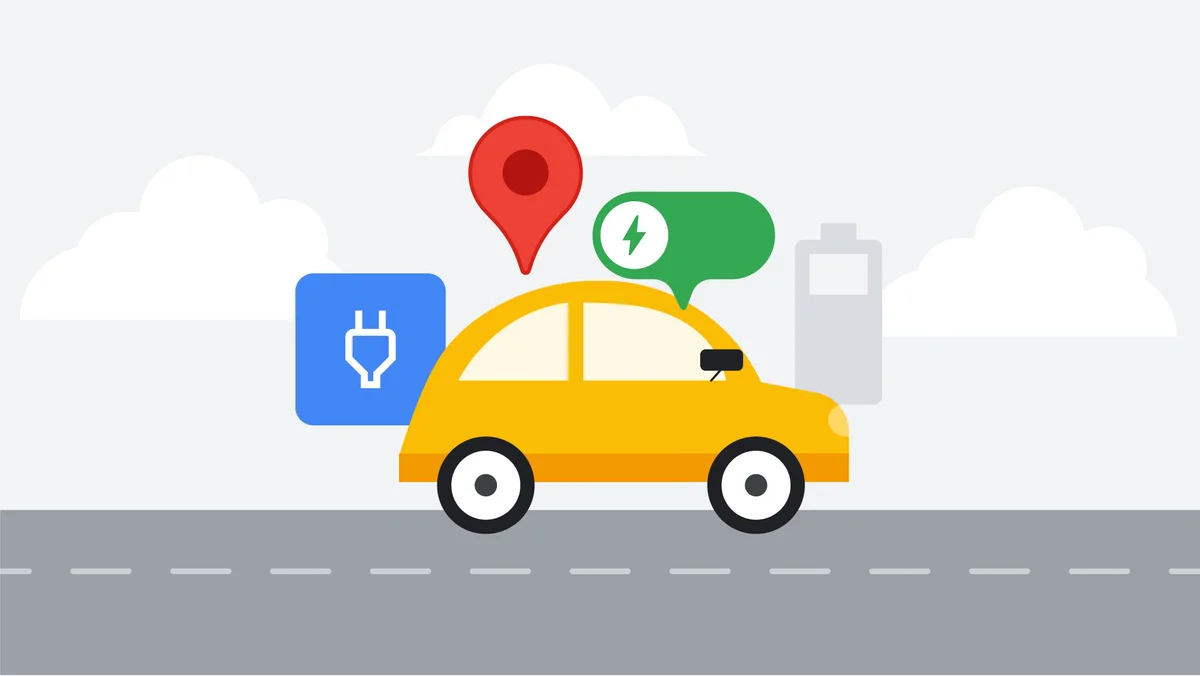
Electric vehicle ownership is on the rise, which means more people are looking for ways to charge their car — whether they’re on the go or planning their drive. To help EV owners access more helpful information about charging stations, we’re rolling out new features for Google Maps and Search. With these updates you can easily find specific information about the location of EV chargers, plan charging stops for road trips and more.
Easily find exactly where charging stations are located
Navigating to charging stations and finding exactly where the chargers are located — like the right area of a multilevel parking lot — can be tricky. In the coming months, we’ll start showing AI-powered summaries in Google Maps that describe a charger’s specific location based on helpful information from user reviews, so you can find exactly where to go. For example, when you’re headed to a charging station you may see a detailed description, like “Enter the underground parking lot and follow the signs toward the exit. Just before exiting, turn right.”

This information is possible thanks to the millions of reviews posted every day in Maps, which help provide accurate and up-to-date information about places like charging stations. To help make these even more useful, reviews about chargers now prompt you for additional details about your experience, like what type of plug you used and how long you waited.

Find the best charger for you while you're on the go
We’re also thinking about other ways we can give people helpful EV charging information at a glance. For example, if you’re low on charge while on the road or you need to top off while running errands, soon you’ll be able to see nearby chargers on the in-car map, with information like real-time port availability and charging speed. This update will roll out globally, starting with vehicles with Google built-in the coming months.

See suggested charging stops, forecasted energy consumption and more when you plan a trip
In addition to showing you where chargers are at a glance, we want to help you take more complex trips easily. Last year we announced that Maps suggests the best charging locations for vehicles with Google built-in. This capability is expanding to multi-stop trips. So if you're planning a multi-stop summer road trip to several national parks, Maps will suggest the best charging stops along the way, based on your battery’s charge level. This feature will be available globally in the coming months for vehicles with Google built-in.

And if you’re planning overnight stays, we’ve got you covered, because the last thing you want to do after a long day of driving is hunt around for a charging station. With our new EV filter on google.com/travel you can find hotels on Search that offer onsite EV charging.
Whether you’re planning a summer road trip or looking for a last-minute charge, Maps and Search can help you find the charging information you need.
Related stories
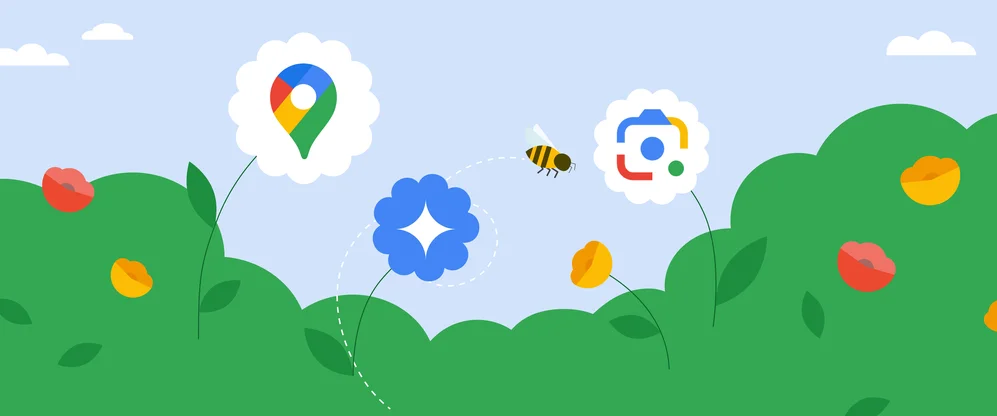
5 AI-powered tools to help you get outside more

How Chromebooks can support your school's Earth Day goals
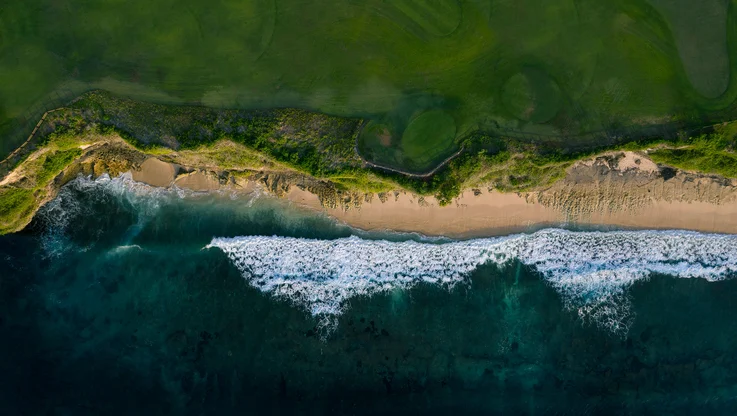
Earth Week 2024: How we’re working with climate startups on sustainability

Find more sustainable ways to get around, with new Maps and Search updates
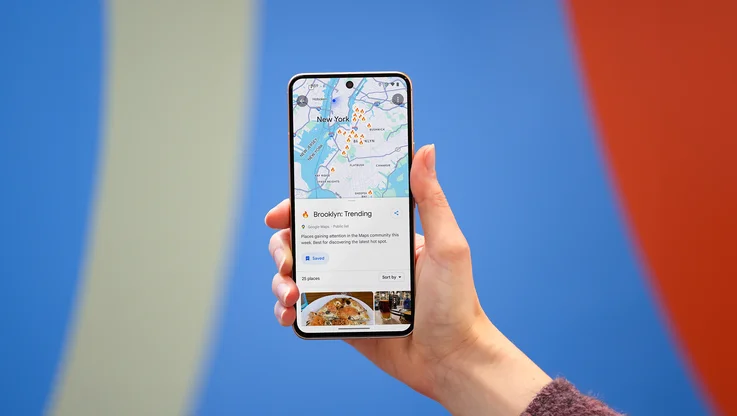
3 Maps updates to make summer travel a breeze

6 ways to travel smarter this summer using Google tools
Let’s stay in touch. Get the latest news from Google in your inbox.
- Help Center
- Google Maps
- Privacy Policy
- Terms of Service
- Submit feedback
Download areas & navigate offline
You can save an area from Google Maps to your phone or tablet and use it when you're offline.
Tip: You’re unable to download offline maps in some countries or regions because of contractual limitations, language support, address formats, or other reasons.
Step 1: Download a map to use offline
Tip: You can save maps on your device or a SD card. If you change the way you save maps, you’ll have to download the map again.
- Make sure you're connected to the internet and signed in to Google Maps .
- Search for a place, like San Francisco .
Save offline maps on an SD card
- On your Android phone or tablet, insert an SD card.
Step 2 (optional): Save battery & mobile data
You can set up offline maps and still use other apps with mobile data.
Select your own map
- Tap Select your own map .
- Adjust the map according to the area you want to download
- Tap Download.
Use offline maps
After you download an area, use the Google Maps app just like you normally would. If your internet connection is slow or absent, your offline maps will guide you to your destination as long as the entire route is within the offline map.
- Get directions & show routes
- Use navigation
- Search for locations
Tip: Transit, bicycling, or walking directions are unavailable offline. In your offline driving directions, you can’t get traffic info or alternate routes.
Manage offline maps
You can select your own map to download, or view maps you've already downloaded.
- Tap the Map you want to delete.
- Tap Delete .
- Select a Map.
- Update the Map name and tap Save .
Offline maps that you downloaded on your phone or tablet must be updated before they expire. When your offline maps expire in 15 days or less, Google Maps tries to update the area automatically when you're connected to Wi-Fi.
If your offline maps aren’t automatically updated, you can update them by following the steps below.
From the notification
- In the "Update offline maps" notification, tap Update now.
- Tap the expired or expiring area on the list.
- Tap Update .
From anywhere else
- On the list, tap the expired or expiring area.
Turn on automatic updates
- Turn on Auto-update offline maps .
Was this helpful?
Need more help, try these next steps:.
Download Now

Hidden Google Maps features to save you time and money
H ave an older car? You don’t want to shell out for a brand-new one - especially not in this economy. Here are 10 upgrades to revamp your ride .
It’s getting warmer, and you’re probably itching to hit the road. With gas prices still high, who doesn’t want to save money? And while you’re at it, getting to your destination faster would be nice, wouldn’t it?
Here’s how Google Maps eases your burdens on the open road.
1. Plan ahead and save on gas
The longer you spend in traffic, the more gas you’ll burn. Google Maps helps you plan a future trip, taking in predicted traffic, routes and road conditions along the way.
Here’s how to set a planned time and date for a trip:
- Open Google Maps and tap on the Search here field.
- Enter a destination and select it from the results.
- Tap Directions and then the three dots button to the right of the Your location field.
- Tap Set depart or arrive time .
- Select Depart at and enter a date and time, then tap Done .
- You’ll get various route options and details such as time and distance.
- Select a route and tap Start .
2. Find cheaper gas
Quickly check gas prices in any area with Google Maps:
- Open Googe Maps and tap Gas under the search bar.
- You’ll see nearby gas stations and prices on the map and at the bottom of the screen.
- Swipe your finger along the map or bottom of the screen to see more.
- Tap Show list to see the gas stations in list form.
3. Find a place to charge your electric vehicle
Use Google Maps to find electric vehicle (EV) charging stations on the way to your destination, along with estimated wait times for a charging port. You can also filter your search by connector type to find stations compatible with your vehicle. Here’s how to get juiced up:
- Open Google Maps and scroll through the tabs on the top of the map and tap More .
- Scroll down to the Services section and select Electric vehicle charging .
- You’ll get a list of nearby charging stations.
- Tap a charging station to add it as a stop along your trip.
4. Reserve your seat for dinner
Grab a spot at your favorite restaurant without calling or navigating to its website. Here’s how:
- Open Google Maps and tap Restaurants at the top of the map to see a list of eateries, or search for the restaurant you want to visit.
- Select a restaurant and reserve a table or join a waitlist if the option is offered.
5. Avoid the mob
Whether you’re sightseeing or stopping for gas, wouldn’t it be nice to know how crowded an area is before going? Check it out with Google Maps.
When you open the app, Google Maps highlights when an area is near its busiest. Tapping on the Busy area label will bring up a chart that shows how busy the area is at different times of day, along with a directory of restaurants, shops, and recreational places (like a museum) within it.
NOTE : You may have to zoom in on an area to find busyness information.
6. Avoid roaming and data fees
If you know you’re heading into an area with poor signal or long stretches of lonely roads, you can download an area map ahead of time. Think national parks or mountainous regions. Even an overcast sky messes with your GPS.
Luckily, Google Maps can be used offline. Do this before you embark on your journey, and you’ll still get the guidance, even if the service is spotty or nonexistent.
- Make sure you’re connected to the internet and not in Incognito mode.
- Open the Google Maps app.
- Search for your destination, a city or a landmark.
- Tap the name or address of the place at the bottom of your screen, then tap the three dots .
- Select Download offline map > Download .
After downloading an area, use the Google Maps app like you normally would.
7. Avoid tolls
Paying small tolls may seem like nothing but it adds up over time. Plus, some tolls run pretty high, depending on where you live. Fortunately, Google Maps gives the option of avoiding toll roads when requesting driving directions.
After plugging in your destination, tap the three dots at the top of your screen. Select Options and then toggle on Avoid tolls .
Bonus: Send an alert if you’re running late
When you’re running late, take a moment to let family and friends know when you’ll be with them by sharing your route. Here’s how to share your ETA with Google Maps:
- Open Google Maps and tap Directions , choose your destination, then Start .
- Swipe up and select Share trip progress .
- Choose a contact and tap Share . Your location is shared only until you arrive.

Google unveils new updates to make trip planning easier for travelers
Google Maps is launching new updates that are intended to make finding travel inspiration and local recommendations in your destination easier. Users will start seeing these lists of suggestions popping up in Google Maps in more than 40 cities across the U.S. and Canada this week. These updates will also be rolled out globally on Android and iOS mobile platforms later this month.
With this trio of updates, users can discover curated lists of local recommendations from other users and esteemed websites, customize their own lists and access key insights, making vacation planning a breeze and ensuring a seamless on-the-go experience. To access the new features, simply search for a city in Google Maps and and swipe up to see curated lists of places from people who know the city inside and out. You’ll also see lists from such reputable sources as Lonely Planet, the New York Times and OpenTable.
And, when away from home, the question of where to eat is always top of mind. Now, whether you’re a traveler or just want to find a trendy spot in town, you can use new restaurant lists created by Google Maps. These lists will spotlight the eateries people are showing interest in or rating highly on Maps at the time. Google has sorted restaurants into three separate lists based on various criteria, creating indices for trending, top-rated, and hidden gem locations.
The Trending list is updated weekly to spotlight places that experienced a recent spike in popularity on Maps, making it ideal for discovering the latest hot spots.
The Top list showcases the places that the Maps community has consistently shown love for. Use this list to find a neighborhood’s longstanding favorites.
The Gems list is for places that are considered an area's best-kept secrets, highlighting great restaurants that still fly under the radar.
Creating Maps lists allows you to organize places you’d like to visit and places you’ve already been that you might wish to revisit. With the new lists format, users will also be able to more easily arrange their selections for easy reference, as they can now choose the order in which places appear. Simply move them up or down in whatever order you prefer to have them displayed. Users can also link in content from their social media streams, such as their own reviews of a certain venue.
Similarly, to give users a good sense of each place at a glance, Google’s AI pulls key insights to display from the Maps community. When you search a spot, you’ll see select photos and reviews that encapsulate what patrons love about it. The AI function can even help you identify the name of a particular dish and display helpful information based on a restaurant’s menu.
New design updates are also set to give Google Maps a fresh look, including a simplified home screen and new pin colors that make places on the map easier to find.
Trip-planning AI
Google has also just announced an update that’s coming to its Search Generative Experience (SGE), which will enable users to create travel itineraries and compile trip ideas using AI. This means that Google will be taking on other companies that are already applying the generative AI’s capabilities to help travelers plan their trips, such as Mindtrip and Layla.
To come up with its travel recommendations, Google’s AI engine relies upon information from sites across the internet, as well as photos, reviews and other specifics users have submitted about any given place. Conversationally, users can ask the AI something like “plan me a five-day trip to New York City that focuses on entertainment” and receive a sample itinerary that includes local restaurants, attractions and points of interest. Once you’ve constructed your ideal itinerary, you can export it to Gmail, or Google Docs or Maps.
This new capability is currently available only in the U.S. (in English) to those who are signed up for Google’s Search Labs program, which invites users to experiment with early-phase Google Search functions. The company has not stated if or when this function will become more widely available. According to TechCrunch, Google is not only testing out new realms for using generative AI, it’s also gathering data about consumers’ travel purchasing intent, which would support its wider ad business.
More From Forbes
Google announces new features for travel.
- Share to Facebook
- Share to Twitter
- Share to Linkedin
Google has announced several new features for Google Maps and Google Search aimed at helping people find less carbon-intensive ways of traveling and commuting.
One of the key additions is a new EV filter on google.com/travel, enabling users to locate hotels that offer onsite EV charging facilities. Additionally, numerous updates have been made on Maps to facilitate the discovery of charging stations.
When planning a trip, users will now have access to suggested charging stops, forecasted energy consumption, and more.
Google Map EV Charger Stations Updates
Furthermore, in addition to the EV updates, Google Maps will now assist users in finding lower-carbon travel alternatives.
Highlights from Googles Press Release: More sustainable ways to commute & travel:
- Driving alternatives in Google Maps: When people look up driving directions, we’ll soon show a public transit or a walking suggestion next to driving routes, if travel times are comparable and practical (coming to 15+ cities).
- Trains & buses in Google Search: You can now see train schedules & ticket prices directly in Search, for rail travel in 38 countries around the world (including the US), as well as long-distance buses in 15 countries. This is an expansion of an existing feature.
- Train suggestions on Google Flights: In the months ahead, when you’re on Google Flights and there’s a reasonable rail alternative, you’ll see train route suggestions in the flight search results. This builds on similar suggestions we already show in Google Search for flight queries.
- Travel Impact Model: You can already see estimated emissions in Google Flights, powered by our Travel Impact Model methodology. Now, estimates from the Travel Impact Model are also available through a developer API , a Google Sheets extension and a calculator on the TIM website .
Electric vehicles:
- Google Maps (all features coming soon):
- EV Charging Station Pins: We’ll highlight nearby EV charging stations for in-car Maps, with information about station availability and charging speeds.
- AI-powered summaries for EV charging stations: AI summaries from user reviews will better help users pinpoint charging stations.
- Multi-waypoint EV trip planning: When users create a multi-stop trip, in-car Maps will suggest required charging stops.
- Google Search - Hotels:
- You can use the new EV filter on google.com/travel to find hotels that offer on-site EV charging. This is already live.
Samsung Is Giving Away A Free Galaxy S24 In A New Promotion
Nfl draft here s how much second and third round picks will make in rookie contracts, the fallout 4 next gen update is not going great.
- Editorial Standards
- Reprints & Permissions
- Aruba Tourism
- Aruba Hotels
- Aruba Bed and Breakfast
- Aruba Vacation Rentals
- Flights to Aruba
- Aruba Restaurants
- Things to Do in Aruba
- Aruba Travel Forum
- Aruba Photos
- All Aruba Hotels
- Aruba Hotel Deals
- Last Minute Hotels in Aruba
- Things to Do
- Restaurants
- Vacation Rentals
- Travel Stories
- Rental Cars
- Add a Place
- Travel Forum
- Travelers' Choice
- Help Center
Street/road signs? - Aruba Forum
- Caribbean
- Aruba
Street/road signs?
- United States Forums
- Europe Forums
- Canada Forums
- Asia Forums
- Central America Forums
- Africa Forums
- Caribbean Forums
- Mexico Forums
- South Pacific Forums
- South America Forums
- Middle East Forums
- Honeymoons and Romance
- Business Travel
- Train Travel
- Traveling With Disabilities
- Tripadvisor Support
- Solo Travel
- Bargain Travel
- Timeshares / Vacation Rentals
- Caribbean forums
- Aruba forum

11 replies to this topic

Funny, I never really noticed if there were street signs or not. All flavors of GPS that we've used over the years, hasn't gotten us lost yet, even when off the beaten path. I guess that's one of the benefits of being a small island, easy mapping!

I’d say signs aren’t great, especially off the beaten path. I don’t have data (wifi only) when I’m on the island so and have really come to like maps.me (offline maps).
Just download before you leave. I use it constantly finding new places I’ve never been and never had an issue.
For a more comprehensive understanding of the traffic rules on the island you can reference the link below. You will also find information regarding road signs. Enjoy your trip!
https://www.visitaruba.com/getting-around/driving-in-aruba/
Street signs....maybe in town but everywhere else is hit and miss.
Street signs -- not so many
Something that we have gotten used to.
Small island but you can get lost outside of the town proper.
Try maps.me

Most important at roundabouts/rotaries........the vehicles already in the rotary have the right of way. some of the rotaries have curbing and have 2 lanes so please make sure you know which lane you should be in,
Red lights....there are few, but no right on red!
Many streets do not have signs with street names, especially in the neighborhoods inland.
Thanks, all!
Just remember when in doubt on a roundabout, just go around one more time and you'll be fine.
Sean and Susan
That's fine for a single-lane roundabout, but when there are 2 lanes and the left one is for going left or straight only, you can't go around again if you're stuck in the right lane. But thanks!
- car rental/insurance 7:26 pm
- first time going to aruba 1:44 pm
- Quinta Del Carmen Seating 1:43 pm
- La Cabana renovation question 12:17 pm
- Aruba hostess 11:39 am
- King's Day April 27 9:26 am
- Flying fish vs barefoot 8:59 am
- connection through JFK on Jetblue returning from Aruba 8:53 am
- Is aruba dine around voucher worth it? 8:21 am
- Aruba villa rental 8:05 am
- Itinerary feedback?! yesterday
- Bringing food into Aruba yesterday
- Cadushi yesterday
- Riu party yesterday
- Construction of Ritz Carlton next to Marriott 25 replies
- Anyone been to Aruba in August? 9 replies
- Aruba in September? 9 replies
- Aruba weather in November?? 13 replies
- Topless/Nude Sunbathing 13 replies
- Aruba vs. Bahamas 16 replies
- Punta Cana or Aruba? 15 replies
- Is Aruba safe? 8 replies
- MCM Tours, aruba4u.com, Players Choice, Thanks for the tip 5 replies
- Aruba weather in July 4 replies
Aruba Hotels and Places to Stay
- All Inclusive vs. Non All Inclusive
- Car Rental vs. Taxi
- Airport Shuttle Transfer or Taxi to Hotel?
- Which Snorkel Excursion?
- Snorkeling in Aruba from the Beach
- What Are the Top Activities in Aruba?
- Why is there a 15% service charge on my restaurant bill?
- Where to find local Aruban cuisine?
- Where Do Locals Go to Eat?
- Beach day in Aruba from a Cruise Ship?
- Options for Cell Phones in Aruba
- One Day in Aruba from a Cruise Ship?
- Is There Shopping In Aruba?
- Aruba or Another Caribbean Island?
- The Divi & Tamarijn All Inclusive Resorts vs. The Riu Palace
- Suggestions for Happy Hours
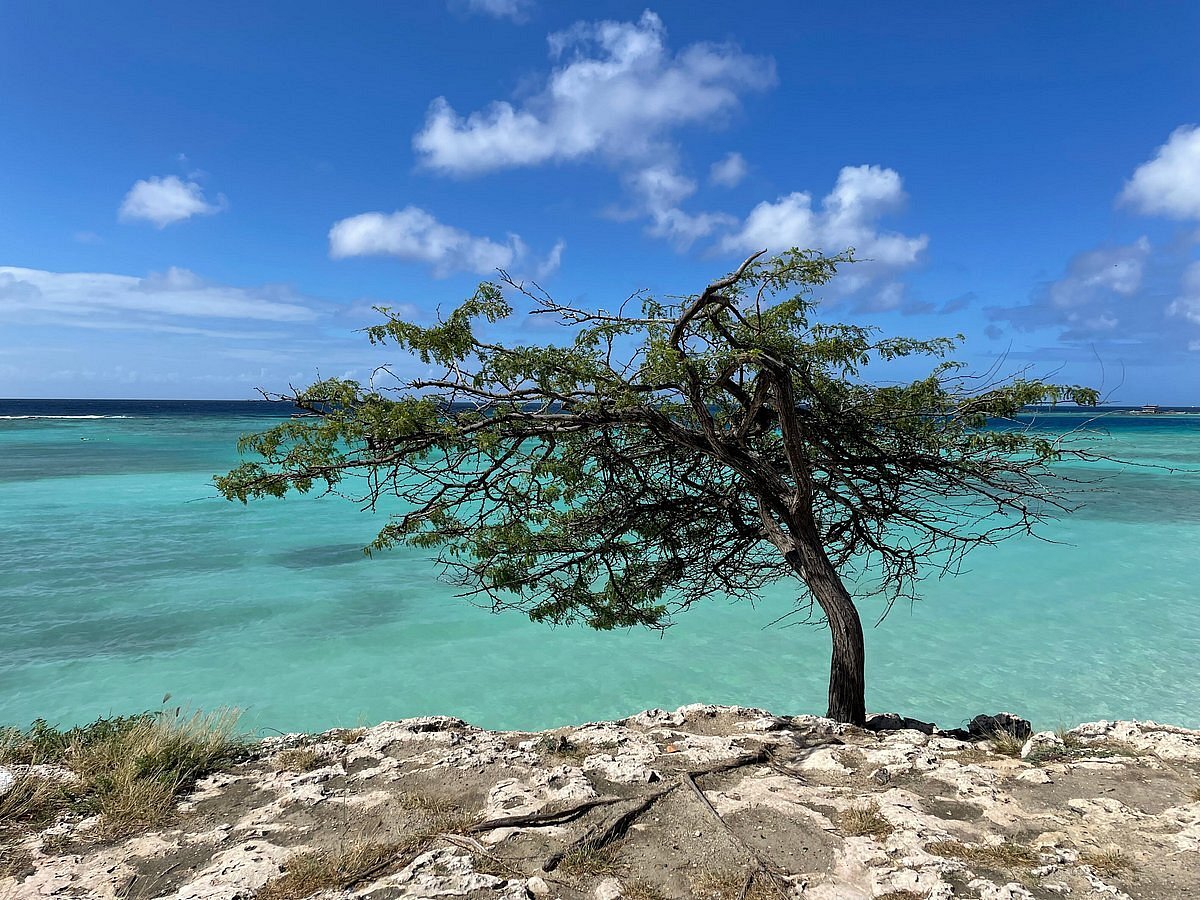

IMAGES
VIDEO
COMMENTS
To do so, open Google Maps and search for the directions you want to save. On the directions screen, in the top-right corner, tap the three dots. In the three-dots menu, tap "Add Route to Home Screen." In the "Add to Home Screen" box, either drag the widget and place it on one of your home screens, or tap "Add Automatically" to add the widget ...
Once your route is ready, open the Google Maps app, and tap "Saved" at the bottom. Next, press "Maps" and select the map you've created. Now you can press on one of the destinations and then "Direction" to access information on how you can get there. You'll need to manually input your "Start location" though.
1. Open Google Maps and bring up the route that you want to save. 2. On the same screen where you can pin the route, instead tap the three dots next to the starting location. 3. Select Add route ...
Step 1: Create a New Google Map. You will need to sign in to your Google Account or create a new account to create your own Google My Map. Once you're logged into Google, follow this link to bring you to Google Maps. Click on the hamburger ( 𝄘 ) in the top left-hand corner of Google Maps. Click on "Your Places".
To save Google Maps routes for a long trip, follow these steps: Open your web browser and visit Google My Maps . Click Create a New Map and give it a name. You can also add a description. Next, click the Add directions icon at the top (it's shaped like an arrow indicating a turn).
Tap on Pin on the bottom toolbar. You can also save the destination. To do this, type in the direction in the search bar and tap on Save on the bottom toolbar. Google Maps will ask you whether you ...
Post summary: A comprehensive guide on how to use Google Maps to plan a road trip itinerary and why Google Maps is the best tool/app for planning a trip.Includes a road trip planning tutorial! Author's Note: This post was originally published in 2020 and was updated in April 2023 for accuracy and comprehensiveness.
Eager to remember and access a specific route on Google Maps later? This tutorial provides a detailed guide on how to save routes within the Google Maps app....
To save a Google Maps route to the Android home screen: Open Google Maps and search for the destination you want to save. On the directions screen, tap the three-dot menu button in the top right ...
READ MORE: 10 Ways to Save Money on Gas on Your Next Road Trip This helps visualize a road trip, place destinations in the correct order, and make sense of the grand scale of the road trip. After creating a customized map, users can open it in Google Maps on any mobile device, plug into a compatible vehicle, and let the road trip adventure begin.
On your computer, open Google Maps. Click Directions . Add a starting point and a destination. On the left, below the destinations you entered, click Add . To add a stop, choose another destination. You can add up to 9 stops. Click on a route to get the directions. Tip: You can search for places along your route.
First, open up your browser and head on over to Google Maps. Click the "Directions" button to the right of the search bar. By default, Maps will use your device's location for the starting point. If you want this to be a different location, enter it now. Next, enter the location of your first destination into the field provided, and then hit Enter.
On your computer, open Google Maps. Make sure you're signed in. On the left, choose an option: Get directions to relevant places: Click a place in the list. You'll get places based on your Gmail, Calendar, and recent travel history. Get directions to saved places: If you saved your work or home address in your Google Account, click Home or ...
On your computer, sign in to My Maps. Open or create a map. Click Add directions . In the box on the left, type your start and end locations. The route appears on your map. Add another leg to your trip: Click Add destination. Change how you get there: Below the layer name, click Driving, Bicycling, or Walking.
Step 2: Adding attractions, hotels and restaurants to the custom Google Map for the road trip. Continuing from Step 1, you can use the search bar to add attractions and sites that you are interested in adding to your itinerary. As I mentioned before, I use Pinterest, and other search and photo platforms for inspiration.
From the dropdown menu, select the "Save trip" option. You will be prompted to provide a name for your trip. Enter a descriptive title that helps you easily identify the itinerary. Click on the "Save" button. Once you save your trip, it will be added to your list of saved trips in Google Maps.
1. Open Google Maps and click, tap, or search for the location that you want to save. 2. Find the Save icon, which has the icon of a bookmark. You'll find it right under the location's name, but ...
Step 1: Plan your route. The first step in setting up your road trip on Google Maps is to plan your route. Start by opening Google Maps on your computer or mobile device and entering your starting point and destination in the search bar. You can simply type in the addresses or landmarks, or even use the voice search option for convenience.
Step 1: Open Google Maps. The first step in setting a trip on Google Maps is to open the app on your device. If you're using a computer, navigate to the Google Maps website in your preferred web browser. Once you have the app or website open, you're ready to begin planning your trip.
Make maps. Easily create custom maps with the places that matter to you. Add points or draw shapes anywhere. Find places and save them to your map. Instantly make maps from spreadsheets. Show your ...
Find local businesses, view maps and get driving directions in Google Maps.
Trip Planner is a Google My Maps project that helps you plan your trips and share them with others. You can customize your map with markers, routes, photos, and descriptions of your destinations ...
The Maps update will allow EV owners with Google Built-in to plan where they can power up when taking long trips with multiple stops, such as a cross-country road trip. The feature will access ...
Last year we announced that Maps suggests the best charging locations for vehicles with Google built-in. This capability is expanding to multi-stop trips. So if you're planning a multi-stop summer road trip to several national parks, Maps will suggest the best charging stops along the way, based on your battery's charge level.
On your Android phone or tablet, open the Google Maps app . Make sure you're connected to the internet and signed in to Google Maps. Search for a place, like San Francisco. At the bottom, tap the name or address of the place tap More Download offline map. If you searched for a place like a restaurant, tap More Download offline map Download.
Here's how Google Maps eases your burdens on the open road. 1. Plan ahead and save on gas. The longer you spend in traffic, the more gas you'll burn. Google Maps helps you plan a future trip ...
New design updates are also set to give Google Maps a fresh look, including a simplified home screen and new pin colors that make places on the map easier to find. Trip-planning AI. Google has ...
More sustainable ways to commute & travel: Driving alternatives in Google Maps: When people look up driving directions, we'll soon show a public transit or a walking s...
As a personal preference I utilize the application Maps.Me and it works well along with Google Maps. Just download the Aruba Map region and they both will work fine offline. For a more comprehensive understanding of the traffic rules on the island you can reference the link below. You will also find information regarding road signs. Enjoy your ...